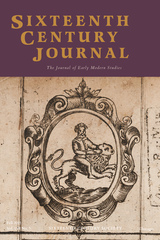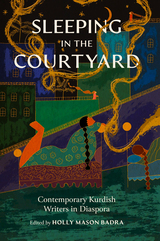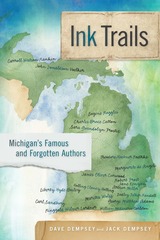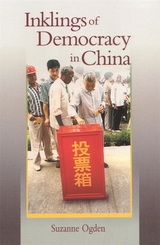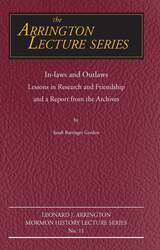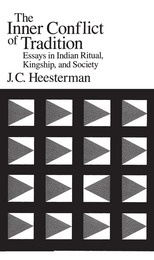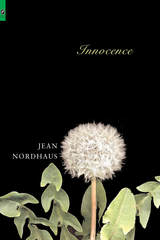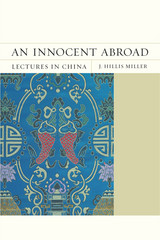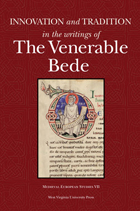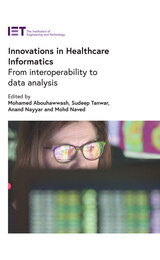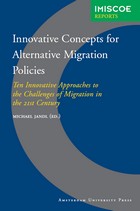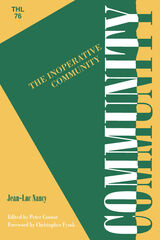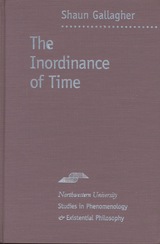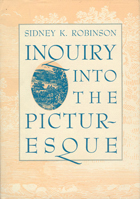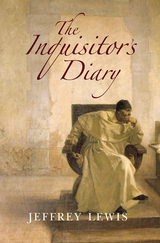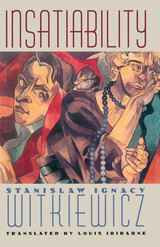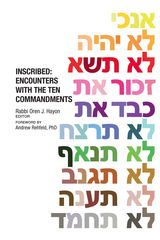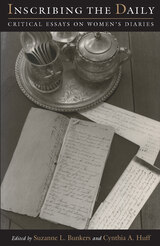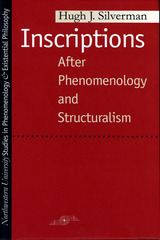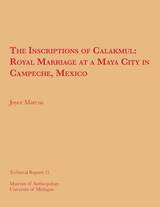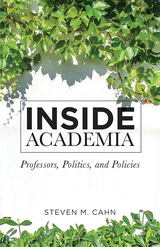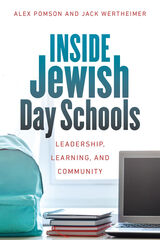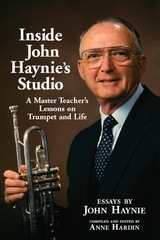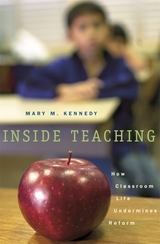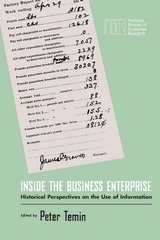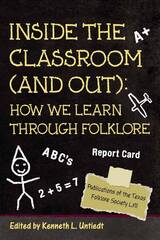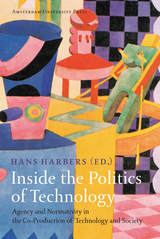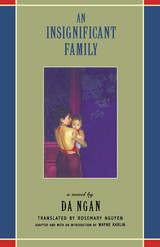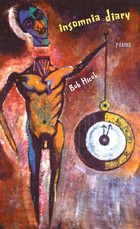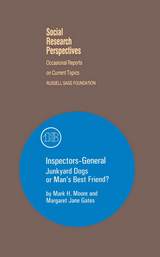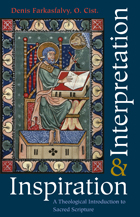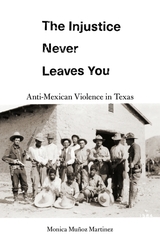 The Injustice Never Leaves You: Anti-Mexican Violence in Texas
Monica Muñoz Martinez
Harvard University Press, 2020 Winner of the Caughey Western History Prize
Winner of the Robert G. Athearn Award
Winner of the Lawrence W. Levine Award
Winner of the TCU Texas Book Award
Winner of the NACCS Tejas Foco Nonfiction Book Award
Winner of the María Elena Martínez Prize
Frederick Jackson Turner Award Finalist
“A page-turner…Haunting…Bravely and convincingly urges us to think differently about Texas’s past.”
—Texas Monthly
Between 1910 and 1920, self-appointed protectors of the Texas–Mexico border—including members of the famed Texas Rangers—murdered hundreds of ethnic Mexicans living in Texas, many of whom were American citizens. Operating in remote rural areas, officers and vigilantes knew they could hang, shoot, burn, and beat victims to death without scrutiny. A culture of impunity prevailed. The abuses were so pervasive that in 1919 the Texas legislature investigated the charges and uncovered a clear pattern of state crime. Records of the proceedings were soon filed away as the Ranger myth flourished.
A groundbreaking work of historical reconstruction, The Injustice Never Leaves You has upended Texas’s sense of its own history. A timely reminder of the dark side of American justice, it is a riveting story of race, power, and prejudice on the border.
“It’s an apt moment for this book’s hard lessons…to go mainstream.”
—Texas Observer
“A reminder that government brutality on the border is nothing new.”
—Los Angeles Review of Books
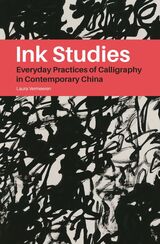 Ink Studies: Everyday Practices of Calligraphy in Contemporary China
Laura Vermeeren
National University of Singapore Press, 2025 In a world where writing by hand is disappearing, Laura Vermeeren studies why calligraphy in China is not just surviving, but evolving in surprising ways.
As handwriting fades in the digital age, calligraphy in China is caught between tradition and reinvention. Ink Studies deconstructs this paradox, determining how calligraphy is not simply an ancient art form, but more so a site of ongoing cultural negotiation. Laura Vermeeren investigates how calligraphy moves through five distinct visual and social fields, shaping and being shaped by its practitioners. While often framed as an act of repetition and tied to centuries of disciplined copying, calligraphy also emerges here as a force of creativity—one that is actively mobilized in contemporary China, whether through state-sponsored initiatives or the aesthetics of modern design.
Uniting contemporary art and media history, Ink Studies provides vital perspectives on how China’s past is continually reimagined in the present, portraying calligraphy’s enduring relevance in an era of rapid technological change.
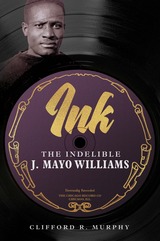 Ink: The Indelible J. Mayo Williams
Clifford R. Murphy
University of Illinois Press, 2024 <p>The product of a hardscrabble childhood, J. Mayo “Ink” Williams parlayed an Ivy League education into unlikely twin careers as a foundational producer of Black music and pioneering Black player in the early NFL. Clifford R. Murphy tells the story of an ambitious, upwardly mobile life affected, but never daunted, by white society’s racism or the Black community’s class tensions. Williams caroused with Paul Robeson, recorded the likes of Ma Rainey and Blind Lemon Jefferson, and lined up against Chicago Bears player-coach George Halas. Though resented by the artists he exploited, Williams combined a rock-solid instinct for what would sell with an ear for music that put him at the forefront of finding, recording, and blending blues and jazz. Murphy charts Williams’s wide-ranging accomplishments while providing portraits of the cutthroat recording industry and the possibilities, however constrained, of Black life in the 1920s and 1930s.</p>
<p>Vivid and engaging, <i>Ink</i> brings to light the extraordinary journey of a Black businessman and athlete.</p>
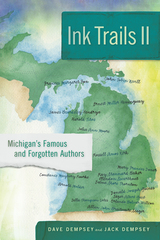 Ink Trails II: Michigan's Famous and Forgotten Authors
Dave Dempsey
Michigan State University Press, 2016 From authors of bodice rippers and gallant figures to hometown poetry, hearty men, and tales of American originals, the history of literature in Michigan is deep and rich. The Wolverine State has been the birthplace, home, and inspiration to a tremendous number of men and women of letters, both the well-known and the obscure. Ink Trails II tells the stories of these fascinating and diverse writers whose talent is inextricably linked to Michigan.
Exploring the hidden treasures of otherwise forgotten authors while also acknowledging the Michigan-set stories of giants like Hemingway, Dave and Jack Dempsey delve into the state’s literary heritage, as robust, diverse, and inexhaustible as the natural beauty of the place that nurtured it. This second volume of “ink trails” continues to tell the story of the remarkable writers, powerful words, and sublime nature of Michigan in the same well-researched and entertaining prose as the first.
Ink Trails: Michigan's Famous and Forgotten Authors
Dave Dempsey
Michigan State University Press, 2012 Long revered as the birthplace of many of the nation’s best-known authors, Michigan has also served as inspiration to countless others. In this entertaining and well-researched book—the first of its kind—the secrets, legends, and myths surrounding some of Michigan’s literary luminaries are explored. Which Michigan poet inspired a state law requiring teachers to assign at least one of his compositions to all students? Which young author emerged from the University of Michigan with a bestselling novel derided by some critics as “vulgar”? And from what Michigan city did Arthur Miller, Robert Frost, and Jane Kenyon draw vital inspiration? The answers to these questions and more are revealed in this rich literary history that highlights the diversity of those whose impact on letters has been indelible and distinctly Michiganian.
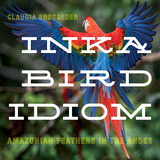 Inka Bird Idiom: Amazonian Feathers in the Andes
Brosseder, Claudia
University of Pittsburgh Press, 2023 How Indigenous People Used Feathers as a Significant Way of Symbolic Communication in the Andes
From majestic Amazonian macaws and highland Andean hawks to tiny colorful tanagers and tall flamingos, birds and their feathers played an important role in the Inka empire. Claudia Brosseder uncovers the many meanings that Inkas attached to the diverse fowl of the Amazon, the eastern Andean foothills, and the highlands. She shows how birds and feathers shaped Inka politics, launched wars, and initiated peace. Feathers provided protection against unpredictable enemies, made possible communication with deities, and brought an imagined Inka past into a political present. Richly textured contexts of feathered objects recovered from Late Horizon archaeological records and from sixteenth- and seventeenth-century accounts written by Spanish interlocutors enable new insights into Inka visions of interspecies relationships, an Inka ontology, and Inka views of the place of the human in their ecology. Inka Bird Idiom invites reconsideration of the deep intellectual ties that connected the Amazon and the mountain forests with the Andean highlands and the Pacific coast.
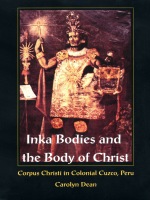 Inka Bodies and the Body of Christ: Corpus Christi in Colonial Cuzco, Peru
Carolyn Dean
Duke University Press, 1999 In Inka Bodies and the Body of Christ Carolyn Dean investigates the multiple meanings of the Roman Catholic feast of Corpus Christi as it was performed in the Andean city of Cuzco after the Spanish conquest. By concentrating on the era’s paintings and its historical archives, Dean explores how the festival celebrated the victory of the Christian God over sin and death, the triumph of Christian orthodoxy over the imperial Inka patron (the Sun), and Spain’s conquest of Peruvian society.
As Dean clearly illustrates, the central rite of the festival—the taking of the Eucharist—symbolized both the acceptance of Christ and the power of the colonizers over the colonized. The most remarkable of Andean celebrants were those who appeared costumed as the vanquished Inka kings of Peru’s pagan past. Despite the subjugation of the indigenous population, Dean shows how these and other Andean nobles used the occasion of Corpus Christi as an opportunity to construct new identities through tinkuy, a native term used to describe the conjoining of opposites. By mediating the chasms between the Andean region and Europe, pagans and Christians, and the past and the present, these Andean elites negotiated a new sense of themselves. Dean moves beyond the colonial period to examine how these hybrid forms of Inka identity are still evident in the festive life of modern Cuzco.
Inka Bodies and the Body of Christ offers the first in-depth analysis of the culture and paintings of colonial Cuzco. This volume will be welcomed by historians of Peruvian culture, art, and politics. It will also interest those engaged in performance studies, religion, and postcolonial and Latin American studies.
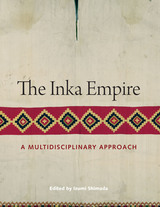 The Inka Empire: A Multidisciplinary Approach
Edited by Izumi Shimada
University of Texas Press, 2015 Massive yet elegantly executed masonry architecture and andenes (agricultural terraces) set against majestic and seemingly boundless Andean landscapes, roads built in defiance of rugged terrains, and fine textiles with orderly geometric designs—all were created within the largest political system in the ancient New World, a system headed, paradoxically, by a single, small minority group without wheeled vehicles, markets, or a writing system, the Inka. For some 130 years (ca. A.D. 1400 to 1533), the Inka ruled over at least eighty-six ethnic groups in an empire that encompassed about 2 million square kilometers, from the northernmost region of the Ecuador–Colombia border to northwest Argentina. The Inka Empire brings together leading international scholars from many complementary disciplines, including human genetics, linguistics, textile and architectural studies, ethnohistory, and archaeology, to present a state-of-the-art, holistic, and in-depth vision of the Inkas. The contributors provide the latest data and understandings of the political, demographic, and linguistic evolution of the Inkas, from the formative era prior to their political ascendancy to their post-conquest transformation. The scholars also offer an updated vision of the unity, diversity, and essence of the material, organizational, and symbolic-ideological features of the Inka Empire. As a whole, The Inka Empire demonstrates the necessity and value of a multidisciplinary approach that incorporates the insights of fields beyond archaeology and ethnohistory. And with essays by scholars from seven countries, it reflects the cosmopolitanism that has characterized Inka studies ever since its beginnings in the nineteenth century.
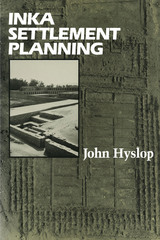 Inka Settlement Planning
By John Hyslop
University of Texas Press, 1990 Before the Spanish conquest in the sixteenth century A.D., the Inka Empire stretched along the Pacific side of South America, all the way from Ecuador to northwest Argentina. Though today many Inka researchers focus on the imperial capital of Cuzco, Peru, and surrounding areas, ruins of Inka settlements abound throughout the vast territory of the former empire and offer many clues about how the empire was organized, managed, and defended. These outlying settlements, as well as those in the Cuzco area, form the basis for John Hyslop's detailed study Inka Settlement Planning. Using extensive aerial photography and detailed site maps, Hyslop studies the design of several dozen settlements spread throughout the empire. In addition to describing their architecture and physical infrastructure, he gives special emphasis to the symbolic aspects of each site's design. Hyslop speculates that the settlement plans incorporate much iconography expressive of Inka ideas about the state, the cosmos, and relationships to non-Inka peoples—iconography perhaps only partially related to the activities that took place within the sites. And he argues that Inka planning concepts applied not only to buildings but also to natural features (stone outcrops, water sources, and horizons) and specialized landscaping (terracing). Of interest to a wide readership in archaeology, architecture, urbanization, empire building, and Andean travel, Inka Settlement Planning charts one of Native America's greatest achievements.
 Inked: Tattooed Soldiers and the Song Empire’s Penal-Military Complex
Elad Alyagon
Harvard University Press, 2023 Inked is a social history of common soldiers of the Song Dynasty, most of whom would have been recognized by their tattooed bodies. Overlooked in the historical record, tattoos were an indelible aspect of the Song world, and their ubiquity was tied to the rise of the penal–military complex, a vast system for social control, warfare, and labor.
Although much has been written about the institutional, strategic, and political aspects of the history of the Song and its military, this book is a first-of-its-kind investigation into the lives of the people who fought for the state. Elad Alyagon examines the army as a meeting place between marginalized social groups and elites. In the process, he shows the military to be a space where a new criminalized lower class was molded in a constant struggle between common soldiers and the agents of the Song state. For the millions of people caught in the orbit of this system—the tattooed soldiers, their families, and their neighbors—the Song period was no age of benevolence, but one of servitude, violence, and resistance. Inked is their story.
Inklings of Democracy in China
Suzanne Ogden
Harvard University Press, 2002 Since 1979 China’s leaders have introduced economic and political reforms that have lessened the state’s hold over the lives of ordinary citizens. By examining the growth in individual rights, the public sphere, democratic processes, and pluralization, the author seeks to answer questions concerning the relevance of liberal democratic ideas for China and the relationship between a democratic political culture and a democratic political system. The author also looks at the contradictory impulses and negative consequences for democracy generated by economic liberalism.
Unresolved issues concerning the relationships among culture, democracy, and socioeconomic development are at the heart of the analysis. Nonideological criteria are used to assess the success of the Chinese approach to building a fair, just, and decent society.
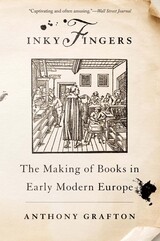 Inky Fingers: The Making of Books in Early Modern Europe
Anthony Grafton
Harvard University Press, 2020 An Open Letters Review Best Book of the Year
“Grafton presents largely unfamiliar material…in a clear, even breezy style…Erudite.”
—Michael Dirda, Washington Post
In this celebration of bookmaking in all its messy and intricate detail, Anthony Grafton captures both the physical and mental labors that went into the golden age of the book—compiling notebooks, copying and correcting proofs, preparing copy—and shows us how scribes and scholars shaped influential treatises and forgeries.
Inky Fingers ranges widely, from the theological polemics of the early days of printing to the pathbreaking works of Jean Mabillon and Baruch Spinoza. Grafton draws new connections between humanistic traditions and intellectual innovations, textual learning and the delicate, arduous, error-riddled craft of making books. Through it all, he reminds us that the life of the mind depends on the work of the hands, and the nitty gritty labor of printmakers has had a profound impact on the history of ideas.
“Describes magnificent achievements, storms of controversy, and sometimes the pure devilment of scholars and printers…Captivating and often amusing.”
—Wall Street Journal
“Ideas, in this vivid telling, emerge not just from minds but from hands, not to mention the biceps that crank a press or heft a ream of paper.”
—New York Review of Books
“Grafton upends idealized understandings of early modern scholarship and blurs distinctions between the physical and mental labor that made the remarkable works of this period possible.”
—Christine Jacobson, Book Post
“Scholarship is a kind of heroism in Grafton’s account, his nine protagonists’ aching backs and tired eyes evidence of their valiant dedication to the pursuit of knowledge.”
—London Review of Books
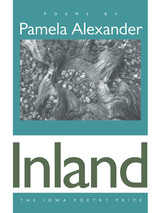 Inland
Pamela Alexander
University of Iowa Press, 1997 Pamela Alexander's poetry is characterized by inventive language, scrupulous accuracy of imagery, and a winning fusion of the comic and the deeply serious. Her subjects vary as widely as her settings, which range from the New Hampshire woods to the Arizona desert. A family life eccentric to the point of chaos, close observations of wildlife, and coastal sailing are among the poet's topics.
Despite this variety, Inland has an emerging organization that suggests a kind of plot. The family is left behind in the way that families of origin always are, revealed fully only in perspective: “foghorns / in the harbor, two different pitches / at different intervals / repeating so often I didn't hear them / and their accidental harmonies / until I'd left town.” Shifting toward the subject of new relationships, in her diatribe against a past (and passing) lover Alexander gives a new twist to the fact that this subject has been fair game for poets for centuries: “...you could say hello, you canoe-footed fur-faced / musk ox, pockets full of cheese and acorns / and live fish and four-headed winds and sky...”
James Merrill, praising Alexander's first book, called it “a wonderful achievement. Her language is now simple, now playful, now extremely poignant.” This is an apt description of Inland as well, a book that shows Alexander in witty yet serious engagement with the world. The longest poem here, “Swallowing the Anchor” (the title is the sailors' term for giving up the sea), is also the most directly personal. It closes the section of the book in which the poet comes to terms with losses, including the death of the loved one. She does this with grace—and her wit is not jokes, her poignancy is not sentimentality.
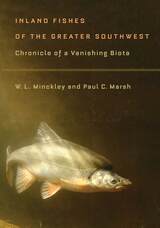 Inland Fishes of the Greater Southwest: Chronicle of a Vanishing Biota
W. L. Minckley and Paul C. Marsh
University of Arizona Press, 2009 This comprehensive new book replaces and substantially expands upon the landmark Fishes of Arizona, which has been the authoritative source since it was first published in 1973. Inland Fishes of the Greater Southwest is a one-volume guide to native and non-native fishes of the lower Colorado River basin, downstream from the Grand Canyon, and of the northern tributaries of the Sea of Cortez in the United States and Mexico. In all, there are in-depth accounts of more than 165 species representing 30 families. The book is not limited to the fish. It provides insights into their aquatic world with information on topography, drainage relations, climate, geology, vegetational history, aquatic habitats, human-made water systems, and conservation. A section of the book is devoted to fish identification, with keys to native and non-native families as well as family keys to species. The book is illustrated with more than 120 black-and-white illustrations, 47 full-color plates of native fishes, and nearly 40 maps and figures.
Many native fish species are unique to the Southwest. They possess interesting and unusual adaptations to the challenges of the region, able to survive silt-laden floods as well as extreme water temperatures and highly fluctuating water flows ranging from very low levels to flash floods. However, in spite of being well-adapted, many of the fish described here are threatened or endangered, often due to the acts of humans who have altered the natural habitat. For that reason, Inland Fishes of the Greater Southwest presents a vast amount of information about the ecological relationships between the fishes it describes and their environments, paying particular attention to the ways in which human interactions have modified aquatic ecosystems—and to how humans might work to ensure the survival of rapidly disappearing native species.
 The Inman Diary: A Public and Private Confession
Arthur C. Inman
Harvard University Press, 1985 Between 1919 and his death by suicide in 1963, Arthur Crew Inman wrote what is surely one of the fullest diaries ever kept by any American. Convinced that his bid for immortality required complete candor, he held nothing back. This abridgment of the original 155 volumes is at once autobiography, social chronicle, and an apologia addressed to unborn readers.
Into this fascinating record Inman poured memories of a privileged Atlanta childhood, disastrous prep-school years, a nervous collapse in college followed by a bizarre life of self-diagnosed invalidism. Confined to a darkened room in his Boston apartment, he lived vicariously: through newspaper advertisements he hired “talkers” to tell him the stories of their lives, and he wove their strange histories into the diary. Young women in particular fascinated him. He studied their moods, bought them clothes, fondled them, and counseled them on their love affairs. His marriage in 1923 to Evelyn Yates, the heroine of the diary, survived a series of melodramatic episodes. While reflecting on national politics, waifs and revolutions, Inman speaks directly about his fears, compulsions, fantasies, and nightmares, coaxing the reader into intimacy with him. Despite his shocking self-disclosures he emerges as an oddly impressive figure.
This compelling work is many things: a case history of a deeply troubled man; the story of a transplanted and self-conscious southerner; a historical overview of Boston illuminated with striking cityscapes; an odd sort of American social history. But chiefly it is, as Inman himself came to see, a gigantic nonfiction novel, a new literary form. As it moves inexorably toward a powerful denouement, The Inman Diary is an addictive narrative.
 The Inner Citadel: The Meditations of Marcus Aurelius
Pierre Hadot
Harvard University Press, 1998 The Meditations of Marcus Aurelius are treasured today—as they have been over the centuries—as an inexhaustible source of wisdom. And as one of the three most important expressions of Stoicism, this is an essential text for everyone interested in ancient religion and philosophy. Yet the clarity and ease of the work’s style are deceptive. Pierre Hadot, eminent historian of ancient thought, uncovers new levels of meaning and expands our understanding of its underlying philosophy.
Written by the Roman emperor for his own private guidance and self-admonition, the Meditations set forth principles for living a good and just life. Hadot probes Marcus Aurelius’s guidelines and convictions and discerns the hitherto unperceived conceptual system that grounds them. Abundantly quoting the Meditations to illustrate his analysis, the author allows Marcus Aurelius to speak directly to the reader. And Hadot unfolds for us the philosophical context of the Meditations, commenting on the philosophers Marcus Aurelius read and giving special attention to the teachings of Epictetus, whose disciple he was.
The soul, the guiding principle within us, is in Marcus Aurelius’s Stoic philosophy an inviolable stronghold of freedom, the “inner citadel.” This spirited and engaging study of his thought offers a fresh picture of the fascinating philosopher-emperor, a fuller understanding of the tradition and doctrines of Stoicism, and rich insight on the culture of the Roman empire in the second century. Pierre Hadot has been working on Marcus Aurelius for more than twenty years; in this book he distills his analysis and conclusions with extraordinary lucidity for the general reader.
The Inner Court of Communist China: Elites and Their Bureaucratic Institutions in an Authoritarian System (1921-2022)
Wen-Hsuan Tsai
Amsterdam University Press, 2025 This book discusses the mishu (staff member, secretary) system and the operation of the Chinese Communist Party between 1921 and 2022, focusing on the system’s impact on high-level politics and decision-making during four key periods. Starting with the Revolutionary War (1921–1945), it moves to the founding of the People’s Republic of China and the beginning of the Cultural Revolution (1950–1966), the period of the Cultural Revolution (1966–1976), and finally the period of reform and opening up, bringing the history to the present day (1976–2022). This is the first systematic analysis of the mishu system, offering new insights on the history of the CCP and modern China.
 The Inner Harbour: A Post-Exotic Novel
Antoine Volodine
University of Minnesota Press, 2025 A beguiling, perspective-shifting story of obsession and loss set in the grimy, late-colonial decadence of Macau at the end of the twentieth century
In The Inner Harbour, Antoine Volodine focuses his literary investigations away from dystopian futures to a specific place at a particular historical moment: Macau on the eve of the Portuguese colony’s transfer to China. In a seedy flat in one of the city’s slums, a hired assassin named Kotter interrogates Breughel, a writer on the run from a mysterious organization code-named Paradise. Breughel has been hiding out in Macau with his lover, Gloria Vancouver, and a significant sum of the organization’s money. But Gloria is dead and the money spent—or so Breughel claims—and now he lives alone in humid squalor. With increasing severity, Kotter extracts Breughel’s confessions, but are they truth or subterfuge? Or are the confessions an elaborate work of fiction by a writer aware that they are no longer able to differentiate between memory and fantasy? Volodine brilliantly blurs the levels of narration—between what Breughel tells his interrogator, what he remembers or invents, and the stories he has written, including his accounts of Gloria’s hallucinatory visions of an apocalyptic war between military forces and the “chrysalids.” Interweaving threads of fiction and truth, lies and hallucinations, The Inner Harbour evokes many of the themes found in Volodine’s other “post-exotic” works: the slippage between dreams and reality, the nightmares of history, the exhaustion of literature and politics, and questions about what it means to be faithful to people or ideas long since vanished. But Volodine also uses the setting of Macau’s late-colonial decadence to explore new sensations of foreignness, alienation, and resignation, all of which coalesce into a nesting doll of narrative that houses an unconventional and tragic love story. Retail e-book files for this title are screen-reader friendly.
 The Inner Life of Mestizo Nationalism
Estelle Tarica
University of Minnesota Press, 2008 The only recent English-language work on Spanish-American indigenismo from a literary perspective, Estelle Tarica’s work shows how modern Mexican and Andean discourses about the relationship between Indians and non-Indians create a unique literary aesthetic that is instrumental in defining the experience of mestizo nationalism. Engaging with narratives by Jesús Lara, José María Arguedas, and Rosario Castellanos, among other thinkers, Tarica explores the rhetorical and ideological aspects of interethnic affinity and connection. In her examination, she demonstrates that these connections posed a challenge to existing racial hierarchies in Spanish America by celebrating a new kind of national self at the same time that they contributed to new forms of subjection and discrimination. Going beyond debates about the relative merits of indigenismo and mestizaje, Tarica puts forward a new perspective on indigenista literature and modern mestizo identities by revealing how these ideologies are symptomatic of the dilemmas of national subject formation. The Inner Life of Mestizo Nationalism offers insight into the contemporary resurgence and importance of indigenista discourses in Latin America. Estelle Tarica is associate professor of Latin American literature and culture at the University of California, Berkeley.
 The Inner Life of Race: Souls, Bodies, and the History of Racial Power
Leerom Medovoi
Duke University Press, 2024 In The Inner Life of Race, Leerom Medovoi turns away from conventional views of race as a politics of the phenotypical body to theorize race instead as a politics of populational threat. Racism’s genealogy, argues Medovoi, invokes longstanding theological distinctions between the body and the soul. While the body can be seen and marked, the soul signals potentially threatening interiorities: dangerous intentions, beliefs, or desires. Race is the power-effect of reading the body in order to police the political threat of the soul. Medovoi’s genealogy begins with medieval deployments of inquisition and confession to wage war against heretics, infidels, and their threat to the salvation of souls. In early modern Spain, these pastoral technologies of power catalyzed the invention of race as a language for the danger of formerly Jewish and Muslim converts. Medovoi shows how this discourse expanded into anti-Blackness and anti-Indigeneity throughout the colonial world and modern Europe, laying the foundation for racialized capitalism and liberal governmentality. Medovoi weaves histories of color-line racism, nativism, Islamophobia, antisemitism, and anticommunism into a pathbreaking account of the political work populational racism accomplishes.
 Inner Lives of Deaf Children: Interviews and Analysis
Martha Sheridan
Gallaudet University Press, 2005 By conducting interviews with seven deaf children, ages seven to ten, Martha Sheridan offers a fresh look at their private thoughts and feelings in this watershed book. Each child possesses a unique cultural background, and Sheridan communicated with each in his or her preferred method of communication. Her procedure remained consistent with each: In addition to standard questions, Sheridan asked each child to draw a picture based on his or her life, then tell a story about it. Next, she showed them magazine pictures and asked them to describe what they saw.
The results proved to be as varied as they were engaging. Angie, an adopted deaf girl who communicates in Signed English, expressed a desire to attend a hearing college when she grows up while also stating she hoped her own children will be deaf. Joe, an African-American, hard of hearing boy, drew pictures of deaf people who are teased in a public school, reflecting his own difficult experiences.
Sheridan calls upon her tenure as a social worker as well as her own experience as a deaf child growing up in a hearing family in analyzing her study’s results. She writes, “These children have strengths, they have positive experiences, and they enjoy positive relationships.” Inner Lives of Deaf Children will prove to be an enlightening read for parents and scholars alike.
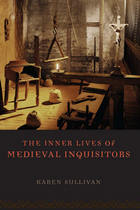 The Inner Lives of Medieval Inquisitors
Karen Sullivan
University of Chicago Press, 2011 There have been numerous studies in recent decades of the medieval inquisitions, most emphasizing larger social and political circumstances and neglecting the role of the inquisitors themselves. In this volume, Karen Sullivan sheds much-needed light on these individuals and reveals that they had choices—both the choice of whether to play a part in the orthodox repression of heresy and, more frequently, the choice of whether to approach heretics with zeal or with charity. In successive chapters on key figures in the Middle Ages—Bernard of Clairvaux, Dominic Guzmán, Conrad of Marburg, Peter of Verona, Bernard Gui, Bernard Délicieux, and Nicholas Eymerich—Sullivan shows that it is possible to discern each inquisitor making personal, moral choices as to what course of action he would take. All medieval clerics recognized that the church should first attempt to correct heretics through repeated admonitions and that, if these admonitions failed, it should then move toward excluding them from society. Yet more charitable clerics preferred to wait for conversion, while zealous clerics preferred not to delay too long before sending heretics to the stake. By considering not the external prosecution of heretics during the Middles Ages, but the internal motivations of the preachers and inquisitors who pursued them, as represented in their writings and in those of their peers, The Inner Lives of Medieval Inquisitors explores how it is that the most idealistic of purposes can lead to the justification of such dark ends.
 The Inner Opium War
James Polachek
Harvard University Press, 1992 Why did defeat in the Opium War not lead Ch'ing China to a more realistic appreciation of Western might and Chinese weakness? James Polachek's revisionist analysis exposes the behind-the-scenes political struggles that not only shaped foreign-policy decisions in the 1830s and 1840s but have continued to affect the history of Chinese nationalism in modern times.
Polachek looks closely at the networks of literati and officials, self-consciously reminiscent of the late Ming era that sought and gained the ear of the emperor. Challenging the conventional view that Lin Tse-hsu and his supporters were selfless patriots who acted in China's best interests, Polachek agrues that, for reasons having more to do with their own domestic political agenda, these men advocated a futile policy of militant resistance to the West. Linking political intrigue, scholarly debates, and foreign affairs, local notables in Canton and literati lobbyists in Perking this book sets the Opium War for the first times in its "inner," domestic political context.
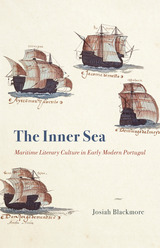 The Inner Sea: Maritime Literary Culture in Early Modern Portugal
Josiah Blackmore
University of Chicago Press, 2022 An expansive consideration of how nautical themes influenced literature in early modern Portugal.
In this book, Josiah Blackmore considers how the sea and seafaring shaped literary creativity in early modern Portugal during the most active, consequential decades of European overseas expansion. Blackmore understands “literary” in a broad sense, including a diverse archive spanning genres and disciplines—epic and lyric poetry, historical chronicles, nautical documents, ship logs, shipwreck narratives, geographic descriptions, and reference to texts of other seafaring powers and literatures of the period—centering on the great Luís de Camões, arguably the sea poet par excellence of early modern Europe.
Blackmore shows that the sea and nautical travel for Camões and his contemporaries were not merely historical realities; they were also principles of cultural creativity that connected to larger debates in the widening field of the maritime humanities. For Blackmore, the sea, ships, and nautical travel unfold into a variety of symbolic dimensions, and the oceans across the globe that were traversed in the fifteenth and sixteenth centuries correspond to vast reaches within the literary self. The sea and seafaring were not merely themes in textual culture but were also principles that created individual and collective subjects according to oceanic modes of perception. Blackmore concludes with a discussion of depth and sinking in shipwreck narratives as metaphoric and discursive dimensions of the maritime subject, foreshadowing empire’s decline.
Inner Space/Outer Space
Edited by Edward Kolb, Michael Turner, Keith Olive, David Seckel, and David Lind
University of Chicago Press, 1986 Inner Space/Outer Space brings together much of the exciting work contributing to a new synthesis of modern physics. Particle physicists, concerned with the "inner space" of the atom, are making discoveries that their colleagues in astrophysics, studying outer space, can use to develop and test hypotheses about the events that occurred in the microseconds after the Big Bang and that shaped the universe as we know it today.
The papers collected here, from scores of scientists, constitute the proceedings of the first major international conference on research at the interface of particle physics and astrophysics, held in May 1984. The editors have written introductions to each major section that draw out the central themes and elaborate on the primary implications of the papers that follow.
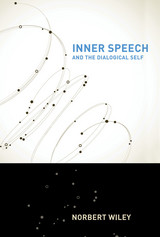 Inner Speech and the Dialogical Self
Norbert Wiley
Temple University Press, 2016 Inner speech, also known as self-talk, is distinct from ordinary language. It has several functions and structures, from everyday thinking and self-regulation to stream of consciousness and daydreaming. Inner Speech and the Dialogical Self provides a comprehensive analysis of this internal conversation that people have with themselves to think about problems, clarify goals, and guide their way through life. Norbert Wiley shrewdly emphasizes the semiotic and dialogical features of the inner speech, rather than the biological and neurological issues. He also examines people who lack control of their inner speech—such as some autistics and many emotionally disturbed people who use trial and error rather than self-control—to show the power and effectiveness of inner speech. Inner Speech and the Dialogical Self takes a humanistic social theorist approach to its topic. Wiley acknowledges the contributions of inner speech theorists, Lev Vygotsky and Mikhail Bakhtin, and addresses the classical pragmatism of Charles Sanders Peirce, John Dewey, William James, and George Herbert Mead to show the range and depth of this largely unexplored field.
 The Inner Word in Gadamer's Hermeneutics
John Arthos
University of Notre Dame Press, 2009
Late in his life, Hans-Georg Gadamer was asked to explain what the universal aspect of hermeneutics consisted in, and he replied, enigmatically, “in the verbum interius.” Gadamer devoted a pivotal section of his magnum opus, Truth and Method, to this Augustinian concept, and subsequently pointed to it as a kind of passkey to his thought. It remains, however, both in its origins and its interpretations, a mysterious concept. From out of its layered history, it remains a provocation to thought, expressing something about the relation of language and understanding that has yet to be fully worked out.
The scholastic idea of a word that is fully formed in the mind but not articulated served Augustine as an analogy for the procession of the Trinity, and served Thomas Aquinas as an analogy for the procession between divine ideas and human thought. Gadamer turned the analogy on its head by using the verbum interius to explain the obscure relation between language and human understanding. His learned interpretation of the idea of the inner word through Neoplatonism, Lutheranism, idealism, and historicism may seem nearly as complex as the medieval source texts he consulted and construed in his exegesis, but the profoundity of his insights are unquestioned.
In unpacking Gadamer's interpretive feat, John Arthos provides an overview of the philosophy of the logos out of which the verbum interius emerged. He summarizes the development of the verbum in ancient and medieval doctrine, traces its path through German thought, and explains its relevance to modern hermeneutic theory. His work unfolds in two parts, as an expansive intellectual history and as a close analysis and commentary on source texts on the inner word, from Augustine to Gadamer. As such, this book serves as an indispensable guide and reference for hermeneutics and the intellectual traditions out of which it arose, as well as an original theoretical statement in its own right.
“Consummately researched, lucidly written, and persuasively argued throughout, The Inner Wordsucceeds brilliantly in bringing to light this neglected but pivotal matter in Gadamer’s work. Arthos is learned in the best ‘humanist’ way, for he succeeds in creating something new of his own that will speak eloquently to all of us.” —Walter Jost, University of Virginia
“Gadamer suggests that the Christian idea of incarnation is a key to his hermeneutics, but does not explain his position in a detailed or systematic manner. Arthos brings his considerable knowledge of hermeneutics and rhetoric to bear on Gadamer's insight, recounting the rich intellectual history to which Gadamer gestures, and providing an extended and detailed exegesis of this pivotal point in the third part of Truth and Method. Gadamer's account of 'linguisticality,' Arthos explains, can best be understood through his use of a complex metaphor—the ‘inner word.’ Arthos matches his erudition with clear and clean prose, and his account exemplifies, rather than just describes, Gadamer's hermeneutical philosophy. Any scholar interested in Gadamer's philosophy should have this book on his or her shelf.” —Francis J. Mootz III, William S. Boyd Professor of Law, William S. Boyd School of Law
“Arthos's strength lies for me in his careful reading of the sources. He effectively commands the literature on the subject. This work shows in a sophisticated way the legacy of trinitarian theology for philosophical hermeneutics. The very complex task of illuminating the phenomenon of the verbum interius and indicating its centrality for philosophical hermeneutics is accomplished by John Arthos with great sensitivity to the subject matter.” —Andrzej Wiercinski, The International Institute for Hermeneutics
The Inner World of Abraham Lincoln
Michael Burlingame
University of Illinois Press, 1994 Published to a flurry of praise--and consternation--from Lincoln scholars, Burlingame's book takes a hard and unsentimental look at, among other things, Abraham Lincoln's excruciating yet fruitful midlife crisis, his marriage to a dishonest woman who often embarrassed and sometimes physically abused him, his estrangement from his father, his explosive temper, and his aversion to women.
 The Innermost House: A Memoir
Cynthia Blakeley
University of Massachusetts Press, 2024 Finalist, 2025 Georgia Author of the Year Award in Memoir
A stunning account of year-round life on the windswept shores of Cape Cod, threaded with meditations on memory, forgetting, and identity
Raised in a nineteenth-century saltbox house in Wellfleet, Massachusetts, Cynthia Blakeley was both surrounded by generations of immediate and extended family and isolated by the mysteries locked inside her affectionate yet elusive mother and short-fused father. While she and her sisters and cousins roamed the Outer Cape—drinking in the dunes, swimming in kettle ponds, and dancing in Provincetown—Blakeley also turned to the inner world of her journals as she contended with her own secrets and memories.
Over-identifying with her unconventional and artistic mother, Blakeley felt certain that the key to understanding her mother’s drinking and distractions, her generosity and easy forgiveness, was the unexplained absence of two of Blakeley’s half-siblings and their connection to her mother’s unhappy first marriage. Blakeley kept her distance, however, from her disciplinarian father. Though he took his daughters sailing and clamming and beachcombing, he was the chill to their mother’s warmth, the maker, not the breaker, of rules. Slipping through these dynamics in that small house and evocative landscape, Blakeley eventually crossed the bridge and left home, only to return later in search of the family stories that would help her decode her present.
Blakeley’s captivating memoir moves fluidly through time, grappling with the question of who owns a memory or secret and how our narrative choices not only describe but also shape and change us. In this insightful and poignant account of tenacious year-rounders on Cape Cod, Blakeley contends that making sense of ourselves is a collaborative affair, one that begins with understanding those we came from.
 The Innermost House: A Memoir
Cynthia Blakeley
University of Massachusetts Press, 2024 Finalist, 2025 Georgia Author of the Year Award in Memoir
A stunning account of year-round life on the windswept shores of Cape Cod, threaded with meditations on memory, forgetting, and identity
Raised in a nineteenth-century saltbox house in Wellfleet, Massachusetts, Cynthia Blakeley was both surrounded by generations of immediate and extended family and isolated by the mysteries locked inside her affectionate yet elusive mother and short-fused father. While she and her sisters and cousins roamed the Outer Cape—drinking in the dunes, swimming in kettle ponds, and dancing in Provincetown—Blakeley also turned to the inner world of her journals as she contended with her own secrets and memories.
Over-identifying with her unconventional and artistic mother, Blakeley felt certain that the key to understanding her mother’s drinking and distractions, her generosity and easy forgiveness, was the unexplained absence of two of Blakeley’s half-siblings and their connection to her mother’s unhappy first marriage. Blakeley kept her distance, however, from her disciplinarian father. Though he took his daughters sailing and clamming and beachcombing, he was the chill to their mother’s warmth, the maker, not the breaker, of rules. Slipping through these dynamics in that small house and evocative landscape, Blakeley eventually crossed the bridge and left home, only to return later in search of the family stories that would help her decode her present.
Blakeley’s captivating memoir moves fluidly through time, grappling with the question of who owns a memory or secret and how our narrative choices not only describe but also shape and change us. In this insightful and poignant account of tenacious year-rounders on Cape Cod, Blakeley contends that making sense of ourselves is a collaborative affair, one that begins with understanding those we came from.
INNOCENCE
JEAN NORDHAUS
Ohio State University Press, 2006
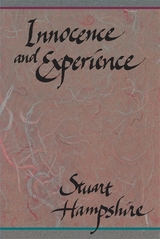 Innocence and Experience
Stuart Hampshire
Harvard University Press, 1989 Human beings have lived by very different conceptions of the good life. In this book, Stuart Hampshire argues that no individual and no modern society can avoid conflicts between incompatible moral interests. Philosophers have tried in the past to find some underlying moral idea of justice which could resolve these conflicts and would be valid for any society. Hampshire claims that there can be no such thing. States can be held together, and war between them avoided, only by respect for the political process itself, and it is in these terms that justice must be defined.
The book closely examines the critical relationship between morality and justice, paying particular attention to Hume's moral subjectivism (which Hampshire disputes) and proposing a reply to Machiavelli's claim that the realities of politics inevitably oblige leaders to choose between unavoidable evils.
Most academic and moral philosophy, Hampshire argues, has been a fairy tale, representing ideals of private innocence rather than the realities of public experience. Conflicts between incompatible moral interests are as unavoidable in social and international arenas as they are in the lives of individuals. Philosophers, politicians, and theologians have all looked for an underlying moral consensus that will be valid for any just society. But the diversity of the human species and important differences in how various cultures define the good life militate against the formation of any such consensus. Ultimately, conflicts can be mediated only by respect for procedural justice.
Hampshire believes that themes of moral philosophy come from the writer's own experience, and he has given a brief but compelling account of his own life to help the reader understand the sources of his philosophy. Combining intellectual rigor with imaginative power, in Innocence and Experience Stuart Hampshire vividly illuminates the tensions between justice and other sources of value in society and in the life of the individual.
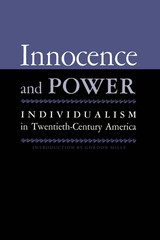 Innocence And Power: Individualism in Twentieth-century America
Edited by Gordon H. Mills
University of Texas Press, 1965 America believes in individualism—but what is individualism? This question leads into unexpected areas of life and thought. It touches upon almost every intellectual discipline concerned with human life. Any answer, to be taken seriously, must recognize this complexity. A broad understanding of the meaning of individualism can be reached only through the insight of many workers in many different fields. This volume brings together seven of the United States' most distinguished scholars, representing the fields of anthropology, economics, government, history, literature, and philosophy. The trend of their thinking can be suggested by a few excerpts from their essays: • "An individual divorced from a cultural milieu would not be a human being; he would be a mere hominid."—Leslie A. White • "The trouble is that 'individual' is a stop-thought word. It numbs the mind, so that once it has been uttered, inquiry stops."—Clarence E. Ayres • "Not even an individual's perfections are his alone; like his imperfections, they are group-made."— Paul A. Samuelson • "The twentieth century has witnessed the emergence of a new kind of American individualism, the individualism of nonconformity, which actually challenges the compulsive democracy of the Lockean individualism by which the nation has centrally and historically lived."—Louis Hartz • "The individualism of the American frontier was an individualism of personal self-reliance and of hardihood and stamina rather than an individualism of intellectual independence and personal self-expression."—David M. Potter • "The present conditions in which the self must be preserved are radically different from those of a generation, even a decade ago. . . . The dogmatics of present self-assertion are defined and pursued in an existential circumstance."—Frederick J. Hoffman • "Individuality means creativity, and 'laws of creativity,' other than statistical ones, are, I hold, a contradiction in terms."—Charles Hartshorne
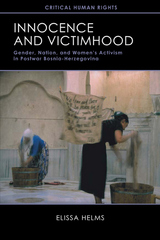 Innocence and Victimhood: Gender, Nation, and Women’s Activism in Postwar Bosnia-Herzegovina
Elissa Helms
University of Wisconsin Press, 2013 The 1992–95 war in Bosnia-Herzegovina following the dissolution of socialist Yugoslavia became notorious for “ethnic cleansing” and mass rapes targeting the Bosniac (Bosnian Muslim) population. Postwar social and political processes have continued to be dominated by competing nationalisms representing Bosniacs, Serbs, and Croats, as well as those supporting a multiethnic Bosnian state, in which narratives of victimhood take center stage, often in gendered form. Elissa Helms shows that in the aftermath of the war, initiatives by and for Bosnian women perpetuated and complicated dominant images of women as victims and peacemakers in a conflict and political system led by men. In a sober corrective to such accounts, she offers a critical look at the politics of women’s activism and gendered nationalism in a postwar and postsocialist society. Drawing on ethnographic research spanning fifteen years, Innocence and Victimhood demonstrates how women’s activists and NGOs responded to, challenged, and often reinforced essentialist images in affirmative ways, utilizing the moral purity associated with the position of victimhood to bolster social claims, shape political visions, pursue foreign funding, and wage campaigns for postwar justice. Deeply sensitive to the suffering at the heart of Bosnian women’s (and men’s) wartime experiences, this book also reveals the limitations to strategies that emphasize innocence and victimhood.
An Innocent Abroad: Lectures in China
J. Hillis Miller
Northwestern University Press, 2015 Since 1988, J. Hillis Miller has traveled to China to lecture on literary theory, especially the role of globalization in literary theory. Over time, he has assisted in the development of distinctively Chinese forms of literary theory, Comparative Literature, and World Literature. The fifteen lectures gathered in An Innocent Abroad span both time and geographic location, reflecting his work at universities across China for more than twenty-five years. More important, they reflect the evolution of Miller’s thinking and of the lectures’ contexts in China as these have markedly changed over the years, especially on either side of Tiananmen Square and in light of China’s economic growth and technological change. A foreword by the leading theorist Fredric Jameson provides additional context.
Innocent Eye: A Passionate Look at Contemporary Art
Patricia Rosoff
Tupelo Press, 2013 Award-winning journalist, artist, and educator Patricia Rosoff offers a first-hand tour of the sometimes shocking, often challenging ideas and approaches that continue to fuel the art of today. Rosoff describes the sources of contemporary painting, sculpture, photography, and mixed media in the works of such radicals as Monet, Kandinsky, and Joseph Cornell, who are now part of the tradition but who keep on catalyzing experimental innovators such as Ellen Carey, Spencer Finch, Janine Antoni, and Iñigo Manglano-Ovale. With close (and sympathetic) consideration of conceptualists, including works by Sol LeWitt and Mierle Ukeles, and with special excitement about the inexhaustible potential in abstract art, Pat Rosoff is the gallery or museum guide you’ve always wished to have along.
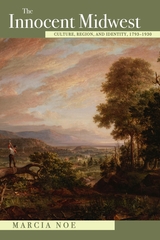 The Innocent Midwest: Culture, Region, and Identity, 1793-1930
Marcia Noe
Ohio University Press The Innocent Midwest delves into one of the most enduring stereotypes in American cultural history: the image of the Midwest as a bastion of innocence. Despite its share of social, political, and economic complexities, the region has long been portrayed as wholesome, virtuous, and peace loving—a perception that has persisted from its pastoral beginnings through industrialization and into the digital age. This book traces the roots and evolution of that myth, arguing that the Midwest’s innocent image has been carefully cultivated through American popular and high culture. From literature and film to music and visual art, the trope of the innocent Midwesterner has shaped national perceptions of the region for over a century. Focusing on literature from 1793 to the 1920s, the book explores how this character type emerged, evolved, and eventually confronted the disillusionment of the machine age. Organized thematically, the book examines early frontier narratives, stories of Midwesterners abroad, Progressive Era ideals of neighborliness, immigrant and migrant experiences, and the eventual unraveling of the pastoral dream. It reveals how the myth of innocence was underpinned by a constellation of values—agrarianism, Christian morality, and a belief in education—that supported the Jeffersonian vision of a democratic, virtuous citizenry. Rather than offering a sweeping theory of regional identity, The Innocent Midwest focuses on the recurring literary figure of the innocent Midwesterner—an individual shaped by the land and striving for self-actualization. The book draws both on canonical authors like Mark Twain, William Dean Howells, Booth Tarkington, Sinclair Lewis, Theodore Dreiser, and Willa Cather and on lesser-known voices such as Maria Susanna Cummins, David Graham Phillips, Elia W. Peattie, William Webb, Chief Luther Standing Bear, and Oscar Micheaux, whose works contributed to the cultural construction of the Midwest. Through its nuanced exploration of literature and culture, this book offers a compelling account of how the Midwest came to symbolize innocence—and why that image continues to resonate in the American imagination.
An Innocent Millionaire
Stephen Vizinczey
University of Chicago Press, 1990 "Brilliantly inventive, written with great flair and shows a deliciously comic and ironic sense of American realities."—Alfred Kazin
"The virtues of [Vizinczey's] style are those he finds in Hungarian poetry: the moody ferocity of a locked-up beast, and also a classic clarity and complete lack of self-indulgence."—Thomas D'Evelyn, Christian Science Monitor
"Shows where the true values lie—not in wealth or the rule of law but in that as yet inviolate sector where a man and woman make love. . . . I was entertained but also deeply moved: here is a novel set bang in the middle of our decadent, polluted, corrupt world that, in some curious way, breathes a kind of desperate hope."—Anthony Burgess, Punch (London)
"Bravo!"—Graham Greene
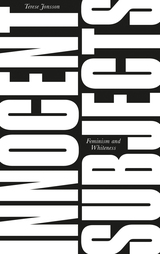 Innocent Subjects: Feminism and Whiteness
Terese Jonsson
Pluto Press, 2020 In a time of intensified global white supremacist and patriarchal violence, anti-racist feminist movements and analyses have never been more vital. Women of colour are at the forefront of these struggles worldwide - but are white feminists really by their side?
Despite a rich history of Black and postcolonial critiques of racist and imperial feminist politics, racism still exists within contemporary British feminism. To explain why, Terese Jonsson examines the history of feminism over the last forty years. She argues that Black feminism's role in shaping the movement has been marginalised through narratives which repeatedly position white women at the centre of the story, from the women's liberation movement in the 1970s to today.
Analysing the ways in which whiteness continues to pervade feminist literature, as well as feminist debates in the liberal media, Jonsson demonstrates that, despite an increased attention to race, intersectionality and difference, stories told by white feminists are shaped by their desire to maintain an 'innocent' position towards racism.
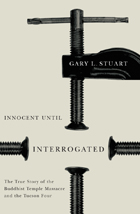 Innocent Until Interrogated: The True Story of the Buddhist Temple Massacre and the Tucson Four
By Gary L. Stuart
University of Arizona Press, 2010 On a sweltering August morning, a woman walked into a Buddhist temple near Phoenix and discovered the most horrific crime in Arizona history. Nine Buddhist temple members—six of them monks committed to lives of non-violence—lay dead in a pool of blood, shot execution style. The massive manhunt that followed turned up no leads until a tip from a psychiatric patient led to the arrest of five suspects. Each initially denied their involvement in the crime, yet one by one, under intense interrogation, they confessed.
Soon after, all five men recanted, saying their confessions had been coerced. One was freed after providing an alibi, but the remaining suspects—dubbed “The Tucson Four” by the media—remained in custody even though no physical evidence linked them to the crime.
Seven weeks later, investigators discovered—almost by chance—physical evidence that implicated two entirely new suspects. The Tucson Four were finally freed on November 22 after two teenage boys confessed to the crime, yet troubling questions remained. Why were confessions forced out of innocent suspects? Why and how did legal authorities build a case without evidence? And, ultimately, how did so much go so wrong?
In this first book-length treatment of the Buddhist Temple Massacre, Gary L. Stuart explores the unspeakable crime, the inexplicable confessions, and the troubling behavior of police officials. Stuart’s impeccable research for the book included a review of the complete legal records of the case, an examination of all the physical evidence, a survey of three years of print and broadcast news, and more than fifty personal interviews related to the case. Like In Cold Blood, and The Executioner’s Song, Innocent Until Interrogated is a riveting read that provides not only a striking account of the crime and the investigation but also a disturbing look at the American justice system at its very worst.
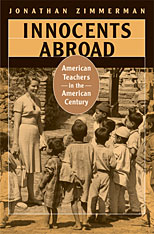 Innocents Abroad: American Teachers in the American Century
Jonathan Zimmerman
Harvard University Press, 2008 Protestant missionaries in Latin America. Colonial "civilizers" in the Pacific. Peace Corps Volunteers in Africa. Since the 1890s, thousands of American teachers--mostly young, white, middle-class, and inexperienced--have fanned out across the globe. Innocents Abroad tells the story of what they intended to teach and what lessons they learned.
Drawing on extensive archives of the teachers' letters and diaries, as well as more recent accounts, Jonathan Zimmerman argues that until the early twentieth century, the teachers assumed their own superiority; they sought to bring civilization, Protestantism, and soap to their host countries. But by the mid-twentieth century, as teachers borrowed the concept of "culture" from influential anthropologists, they became far more self-questioning about their ethical and social assumptions, their educational theories, and the complexity of their role in a foreign society.
Filled with anecdotes and dilemmas--often funny, always vivid--Zimmerman's narrative explores the teachers' shifting attitudes about their country and themselves, in a world that was more unexpected and unsettling than they could have imagined.
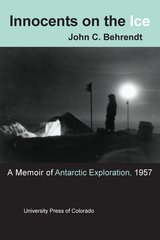 Innocents on the Ice: A Memoir of Antarctic Exploration, 1957
John C. Behrendt
University Press of Colorado, 1998 "Adventures in the Antarctic only happen when someone makes a mistake.”
—From the Preface In 1956, John C. Behrendt had just earned his master’s degree in geophysics and obtained a position as an assistant seismologist in the International Geophysical Year glaciological program. He sailed from Davisville, Rhode Island to spend eighteen months in Antarctica with the IGY expedition as part of a U.S. Navy-supported scientific expedition to establish Ellsworth Station on the Filchner Ice Shelf. Innocents on the Ice is a memoir based on Behrendt’s handwritten journals, looking back on his daily entries describing his life and activities on the most isolated of the seven U.S. Antarctic stations.
Nine civilians and thirty Navy men lived beneath the snow together, and intense personal conflicts arose during the dark Antarctic winter of 1957. Little outside contact was available to ease the tension, with no mail delivery and only occasional radio contact with families back home. The author describes the emotional stress of the living situation, along with details of his parties’ explorations of the Filchner-Ronne Ice Shelf system during the summers of 1957 and 1958. Along the hazardous 1,300-mile traverse in two Sno-Cats, the field party measured ice thickness and snow accumulation as part of an international effort to determine the balance of the Antarctic ice sheet, and made the first geological observations of the spectacular Dufek Massif in the then-unexplored Pensacola Mountains. Behrendt also draws upon his forty years of continual participation in Antarctic research to explain the changes in scientific activities and environmental awareness in Antarctica today.
Including photos, maps, and a glossary identifying various forms of ice, Innocents on the Ice is a fascinating combination of the diary of a young graduate student and the reflections of the accomplished scientist he became.
 Innovating with Integrity: How Local Heroes Are Transforming American Government
Sandford Borins
Georgetown University Press, 1998 Innovating with Integrity presents a comprehensive portrait of the local heroes—front-line public servants and middle managers—who are reinventing state and local government, and it offers practical recommendations for innovating successfully. Based on a study of more than 200 successful government innovations, this book is the first large-scale, systematic analysis of innovation in American government. Sandford Borins identifies the components of integrity that he finds in successful innovators, including the intellectual discipline to plan rigorously and to establish measurable goals; the ability to collaborate with others and accommodate criticism; and a willingness to mobilize both the private sector and the community. In addition to analyzing the common traits driving new initiatives, Borins shows the distinctive differences among six areas of innovation: information technology, organizational redesign, environmental and energy management, policing and community development, social services, and education.
This trenchant analysis of what initiatives actually work and why contributes to both the practice and theory of public management. Its practical advice will be especially valuable for front-line government workers, public managers, union leaders, agency heads, politicians, and all concerned with reforming government.
INNOVATION AND TRADITION IN THE WRITINGS OF THE VENERABLE BEDE
SCOTT DEGREGORIO
West Virginia University Press, 2006 Works prior to this book focused on Bede as not only a European, but also as an English scholar, historian, scientist, or a biographer of saints, and have used a traditional approach towards his explanation of the Bible. Bede's interpretation of his work, its continuous progress, and the reasons behind his hurried appointment to an authority almost as high as the Church Fathers are all topics examined within the text. Essays are by Roger Ray, Faith Wallis, Calvin B. Kendall, George Hardin Brown, Scott DeGregorio, Arthur G. Holder, Lawrence T. Martin, Walter Goffart, and Joyce Hill.
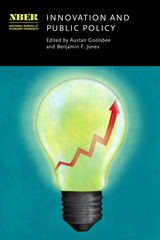 Innovation and Public Policy
Austan Goolsbee and Benjamin F. Jones
University of Chicago Press, 2021 Using the latest empirical and conceptual research for readers in economics, business, and policy, this volume surveys the key components of innovation policy and the social returns to innovation investment.
In advanced economies like the United States, innovation has long been recognized as a central force for increasing economic prosperity and human welfare. Today, the US government promotes innovation through various mechanisms, including tax credits for private-sector research, grant support for basic and applied research, and institutions like the Small Business Innovation Research Program of the National Science Foundation. Drawing on the latest empirical and conceptual research, Innovation and Public Policy surveys the key components of innovation policy and the social returns to innovation investment. It examines mechanisms that can advance the pace of invention and innovative activity, including expanding the research workforce through schooling and immigration policy and funding basic research. It also considers scientific grant systems for funding basic research, including those at institutions like the National Institutes of Health and the National Science Foundation, and investigates the role of entrepreneurship policy and of other institutions that promote an environment conducive to scientific breakthroughs.
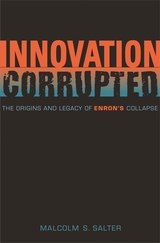 Innovation Corrupted: The Origins and Legacy of Enron's Collapse
Malcolm S. Salter
Harvard University Press, 2008 Although much has already been written about the rise and fall of Enron, four important questions remain unanswered: What management behavior and practices led Enron down the path from truly innovative to fraudulent management? How could Enron’s board of directors have failed to detect the business, ethical, and legal risks embedded in the company’s aggressive financial strategies and accounting practices? Why did Enron’s external watchdogs—security analysts, credit-rating agencies, and regulatory agencies—fail to bark? What actions can prevent Enron-type breakdowns in the future? Innovation Corrupted addresses each of these questions.
In contrast to the time-line narratives of previous books on Enron that offer interesting but largely unsystematic insight into individual actions and organizational processes, Innovation Corrupted pursues a more methodical analysis of the causes and lessons of Enron’s collapse. Based upon newly available sources, Salter identifies the social pathologies and administrative failures that fostered the company’s ethical drift and inhibited the board of directors from exercising effective governance and control. Salter also goes beyond the work of previous books by proposing practical recommendations for preventing future Enron-type disasters. These prescriptions relate to board oversight, financial incentives for executives, and, most importantly, the maintenance of ethical discipline when operating in the murky borderlands of the law. It was in this shadowed space that Enron’s senior executives lost their way.
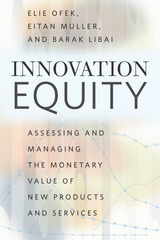 Innovation Equity: Assessing and Managing the Monetary Value of New Products and Services
Elie Ofek, Eitan Muller, and Barak Libai
University of Chicago Press, 2016 From drones to wearable technology to Hyperloop pods that can potentially travel more than seven hundred miles per hour, we’re fascinated with new products and technologies that seem to come straight out of science fiction. But, innovations are not only fascinating, they’re polarizing, as, all too quickly, skepticism regarding their commercial viability starts to creep in. And while fortunes depend on people’s ability to properly assess their prospects for success, no one can really agree on how to do it, especially for truly radical new products and services.
In Innovation Equity, Elie Ofek, Eitan Muller, and Barak Libai analyze how a vast array of past innovations performed in the marketplace—from their launch to the moment they became everyday products to the phase where consumers moved on to the “next big thing.” They identify key patterns in how consumers adopt innovations and integrate these with marketing scholarship on how companies manage their customer base by attracting new customers, keeping current customers satisfied, and preventing customers from switching to competitors’ products and services. In doing so, the authors produce concrete models that powerfully predict how the marketplace will respond to innovations, providing a much more authoritative way to estimate their potential monetary value, as well as a framework for making it possible to achieve that value.
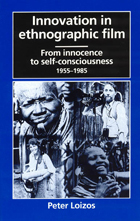 Innovation in Ethnographic Film: From Innocence to Self-Consciousness, 1955-1985
Peter Loizos
University of Chicago Press, 1993 In the first coprehensive introduction to the nature and development of ethnographic film, Peter Loizos reviews fifty of the most important films made between 1955 and 1985. Going beyond programmatic statements, he analyzes the films themselves, identifying and discussing their contributions to ethnographic documentation.
Loizos begins by reviewing works of John Marshall and Timothy Asch in the 1950s and moves through those of Jean Rouch, Robert Gardner, and many more recent filmmakers. He reveals a steady course of innovations along four dimensions: production technology, subject matter, strategies of argument, and ethnographic authentication. His analyses of individual films address questions of realism, authenticity, genre, authorial and subjective voice, and representation of the films' creators as well as their subjects.
Innovation in Ethnographic Film, as a systematic and iluminating review of developments in ethnographic film, will be an important resource for the growing number of anthropologists and other scholars who use such films as tools for research and teaching.
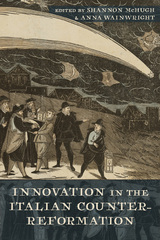 Innovation in the Italian Counter-Reformation
Shannon McHugh
University of Delaware Press, 2011 The enduring "black legend" of the Italian Counter-Reformation, which has held sway in both scholarly and popular culture, maintains that the Council of Trent ushered in a cultural dark age in Italy, snuffing out the spectacular creative production of the Renaissance. As a result, the decades following Trent have been mostly overlooked in Italian literary studies, in particular. The thirteen essays of Innovation in the Italian Counter-Reformation present a radical reconsideration of literary production in post-Tridentine Italy. With particular attention to the much-maligned tradition of spiritual literature, the volume’s contributors weave literary analysis together with religion, theater, art, music, science, and gender to demonstrate that the literature of this period not only merits study but is positively innovative. Contributors include such renowned critics as Virginia Cox and Amedeo Quondam, two of the leading scholars on the Italian Counter-Reformation.
Published by University of Delaware Press. Distributed worldwide by Rutgers University Press.
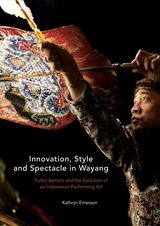 Innovation, Style and Spectacle in Wayang: Purbo Asmoro and the Evolution of an Indonesian Performing Art
Kathryn Emerson
National University of Singapore Press, 2022 A richly illustrated study of wayang, the traditional puppet theater form of Java, based on unprecedented decades-long participatory research.
Wayang, the traditional puppet theater form of Java, fascinates and endures thanks to the many ways it works as a medium—bearing the weight of Javanese culture and tradition as a key component of rites of passage, as a medium of ritual and spiritual practice, as public spectacle, and as entertainment of the broadest sort, performed live, broadcast, or streamed. Over the past forty years, the form has been subject to a great deal of experimentation and innovation, pulled in many directions within an ever-changing media landscape. In this book, Kathryn Anne Emerson outlines both significant contributions by a number of key figures and the social and political influences propelling such innovations. She also describes deeper and more lasting changes in wayang, based on what the art form's most accomplished practitioners have to say about it. At the core of the book is one pivotal figure, Purbo Asmoro of the Indonesian Institute of the Arts in Surakarta, who, Emerson argues, has taken the individual and singular innovations of the era and integrated them into a new system of performance practice, one that has shaped the key Surakarta school of performance. Grounded in an unprecedented, decades-long participatory research project involving hundreds of interlocutors, the book is beautifully illustrated and will be of considerable interest in Indonesian studies.
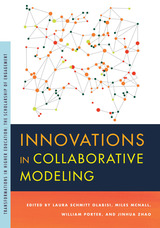 Innovations in Collaborative Modeling
Laura Schmitt-Olabisi
Michigan State University Press, 2020 Collaborative applications of a variety of modeling methodologies have multiplied in recent decades due to widespread recognition of the power of models to integrate information from multiple sources, test assumptions about policy and management choices, and forecast the future states of complex systems. However, information about these modeling efforts often is segregated by both discipline and modeling approach, preventing modelers from learning from one another. This volume addresses the need for cross-disciplinary and cross-methodological communication about collaborative modeling. To enhance a shared understanding of systems problems, scientists and stakeholders need strategies for integrating information from their respective fields, dealing with issues of scale and focus, and rigorously investigating assumptions. The chapters in this volume first explore modeling methodologies for enhanced collaboration, then offer case studies of collaborative modeling across different complex systems problems. The volume will be useful for experienced and beginning modelers as well as scientists and stakeholders who work with modelers.
Innovations in Healthcare Informatics: From interoperability to data analysis
Mohamed Abouhawwash
The Institution of Engineering and Technology, 2023 Improved computing technology combined with IoT-enabled smart devices and the digitization of personal health records (PHRs) has created vast quantities of patient data in recent years. The availability of this data and new processing methods are enabling clinicians to provide better care for patients and has sparked a growing interest in consumer health informatics (CHI) and in the potential of patient-generated health data (PGHD).
 Innovations in Teaching History: Eighteenth-Century Studies in Higher Education
Edited by Ruth Larsen, Alice Marples, and Matthew McCormack
University of London Press, 2024 An essential teaching companion offering practical strategies for all teachers of history in higher education to enhance student learning.
The eighteenth century has been a notable recent growth area in historical studies and related disciplines and is key in university research and teaching. Although widely taught in history departments, the eighteenth century also presents challenges, including new students’ unfamiliarity with the period, the theoretical and interdisciplinary nature of the critical writings, and extensive online source material requiring digital skills for its evaluation.
Focusing on pedagogical innovation and current developments in the discipline, this collection of essays reflects on how we teach the history of the long eighteenth century, exploring current subfields such as histories of material culture, the senses, gender, crime, race, empire, and colonialism. It presents practical case studies showcasing how novel teaching methods can be employed in the classroom that promote active learning and invite students to think critically about the nature of their discipline. Methods covered include decolonizing the curriculum, digital history, transferable skills, engaging with objects, working in non-classroom settings, and multisensory approaches.
Grounded in real academic practice, this is a valuable guide for all history educators, whether specializing in the eighteenth century or beyond.
 Innovation—The Missing Dimension
Richard K. Lester and Michael J. Piore
Harvard University Press, 2006 Amid mounting concern over the loss of jobs to low-wage economies, one fact is clear: America's prosperity hinges on the ability of its businesses to continually introduce new products and services. But what makes for a creative economy? How can the remarkable surge of innovation that fueled the boom of the 1990s be sustained?
For an answer, Richard K. Lester and Michael J. Piore examine innovation strategies in some of the economy's most dynamic sectors. Through eye-opening case studies of new product development in fields such as cell phones, medical devices, and blue jeans, two fundamental processes emerge.
One of these processes, analysis--rational problem solving--dominates management and engineering practice. The other, interpretation, is not widely understood, or even recognized--although, as the authors make clear, it is absolutely crucial to innovation. Unlike problem solving, interpretation embraces and exploits ambiguity, the wellspring of creativity in the economy. By emphasizing interpretation, and showing how these two radically different processes can be combined, Lester and Piore's book gives managers and designers the concepts and tools to keep new products flowing.
But the authors also offer an unsettling critique of national policy. By ignoring the role of interpretation, economic policymakers are drawing the wrong lessons from the 1990s boom. The current emphasis on expanding the reach of market competition will help the analytical processes needed to implement innovation. But if unchecked it risks choking off the economy's vital interpretive spaces. Unless a more balanced policy approach is adopted, warn Lester and Piore, America's capacity to innovate--its greatest economic asset--will erode.
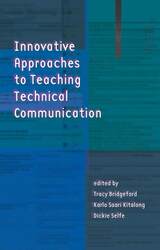 Innovative Approaches to Teaching Technical Communication
edited by Tracy Bridgeford, Karla Saari Kitalong, and Dickie Selfe
Utah State University Press, 2004 Programs in technical writing, technical communication, and/or professional communication have recently grown in enrollment as the demand among employers for formally prepared technical writers and editors has grown. In response, scholarly treatments of the subject and the teaching of technical writing are also burgeoning, and the body of research and theory being published in this field is many times larger and more accessible than it was even a decade ago. Although many theoretical and disciplinary perspectives can potentially inform technical communication teaching, administration, and curriculum development, the actual influences on the field's canonical texts have traditionally come from a rather limited range of disciplines. Innovative Approaches to Teaching Technical Communication brings together a wide range of scholars/teachers to expand the existing canon.
Innovative Concepts for Alternative Migration Policies: Ten Innovative Approaches to the Challenges of Migration in the 21st Century
Edited by Michael Jandl
Amsterdam University Press, 2007
Directed at researchers and policy makers at all levels, Innovative Concepts for Alternative Migration Policies expands on ten presentations from the 2006 workshop of the same name held at the International Centre for Migration Policy Development in Vienna. Based on the strengths of combined ideas from migration researchers, policy experts, and representatives of international organizations, this timely volume provides eight basic principles for the design of innovative migration policy and stimulates fresh thinking for the development of unconventional and thought-provoking policy making.
 Innovative Library Workplaces: Transformative Human Resource Strategies
Lisa Kallman Hopkins
Association of College & Research Libraries, 2024 Good workplaces require both autonomy—giving employees a sense of ownership over how and where they work—and collaboration in pursuit of common goals. They see employees for who they are and support them, pay them enough money to live comfortably, and provide the resources, training, and support they need to be successful. In two parts, Innovative Library Workplaces provides the tools you need to make your workplace a good one for your employees. - Human Resources in Libraries
- Recruiting and Hiring
- Onboarding and Training
- Salary Studies and Unions
- Work Culture and Organization
- Employee Morale
- Flexible Work Arrangements
- Strategic Planning and Reorganizing
Though this book took root during the pandemic, it is not of the pandemic: The changes wrought are permanent. Innovative Library Workplaces proposes a way forward after this monumental disruption, recognizing that neither the pandemic nor the work culture prior to it is a good model for what comes next.
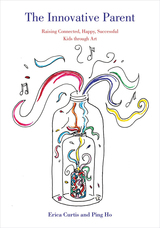 The Innovative Parent: Raising Connected, Happy, Successful Kids through Art
Erica Curtis
Ohio University Press, 2019 2019 National Parenting Products Award Winner Even the best talk-based practices in parenting can be limiting. How can art help parents temper storms of emotion, defuse sibling conflicts, get teeth brushed, and raise happy, successful kids? In The Innovative Parent, Erica Curtis and Ping Ho integrate cutting-edge research, years of clinical expertise, and their own parenting experience into a revolutionary yet practical guide to creative parenting. Plentiful illustrations and anecdotes bring concepts to life and show art in action with kids and parents. Together, Curtis and Ho let parents in on art therapy trade secrets to help children make sense of emotions, build connections with others, develop problem-solving skills, resolve day-to-day conflicts, process and retain information, confront fears and anxiety, and much more. These are complex tasks for something as seemingly simple as making art, yet therein lies the beauty of The Innovative Parent: its down-to-earth approach is simple, doable, and fun.
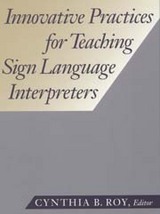 Innovative Practices for Teaching Sign Language Interpreters
Cynthia B. Roy
Gallaudet University Press, 2000 Researchers now understand interpreting as an active process between two languages and cultures, with social interaction, sociolinguistics, and discourse analysis as more appropriate theoretical frameworks. Roy’s penetrating new book acts upon these new insights by presenting six dynamic teaching practices to help interpreters achieve the highest level of skill.
Jeffrey Davis illustrates the translation skills that form the basis for teaching consecutive and simultaneous interpreting to help students understand the intended meaning of the source message, and also the manner in which listeners understand it. Rico Peterson demonstrates the use of recall protocols, which can be used to teach metacognitive skills and to assess the student’s sign language comprehension. Finally, Janice Humphrey details the use of graduation portfolios, a valuable assessment tool used by faculty to determine a student’s level of competency. These imaginative techniques in Innovative Practices promise gains in sign language interpreting that will benefit teachers, students, and clients alike in the very near future.
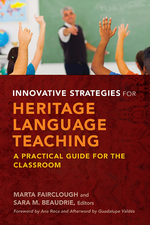 Innovative Strategies for Heritage Language Teaching: A Practical Guide for the Classroom
Marta Fairclough and Sara M. Beaudrie, Editors. Foreword by Ana Roca. Afterword by Guadalupe Valdés
Georgetown University Press, 2016 Heritage language (HL) learning and teaching presents particularly difficult challenges. Melding cutting-edge research with innovations in teaching practice, the contributors in this volume provide practical knowledge and tools that introduce new solutions informed by linguistic, sociolinguistic, and educational research on heritage learners. Scholars address new perspectives and orientations on designing HL programs, assessing progress and proficiency, transferring research knowledge into classroom practice, and the essential question of how to define a heritage learner. Articles offer analysis and answers on multiple languages, and the result is a unique and essential text—the only comprehensive guide for heritage language learning based on the latest theory and research with suggestions for the classroom.
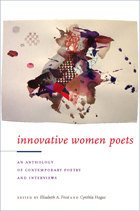 Innovative Women Poets: An Anthology of Contemporary Poetry and Interviews
Elisabeth A. Frost
University of Iowa Press, 2007 In this unusual and insightful collection, fourteen full-length literary interviews with innovative female poets of the last forty years, enhanced with a selection of their poems and prefaced by short introductions, present a wide and accessible range of forms, schools, politics, and conversations. By giving us each poet’s own voice in a medium other than poetry, the interviews provide important cultural and historical contexts that help define notions of innovation and contribute to a fuller understanding of these experimental poems.Poets and literary scholars Elisabeth Frost and Cynthia Hogue selected writers with particular attention to diversity in terms of ethnicity, philosophical concerns, and aesthetic movements, including the New York School, the Black Arts Movement, and language writing. By bringing together poets not usually considered in the same critical context, the editors clarify the ways in which these innovative women have affected ideas of poetry and poetic practice.The engaging interviews (whose questions are often as interesting and informed as the responses), introductory texts, and selected poems allow readers to forge productive connections among the most important voices of late twentieth-century American poetry.
The Inordinance of Time
Shaun Gallagher
Northwestern University Press, 1998 The Inordinance of Time develops an account of the experience of time at the intersection of three approaches: phenomenology, cognitive science, and post-structuralism. Using insights developed in both the phenomenological and cognitive traditions Gallagher explores the inadequacies of the existing models, the limitations imposed by introspective reflection, concepts of intentionality and embodied existence, and the extra-intentional processes that govern the operations of consciousness and memory.
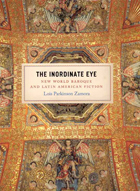 The Inordinate Eye: New World Baroque and Latin American Fiction
Lois Parkinson Zamora
University of Chicago Press, 2006 The Inordinate Eye traces the relations of Latin American painting, sculpture, architecture, and literature—the stories they tell each other and the ways in which their creators saw the world and their place in it. Moving from pre-Columbian codices and sculpture through New World Baroque art and architecture to Neobaroque theory and contemporary Latin American fiction, Lois Parkinson Zamora argues for an integrated understanding of visual and verbal forms.
The New World Baroque combines indigenous, African, and European forms of expression, and, in the early decades of the twentieth century, Latin American writers began to recuperate its visual structures to construct an alternative account of modernity, using its hybrid forms for the purpose of creating a discourse of “counterconquest”—a postcolonial self-definition aimed at disrupting entrenched power structures, perceptual categories, and literary forms.
Zamora engages this process, discussing a wide range of visual forms—Baroque façades and altarpieces, portraits of saints and martyrs (including the self-portraits of Frida Kahlo), murals from indigenous artisans to Diego Rivera—to elucidate works of fiction by Borges, Carpentier, Lezama Lima, Sarduy, Garro, García Márquez, and Galeano, and also to establish a critical perspective external to their work. Because visual media are “other” to the verbal economy of modern fiction, they serve these writers (and their readers) as oblique means by which to position their fiction culturally, politically, and aesthetically.
The first study of its kind in scope and ambition, The Inordinate Eye departs radically from most studies of literature by demonstrating how transcultural conceptions of the visual image have conditioned present ways of seeing and reading in Latin America.
 Inorganic Life: On Post-Vitalism
Eckardt Lindner
Diaphanes, 2024 A theory of passive vitalism.
Contemporary theory has pushed the boundaries of the concept of the living, urging us to consider a vitality that manifests beyond the human, animal, or even the organic altogether. Recognizing the vast variety of modes of existence and vibrancy entails—such is the claim—a new ethics and politics. In Inorganic Life, the philosopher Eckardt Lindner intervenes in this discussion. He claims that we have not yet properly understood how and to what effect we can break the organo-centrism of philosophy and have neglected to consider the inner contradictions of such novel amalgams of vitalism and materialism.
As an unlikely ally in his critical project, he investigates the inner tension in Deleuze’s works between an overtly vitalist stance and critiques of classical forms of vitalism, bordering on a novel anti-vitalism. Against active forms of vitalism, interested in more immersion in the world, interconnectedness, and ever more efficacious praxis, one can find in Deleuze a passive vitalism. This subterranean thought in the philosophy of immanence highlights the capacity of life to disorient itself, to be out of line with itself, to detach itself from purposeful action and its own inner goals.
Lindner explores this passive vitalism by drawing together thinkers such as Deleuze, Cioran, Laruelle, Kant, and Derrida. Suspicious of the moralistic and enthusiastic tendency of new materialisms, this vitalism would be inherently critical—even of its own commitments to liveliness—and thus gestures to a new politics and ethics of life.
Inquire
Lori E. Donovan
American Library Association, 2022
Inquiries in Bioethics
Stephen G. Post
Georgetown University Press, 1993 The biological revolution, with its attendant technological powers to alter nature and human nature, demands fundamental and cautionary reflection on questions of the highest ethical importance. In this thoughtful book on contemporary issues in bioethics, Stephen G. Post explores nine major topics ranging from birth and adolescence to aging and death. Using an interdisciplinary approach, Post clearly illuminates the issues, probes the ethical alternatives, and examines the cultural changes that shape current presuppositions about the right and good. This book will be of interest to scholars in bioethics, philosophy, and religious studies; health-care professionals; and the general reader concerned with these pressing questions of life and death.
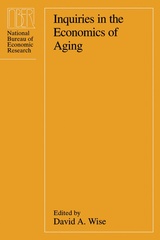 Inquiries in the Economics of Aging
Edited by David A. Wise
University of Chicago Press, 1998 For over a decade, the National Bureau of Economic Research has sponsored the Economics of Aging Program, under the direction of David A. Wise. The program addresses issues that affect the well-being of individuals as they age and a society that is composed increasingly of older people.
Within the next twenty years, an unprecedented proportion of Americans will be over sixty-five. New research in the economics of aging is an essential element of understanding what the future holds for this aging population. Inquiries in the Economics of Aging presents both empirical papers that consider questions that are fundamental to public policy and more theoretical contributions that lay new groundwork for future research in the economics of aging.
Inquiries in the Economics of Aging provides a timely overview of some of the most important questions facing researchers on aging and outlines new techniques and models that may help to answer these questions. This important volume will be of great interest to specialists and policy makers as it paves the way for future analysis.
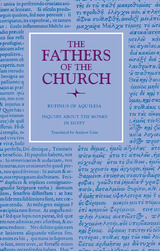 Inquiry about the Monks in Egypt
Rufinus of Aquileia
Catholic University of America Press, 2020 From September 394 to early January 395, seven monks from Rufinus of Aquileia’s monastery on the Mount of Olives made a pilgrimage to Egypt to visit locally renowned monks and monastic communities. Shortly after their return to Jerusalem, one of the party, whose identity remains a mystery, wrote an engaging account of this trip. Although he cast it in the form of a first-person travelogue, it reads more like a book of miracles that depicts the great fourth-century Egyptian monks as prophets and apostles similar to those in the Bible. This work was composed in Greek, yet it is best known today as Historia monachorum in Aegypto (Inquiry about the Monks in Egypt), the title of the Latin translation of this work made by Rufinus, the pilgrim-monks’ abbot.
The Historia monachorum is one of the most fascinating, fantastical, and enigmatic pieces of literature to survive from the patristic period. In both its Greek original and Rufinus’s Latin translation it was one of the most popular and widely disseminated works of monastic hagiography during Late Antiquity and the Middle Ages. Modern scholars value it not only for its intrinsic literary merits but also for its status, alongside Athanasius’s Life of Antony, the Pachomian dossier, and other texts of this ilk, as one of the most important primary sources for monasticism in fourth-century Egypt.
Rufinus’s Historia monachorum is presented here in English translation in its entirety. The introduction and annotations situate the work in its literary, historical, religious, and theological contexts.
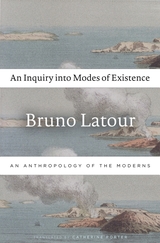 An Inquiry into Modes of Existence: An Anthropology of the Moderns
Bruno Latour
Harvard University Press, 2013 Over the past twenty-five years, Bruno Latour has developed a research protocol different from the actor-network theory with which his name is now associated—a research protocol that follows the different types of connectors that provide specific truth conditions. These are the connectors that prompt a climate scientist challenged by a captain of industry to appeal to the institution of science, with its army of researchers and mountains of data, rather than to “capital-S Science” as a higher authority. Such modes of extension—or modes of existence, Latour argues here—account for the many differences between law, science, politics, and other domains of knowledge.
“Magnificent…An Inquiry into Modes of Existence shows that [Latour] has lost none of his astonishing fertility as a thinker, or his skill and wit as a writer…Latour’s main message—that rationality is ‘woven from more than one thread’—is intended not just for the academic seminar, but for the public square—and the public square today is global as never before.”
—Jonathan Rée, Times Literary Supplement
“Latour’s work makes the world—sorry, worlds—interesting again.”
—Stephen Muecke, Los Angeles Review of Books
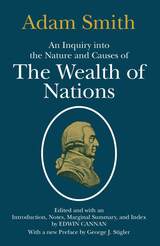 An Inquiry into the Nature and Causes of the Wealth of Nations
Adam Smith
University of Chicago Press, 1977 The foundational text of modern economic thought, the origin of laissez-faire economics and contemporary free market thinking
Adam Smith's The Wealth of Nations was recognized as a landmark of immediately upon publication in 1776. As the first serious, data-driven argument for the principles of political economy, it is the point of departure for all subsequent economic thought. Smith's argument that human self-interest is the primary driver of economic activity, and that in aggregate that self-interest--acting through a market freed from government intervention-guides markets and economies toward the best outcomes for business and society, remains foundational for contemporary free-market economics.
This edition presents the definitive 1904 version of The Wealth of Nations, painstakingly edited by Edwin Cannan and featuring Cannan's illuminating introduction, and notes, as well as a a full index. An additional preface by distinguished economist George J. Stigler places Smith's book and thought in a contemporary context. The result is the best edition of this classic for students and general readers alike.
Inquiry into the Picturesque
Sidney K. Robinson
University of Chicago Press, 1991 The aesthetic mode of the picturesque has undergone so many transformations since its initial discussion in eighteenth-century England that it is hard to say just what it is. In these probing essays, Sidney K. Robinson re-examines the picturesque in its late eighteenth-century phase.
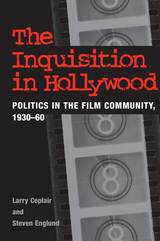 The Inquisition in Hollywood: Politics in the Film Community, 1930-60
Larry Ceplair and Steven Englund
University of Illinois Press, 1979 The definitive work on the Hollywood blacklist era The Inquisition in Hollywood examines the suppression of radical political activity in the film industry from the days of the Great Depression through the tumultuous House Un-American Activities Commission era to the waning days of the infamous blacklist. Although this thirty-year period of American history is marked by widespread targeting of leftists in all areas of life, those in the film industry–-predominately screenwriters–-were considered to be in positions of great potential indoctrinating power, and found themselves under intense scrutiny as the Cold War hysteria mounted. Ceplair and Englund trace the history of political struggle in Hollywood back to the formation of the Screen Writers Guild in 1933. Many of the blacklisted filmmakers were members of the Communist Party and all of the graylisted filmmakers had expressed their sympathy with progressive (mainly anti-fascist) causes. Although no Hollywood Communist has ever been linked to espionage or sabotage, and charges of subversive indoctrination have no basis in documented fact, this book powerfully shows how devastating a mere suspicion or insinuation of guilt could be during the era of the Red Menace. Twenty-two years after its initial publication, The Inquisition in Hollywood remains the definitive work on the blacklist era, and this new edition features a new introduction by the authors.
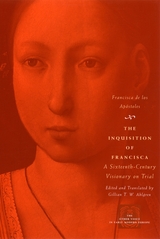 The Inquisition of Francisca: A Sixteenth-Century Visionary on Trial
Francisca de los Apóstoles
University of Chicago Press, 2005 Inspired by a series of visions, Francisca de los Apóstoles (1539-after 1578) and her sister Isabella attempted in 1573 to organize a beaterio, a lay community of pious women devoted to the religious life, to offer prayers and penance for the reparation of human sin, especially those of corrupt clerics. But their efforts to minister to the poor of Toledo and to call for general ecclesiastical reform were met with resistance, first from local religious officials and, later, from the Spanish Inquisition. By early 1575, the Inquisitional tribunal in Toledo had received several statements denouncing Francisca from some of the very women she had tried to help, as well as from some of her financial and religious sponsors. Francisca was eventually arrested, imprisoned by the Inquisition, and investigated for religious fraud.
This book contains what little is known about Francisca—the several letters she wrote as well as the transcript of her trial—and offers modern readers a perspective on the unique role and status of religious women in sixteenth-century Spain. Chronicling the drama of Francisca's interrogation and her spirited but ultimately unsuccessful defense, The Inquisition of Francisca—transcribed from more than three hundred folios and published for the first time in any language—will be a valuable resource for both specialists and students of the history and religion of Spain in the sixteenth century.
The Inquisitor's Diary
Jeffrey Lewis
Haus Publishing, 2013 Set in Mexico City in 1649, when the Spanish Inquisition holds sway, TheInquisitor’s Diary takes the form of the diary of Fray Alonso, the most zealous advocate of their mission, as he struggles to win promotion in the church. Outmaneuvered by his rivals, he is dispatched on a seemingly futile journey to the north, where he unexpectedly befriends a captured heretic—a Marrano, or crypto-Jew—and finds himself questioning all he believes in. Thought-provoking and philosophical, this novel brings the Inquisition to troubling life, with all its moral darkness and complexity.
“We follow Alonso’s journey as he is dispatched by the Inquisitor General to the country’s northern frontier to root out ‘heresy, apostasy, backsliding.’ . . . This somber work seeks to uncover those subterranean impulses that surge beneath Alonso’s fate.”—Literary Review
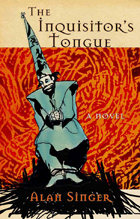 The Inquisitor's Tongue: A Novel
Alan Singer
University of Alabama Press, 2012
Alan Singer’s riveting new novel, The Inquisitor’s Tongue, reimagines the Spanish Inquisition as a world in which spiritual horrors and acts of violence are the birth pangs of otherwise unimaginable identities.
The novel is the intersection of two narratives. The confession of Osvaldo Alonzo de Zamora, a miraculously gifted converso wine taster, is read aloud by a duplicitous priest of the Inquisition as an admonitory lesson to a suspected sinner. The competing narrative is the story of that sinner, another guilt-driven character, referred to only as the “Samaritan,” who curiously is held in the thrall of Osvaldo’s confession. The Samaritan bears the scars of his own history of violence and hidden identity. In the wake of a final apocalypse the two narratives converge, bringing all of the characters together and eliciting the most damning revelation about the identity of the Inquisitor. Set amidst the religious and courtly spectacles of sixteenth-century Spain, The Inquisitor’s Tongue is linguistically adventurous, richly philosophical, deeply visceral, tantalizingly sensuous, and wickedly comic. It is a Goyaesque capricho on the follies of the will to identity.
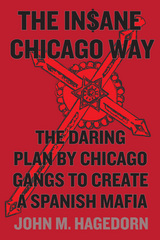 The Insane Chicago Way: The Daring Plan by Chicago Gangs to Create a Spanish Mafia
John M. Hagedorn
University of Chicago Press, 2015 The Insane Chicago Way is the untold story of a daring plan by Chicago gangs in the 1990s to create a Spanish Mafia—and why it failed. John M. Hagedorn traces how Chicago Latino gang leaders, following in Al Capone’s footsteps, built a sophisticated organization dedicated to organizing crime and reducing violence. His lively stories of extensive cross-neighborhood gang organization, tales of police/gang corruption, and discovery of covert gang connections to Chicago’s Mafia challenge conventional wisdom and offer lessons for the control of violence today.
The book centers on the secret history of Spanish Growth & Development (SGD)—an organization of Latino gangs founded in 1989 and modeled on the Mafia’s nationwide Commission. It also tells a story within a story of the criminal exploits of the C-Note$, the “minor league” team of the Chicago’s Mafia (called the “Outfit”), which influenced the direction of SGD. Hagedorn’s tale is based on three years of interviews with an Outfit soldier as well as access to SGD’s constitution and other secret documents, which he supplements with interviews of key SGD leaders, court records, and newspaper accounts. The result is a stunning, heretofore unknown history of the grand ambitions of Chicago gang leaders that ultimately led to SGD’s shocking collapse in a pool of blood on the steps of a gang-organized peace conference.
The Insane Chicago Way is a compelling history of the lives and deaths of Chicago gang leaders. At the same time it is a sociological tour de force that warns of the dangers of organized crime while arguing that today’s relative disorganization of gangs presents opportunities for intervention and reductions in violence.
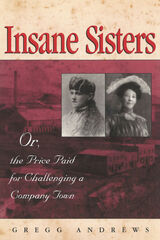 Insane Sisters: Or, the Price Paid for Challenging a Company Town
Gregg Andrews
University of Missouri Press, 2020 Insane Sisters is the extraordinary tale of two sisters, Mary Alice Heinbach and Euphemia B. Koller, and their seventeen- year property dispute against the nation's leading cement corporation—the Atlas Portland Cement Company. In 1903, Atlas built a plant on the border of the small community of Ilasco, located just outside Hannibal—home of the infamous cave popularized in Mark Twain's most acclaimed novels. The rich and powerful Atlas quickly appointed itself as caretaker of Twain's heritage and sought to take control of Ilasco. However, its authority was challenged in 1910 when Heinbach inherited her husband's tract of land that formed much of the unincorporated town site. On grounds that Heinbach's husband had been in the advanced stages of alcoholism when she married him the year before, some of Ilasco's political leaders and others who had ties to Atlas challenged the will, charging Heinbach with undue influence. To help fight against the local lawyers and politicians who wanted Atlas to own the land, Heinbach enlisted the help of her shrewd and combative sister, Euphemia Koller, by making her co-owner of the tract. In a complex case that went to the Missouri Supreme Court four times, the sisters fiercely sought to hang on to the tract. However, in 1921 the county probate court imposed a guardianship over Heinbach and a circuit judge ordered a sheriff's sale of the property. After Atlas purchased the tract, Koller waged a lonely battle to overturn the sale and expose the political conspiracies that had led to Ilasco's conversion into a company town. Her efforts ultimately resulted in her court- ordered confinement in 1927 to Missouri's State Hospital Number One for the Insane, where she remained until her death at age sixty-eight. Insane Sisters traces the dire consequences the sisters suffered and provides a fascinating look at how the intersection of gender, class, and law shaped the history and politics of Ilasco. The book also sheds valuable new light on the wider consolidation of corporate capitalism and the use of guardianships and insanity to punish unconventional women in the early twentieth century.
 Insane Therapy: Portrait of a Psychotherapy Cult
Marybeth F. Ayella
Temple University Press, 1998 Sensational media coverage of groups like Heaven's Gate, the People's Temple, and Synanon is tinged with the suggestion that only crazy, lonely, or gullible people join cults. Cults attract people on the fringe of society, people already on the edge. Contrary to this public perception, Marybeth Ayella reveals how anyone seeking personal change in an intense community setting is susceptible to the lure of group influence. The book begins with the candid story of how one keen skeptic was recruited by Moonies in the 1970s -- the author herself.
Ayella's personal experience fueled her interest in studying the cult phenomenon. This book focuses on her analysis of one community in southern California, The Center for Feeling Therapy, which opened in 1971 as an offshoot of Arthur Janov's Primal Scream approach. The group attracted mostly middle-class, college-educated clients interested in change through intense sessions led by licensed therapists. At the time of the Center's collapse in 1980, there were three hundred individuals living in the therapeutic community and another six hundred outpatients.
Through interviews with twenty-one former patients, the author develops a picture of the positive changes they sought, the pressures of group living, and the allegations of abuse against therapists. Many patients contended that they were beaten, made to strip before the group and to engage in forced sex, forced to have abortions and give up children, and coerced to donate money and to work in business affiliated with the Center.
The close of the Center brought yet more trauma to the patients as they struggled to readjust to mainstream life. Ayella recounts the stories of these individuals, again and again returning to the question of how personal identity is formed and the power of social influences. This book is a key to understanding how "normal" people wind up in cults.
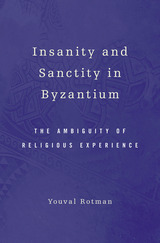 Insanity and Sanctity in Byzantium: The Ambiguity of Religious Experience
Youval Rotman
Harvard University Press, 2016 In the Roman and Byzantine Near East, the holy fool emerged in Christianity as a way of describing individuals whose apparent madness allowed them to achieve a higher level of spirituality. Insanity and Sanctity in Byzantium examines how the figure of the mad saint or mystic was used as a means of individual and collective transformation in the period between the birth of Christianity and the rise of Islam. It presents a novel interpretation in revealing the central role that psychology plays in social and historical development.
Early Christians looked to figures who embodied extremes of behavior—like the holy fool, the ascetic, the martyr—to redefine their social, cultural, and mental settings by reading new values in abnormal behavior. Comparing such forms of extreme behavior in early Christian, pagan, and Jewish societies, and drawing on theories of relational psychoanalysis, anthropology, and sociology of religion, Youval Rotman explains how the sanctification of figures of extreme behavior makes their abnormality socially and psychologically functional. The sanctification of abnormal mad behavior created a sphere of ambiguity in the ambit of religious experience for early Christians, which brought about a deep psychological shift, necessary for the transition from paganism to Christianity.
A developing society leaves porous the border between what is normal and abnormal, between sanity and insanity, in order to use this ambiguity as a means of change. Rotman emphasizes the role of religion in maintaining this ambiguity to effect a social and psychological transformation.
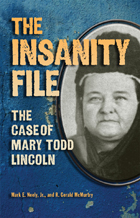 The Insanity File: The Case of Mary Todd Lincoln
Mark E. Neely Jr. and R. Gerald McMurtry
Southern Illinois University Press, 1993 In 1875 Robert Todd Lincoln caused his mother, Mary Todd Lincoln, to be committed to an insane asylum. Based on newly discovered manuscript materials, this book seeks to explain how and why. In these documents—marked by Robert Todd Lincoln as the "MTL Insanity File"—exists the only definitive record of the tragic story of Mary Todd Lincoln’s insanity trial. The book that results from these letters and documents addresses several areas of controversy in the life of the widow of Abraham Lincoln: the extent of her illness, the fairness of her trial, and the motives of those who had her committed for treatment. Related issues include the status of women under the law as well as the legal and medical treatment of insanity. Speculating on the reasons for her mental condition, the authors note that Mrs. Lincoln suffered an extraordinary amount of tragedy in a relatively few years. Three of her four sons died very young, and Abraham Lincoln was assassinated. After the death of her son Willie she maintained a darkly rigorous mourning for nearly three years, prompting the president to warn her that excessive woe might force him to send her to "that large white house on the hill yonder," the government hospital for the insane. Mrs. Lincoln also suffered anxiety about money, charting an exceptionally erratic financial course. She had spent lavishly during her husband’s presidency and at his death found herself deeply in debt. She had purchased trunkfuls of drapes to hang over phantom windows. 84 pairs of kid gloves in less than a month, and $3,200 worth of jewelry in the three months preceding Lincoln’s assassination. She followed the same erratic course for the rest of her life, creating in herself a tremendous anxiety. She occasionally feared that people were trying to kill her, and in 1873 she told her doctor that an Indian spirit was removing wires from her eyes and bones from her cheeks. Her son assembled an army of lawyers and medical experts who would swear in court that Mrs. Lincoln was insane. The jury found her insane and in need of treatment in an asylum. Whether the verdict was correct or not, the trial made Mary Lincoln desperate. Within hours of the verdict she would attempt suicide. In a few months she would contemplate murder. Since then every aspect of the trial has been criticized—from the defense attorney to the laws in force at the time. Neely and McMurtry deal with the trial, the commitment of Mary Todd Lincoln, her release, and her second trial. An appendix features letters and fragments by Mrs. Lincoln from the "Insanity File." The book is illustrated by 25 photographs.
Insatiability
Stanislaw Ignacy Witkiewicz, translated from the Polish by Louis Iribarne
Northwestern University Press, 1994 Witkiewicz's 1927 masterpiece, made famous in Polish dissident and Nobel laureate Czesław Miłosz's The Captive Mind, is one of the most unforgettable depictions of the tensions and trade-offs between ideological loyalty and individual conscience in world literature. Futuristic, experimental, and remarkably prophetic, Insatiability traces the choices of a young Pole as his divided nation both opposes and welcomes a communitarian invasion from the east offering a narcotic that both removes anxieties and induces obedience. An anti-Utopian classic, it foretold the irresoluble and sometimes deadly choices that faced Eastern European thinkers, writers, and politicians during the years of Soviet domination.
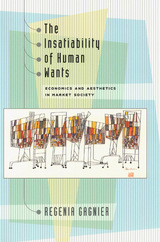 The Insatiability of Human Wants: Economics and Aesthetics in Market Society
Regenia Gagnier
University of Chicago Press, 2000 What is the relationship between our conception of humans as producers or creators; as consumers of taste and pleasure; and as creators of value? Combining cultural history, economics, and literary criticism, Regenia Gagnier's new work traces the parallel development of economic and aesthetic theory, offering a shrewd reading of humans as workers and wanters, born of labor and desire.
The Insatiability of Human Wants begins during a key transitional moment in aesthetic and economic theory, 1871, when both disciplines underwent a turn from production to consumption models. In economics, an emphasis on the theory of value and the social relations between land, labor, and capital gave way to more individualistic models of consumerism. Similarly, in aesthetics, theories of artistic production or creativity soon bowed to models of taste, pleasure, and reception.
Using these developments as a point of departure, Gagnier deftly traces the shift in Western thought from models of production to consumption. From its exploration of early market logic and Kantian thought to its look at the aestheticization of homelessness and our own market boom, The Insatiability of Human Wants invites us to contemplate alternative interpretations of economics, aesthetics, and history itself.
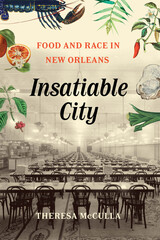 Insatiable City: Food and Race in New Orleans
Theresa McCulla
University of Chicago Press, 2024 A 2025 James Beard Foundation Book Award Nominee in Reference, History, and Scholarship and a Smithsonian Best Book of 2024
A history of food in the Crescent City that explores race, power, social status, and labor.
In Insatiable City, Theresa McCulla probes the overt and covert ways that the production of food and the discourse about it both created and reinforced many strains of inequality in New Orleans, a city significantly defined by its foodways. Tracking the city’s economy from nineteenth-century chattel slavery to twentieth-century tourism, McCulla uses menus, cookbooks, newspapers, postcards, photography, and other material culture to limn the interplay among the production and reception of food, the inscription and reiteration of racial hierarchies, and the constant diminishment and exploitation of working-class people. The consumption of food and people, she shows, was mutually reinforced and deeply intertwined. Yet she also details how enslaved and free people of color in New Orleans used food and drink to carve paths of mobility, stability, autonomy, freedom, profit, and joy. A story of pain and pleasure, labor and leisure, Insatiable City goes far beyond the task of tracing New Orleans's culinary history to focus on how food suffuses culture and our understandings and constructions of race and power.
 Insatiable City: Food and Race in New Orleans
Theresa McCulla
University of Chicago Press, 2024 This is an auto-narrated audiobook version of this book.
A history of food in the Crescent City that explores race, power, social status, and labor.
In Insatiable City, Theresa McCulla probes the overt and covert ways that the production of food and the discourse about it both created and reinforced many strains of inequality in New Orleans, a city significantly defined by its foodways. Tracking the city’s economy from nineteenth-century chattel slavery to twentieth-century tourism, McCulla uses menus, cookbooks, newspapers, postcards, photography, and other material culture to limn the interplay among the production and reception of food, the inscription and reiteration of racial hierarchies, and the constant diminishment and exploitation of working-class people. The consumption of food and people, she shows, was mutually reinforced and deeply intertwined. Yet she also details how enslaved and free people of color in New Orleans used food and drink to carve paths of mobility, stability, autonomy, freedom, profit, and joy. A story of pain and pleasure, labor and leisure, Insatiable City goes far beyond the task of tracing New Orleans's culinary history to focus on how food suffuses culture and our understandings and constructions of race and power.
Inscribed: Encounters with the Ten Commandments
Rabbi Oren J. Hayon
Central Conference of American Rabbis, 2020 This anthology gives voice to the many diverse and contemporary perspectives about each of the Ten Commandments. Written by an impressive collection of rabbis and scholars, the volume allots multiple chapters for each of the commandments in order to engage with the ways in which these timeless utterances have inspired contemporary laws, ethics, and moral guidelines.
Silver medal: Independent Publisher Book Award (Religion category)
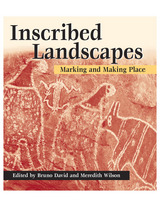 Inscribed Landscapes: Marking and Making Place
edited by Bruno David and Meredith Wilson
University of Hawaii Press, 2002 Landscapes all over the world are inscribed with enduring physical marks. Socially constructed and engaged, landscape inscriptions (monuments, roads, gardens, rock-art) are foci of social experience and as such are symbolic expressions that mold and facilitate the transmission of ideas. Through inscription, landscapes become social arenas where the past is memorialized, where personal roots, ambitions, and attachments are laid, and where futures unfold.
Inscribed Landscapes explores the role of inscription in the social construction of place, power, and identity. Bringing together twenty-one scholars across a range of fields--primarily archaeology, anthropology, and geography--it discusses how social codes and hegemonic practices have resulted in the production of particular senses of place, exploring the physical and metaphysical marking of place as a means of accessing social history.
Two major conceptual themes link the chapters of this book: social participation and resistance. Participation involves interrelationships between people and place, the way inscribed environments and social experience intertwine; resistance relates to the rejection of modes of domination and their inscription in the landscape. The volume explores these themes in three parts: the first focuses on rock-art, the second on monuments, and the third describes how the physical and metaphysical articulate to inscribe places with meaning.
Inscribing the Daily: Critical Essays on Women's Diaries
Suzanne L. Bunkers
University of Massachusetts Press, 1996 These fifteen essays explore the rich texture of women's diaries written in America and Europe over the past two centuries. The authors use a variety of critical methodologies to examine the diary as a text, as a form of women's self-inscription, as a window to the diarists' historical and contemporary lives, and as a theoretical tool that allows us to question longstanding assumptions.
Inscriptions
Charles William Eliot
Harvard University Press One of President Eliot’s minor claims to fame is as a writer of numerous inscriptions for all sorts of monuments, memorial tablets, public buildings, churches, and schools. His success in this difficult form of composition was due in large measure to his gift for concise and descriptive phrasing. Frequently during his last years he was asked to list his inscriptional writings, but painstakingly as they had been prepared, he had kept almost no record of them and could no longer recall them. Fifty of them have now been gathered, after considerable research, in this volume as a fitting contribution to the centenary celebration of his birth.
Inscriptions: After Phenomenology and Structuralism
Hugh J. Silverman
Northwestern University Press, 1997 Positioning itself within the Continental tradition, Inscriptions is an interwoven set of investigations into the differences between phenomenology and structuralism, and a cohesive and thoroughgoing inquiry into the contemporary status of Continental philosophy.
In Inscriptions, Hugh J. Silverman investigates two divergent yet related philosophical movements: phenomenology from the later Husserl through Sartre and Heidegger to Merleau-Ponty, and structuralism from de Saussure through Levi-Strauss and Lacan to Barthes. This reading of the tradition culminates in an assessment of Derrida and Foucault. From this foundation, Silverman moves beyond structuralism and phenomenology, and develops his own philosophical position in the context of semiotics, hermeneutics, and deconstruction. A new preface by the author updates this classic text.
The Inscriptions of Calakmul: Royal Marriage at a Maya City in Campeche, Mexico
Joyce Marcus
University of Michigan Press, 1987 Calakmul is a large Maya site in the Yucatán Peninsula of southern Mexico, just north of Tikal and the Guatemala border. In the 1980s, Joyce Marcus sketched and photographed the inscriptions on the monuments of Calakmul, in an effort to understand the nature of Maya territorial organization through the hieroglyphic record. Through the inscriptions, she was able to identify a sequence of rulers and royal couples, and their association with temples and other architecture at the site. Foreword by William J. Folan.
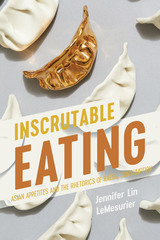 Inscrutable Eating: Asian Appetites and the Rhetorics of Racial Consumption
Jennifer Lin LeMesurier
Ohio State University Press, 2023 “You are what you eat,” but what if you’re seen as a rat eater, bat lover, or MSG user? In Inscrutable Eating, Jennifer Lin LeMesurier considers how everyday assumptions about Asian food influence the perception of Asian and Asian American identity within the US racial landscape, demonstrating that beliefs about how certain people eat are inseparable from attitudes that support hierarchies around race, gender, and sexuality. Drawing on rhetorical theory, affect theory, and Asian American studies, LeMesurier analyzes messages in US popular culture about Asian eating to develop the concept of gut orientations: rhetorically dominant ways of interacting with food that scale upward to feelings of desire and disgust toward social groups. Looking at examples from fears around MSG to uproar over wet markets as the source of COVID-19, she argues that these “gut” reactions establish certain racial views as common-sense truths rather than cultural biases, reinforcing dominant norms about what belongs on whose plate, or who belongs at what table. In demystifying marginalizing discourse around food and eating, LeMesurier shows how exposing the tacit, felt ideas of consumption is necessary to contest broader forms of discrimination.
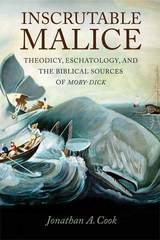 Inscrutable Malice: Theodicy, Eschatology, and the Biblical Sources of Moby-Dick
Jonathan A. Cook
Northern Illinois University Press, 2012 In Inscrutable Malice, Jonathan A. Cook expertly illuminates Melville’s abiding preoccupation with the problem of evil and the dominant role of the Bible in shaping his best-known novel. Drawing on recent research in the fields of biblical studies, the history of religion, and comparative mythology, Cook provides a new interpretation of Moby-Dick that places Melville’s creative adaptation of the Bible at the center of the work. Cook identifies two ongoing concerns in the narrative in relation to their key biblical sources: the attempt to reconcile the goodness of God with the existence of evil, as dramatized in the book of Job; and the discourse of the Christian end-times involving the final destruction of evil, as found in the apocalyptic books and eschatological passages of the Old and New Testaments. With his detailed reading of Moby-Dick in relation to its most important source text, Cook greatly expands the reader’s understanding of the moral, religious, and mythical dimensions of the novel. Both accessible and erudite, Inscrutable Malice will appeal to scholars, students, and enthusiasts of Melville’s classic whaling narrative.
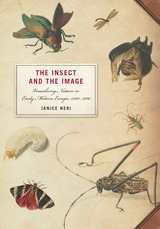 The Insect and the Image: Visualizing Nature in Early Modern Europe, 1500-1700
Janice Neri
University of Minnesota Press, 2011 Once considered marginal members of the animal world (at best) or vile and offensive creatures (at worst), insects saw a remarkable uptick in their status during the early Renaissance. This quickened interest was primarily manifested in visual images—in illuminated manuscripts, still life paintings, the decorative arts, embroidery, textile design, and cabinets of curiosity. In The Insect and the Image, Janice Neri explores the ways in which such imagery defined the insect as a proper subject of study for Europeans of the early modern period. It was not until the sixteenth century that insects began to appear as the sole focus of paintings and drawings—as isolated objects, or specimens, against a blank background. The artists and other image makers Neri discusses deployed this “specimen logic” and so associated themselves with a mode of picturing in which the ability to create a highly detailed image was a sign of artistic talent and a keenly observant eye. The Insect and the Image shows how specimen logic both reflected and advanced a particular understanding of the natural world—an understanding that, in turn, supported the commodification of nature that was central to global trade and commerce during the early modern era. Revealing how sixteenth- and seventeenth-century artists and image makers shaped ideas of the natural world, Neri’s work enhances our knowledge of the convergence of art, science, and commerce today.
 Insect Lives: Stories of Mystery and Romance from a Hidden World
Edited by Erich Hoyt and Ted Schultz
Harvard University Press Insects inhabit an often unexamined microcosmos, pursuing lives that are often strange beyond our wildest imaginings. From the dawn of humanity, our six-legged fellow Earthlings have repelled and enthralled us. Humans have exterminated, eaten, domesticated, and even excommunicated insects. We collect them, we curse them, and we have penned a surprising body of literature about them.
Insect Lives: Stories of Mystery and Romance from a Hidden World offers an entertaining and informative survey of the human fascination, dreadful and otherwise, with insects diabolical and divine, from accounts in the Bible and Aristotle to the writings of Charles Darwin and the great nineteenth-century naturalists sending home accounts from the rain forest. Highlighted here are observations from E. O. Wilson, Jean-Henri Fabré, David Quammen, May Berenbaum, Roger Swain, William Wordsworth, A. S. Byatt, Gary Larson and more than sixty other writers who tell of the mystery and romance of that other, hidden world beneath our feet and beyond our rolled-up newspapers.
 Insect Media: An Archaeology of Animals and Technology
Jussi Parikka
University of Minnesota Press, 2010 Since the early nineteenth century, when entomologists first popularized the unique biological and behavioral characteristics of insects, technological innovators and theorists have proposed insects as templates for a wide range of technologies. In Insect Media, Jussi Parikka analyzes how insect forms of social organization-swarms, hives, webs, and distributed intelligence-have been used to structure modern media technologies and the network society, providing a radical new perspective on the interconnection of biology and technology.
Through close engagement with the pioneering work of insect ethologists, including Jakob von Uexküll and Karl von Frisch, posthumanist philosophers, media theorists, and contemporary filmmakers and artists, Parikka develops an insect theory of media, one that conceptualizes modern media as more than the products of individual human actors, social interests, or technological determinants. They are, rather, profoundly nonhuman phenomena that both draw on and mimic the alien lifeworlds of insects.
Deftly moving from the life sciences to digital technology, from popular culture to avant-garde art and architecture, and from philosophy to cybernetics and game theory, Parikka provides innovative conceptual tools for exploring the phenomena of network society and culture. Challenging anthropocentric approaches to contemporary science and culture, Insect Media reveals the possibilities that insects and other nonhuman animals offer for rethinking media, the conflation of biology and technology, and our understanding of, and interaction with, contemporary digital culture.
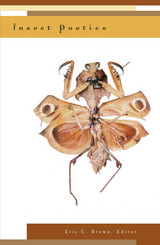 Insect Poetics
Eric C. Brown
University of Minnesota Press, 2006 Insects are everywhere. There are millions of species sharing the world with humans and other animals. Though literally woven into the fabric of human affairs, insects are considered alien from the human world. Animal studies and rights have become a fecund field, but for the most part scant attention has been paid to the relationship between insects and humans. Insect Poetics redresses that imbalance by welcoming insects into the world of letters and cultural debate.
In Insect Poetics, the first book to comprehensively explore the cultural and textual meanings of bugs, editor Eric Brown argues that insects are humanity’s “other.” In order to be experienced, the insect world must be mediated by art or technology (as in the case of an ant farm or Kafka’s Metamorphoses) while humans observe, detached and fascinated.
In eighteen original essays, this book illuminates the ways in which our human intellectual and cultural models have been influenced by the natural history of insects. Through critical readings contributors address such topics as performing insects in Shakespeare’s Coriolanus, the cockroach in the contemporary American novel, the butterfly’s “voyage out” in Virginia Woolf, and images of insect eating in literature and popular culture. In surprising ways, contributors tease out the particularities of insects as cultural signifiers and propose ways of thinking about “insectivity,” suggesting fertile cross-pollinations between entomology and the arts, between insects and the humanities.
Contributors: May Berenbaum, Yves Cambefort, Marion W. Copeland, Nicky Coutts, Bertrand Gervais, Sarah Gordon, Cristopher Hollingsworth, Heather Johnson, Richard J. Leskosky, Tony McGowan, Erika Mae Olbricht, Marc Olivier, Roy Rosenstein, Rachel Sarsfield, Charlotte Sleigh, Andre Stipanovic.
Eric C. Brown is assistant professor of English at the University of Maine at Farmington. He has written previously about insects and eschatology in Edmund Spenser’s Muiopotmos.
The Insect Societies
Edward O. Wilson
Harvard University Press, 1971 This book is a work of major importance for the development of environmental and behavioral biology; it covers the classification, evolution, anatomy, physiology, and behavior of the higher social insects—ants, social wasps and bees, and termites. Edward O. Wilson reinterprets the knowledge of these insects through the concepts of modern biology, from biochemistry to evolutionary theory and population ecology.
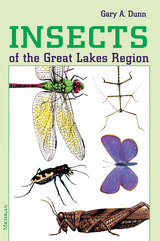 Insects of the Great Lakes Region
Gary A. Dunn
University of Michigan Press, 1996 The insects are the world's most amazing animals and comprise over eighty-five percent of the known animal species. Insects of the Great Lakes Region is the first comprehensive guide to document the rich and diverse insect fauna of the Great Lakes region. In Insects of the Great Lakes Region, educators, insect enthusiasts, and the general public will find high-quality, well-presented, easy-to-understand information with over 250 illustrations of the insects found in yards, gardens, fields, and forests. Among the topics discussed are the geological, biological, and entomological history of the Great Lakes region, the distributional patterns of insects in the Great Lakes region, and insect classification and identification. Appendixes guide the reader to entomological organizations, entomological periodicals, public insect collections, regulations on collecting insects from public lands in the Great Lakes region, as well as rare, threatened, and endangered insects. This guide shows the amateur entomologist everything he needs to know, from where to collect milkweed bugs to how often to feed his pet tarantula. Gary Dunn is Executive Director and Editor, Young Entomologists' Society, Inc., International Headquarters, Lansing, Michigan.
Insects on Plants: Community Patterns and Mechanisms
D. R. Strong, J. H. Lawton, and Sir Richard Southwood
Harvard University Press, 1984 Much community theory has ignored insects on plants, although they comprise a large proportion of extant organisms. In this text the authors review the evolution and recent history of phytophagous insects and consider the structure of phytophage communities, with the aim of bringing the study of such communities into the mainstream of ecological thought. They combine the synthetic, pattern-searching approach to community ecology with reductionist methods which isolate single mechanisms for study in a stimulating text will interest senior undergraduates and research workers in the fields of entomology, ecology, agriculture and botany.
Insects through the Seasons
Gilbert Waldbauer
Harvard University Press, 1996 They appeared on earth 400 million years ago, long before the first reptile, bird, or mammal. They make up about 75 percent of the 1.2 million currently known species of animals. As many as 30,000 of them coexist and interact in one square yard of the top inch of a forest's soil. The unparalleled success of insects is the story told in this highly entertaining book. How do these often tiny but indefatigable creatures do it? Gilbert Waldbauer pursues this question from hot springs and Himalayan slopes to roadsides and forests, scrutinizing insect life in its many manifestations. Insects through the Seasons will educate and charm the expert, the passionate amateur, and the merely curious about our most populous and tenacious neighbors.
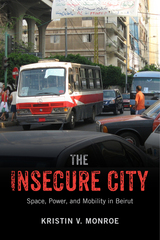 The Insecure City: Space, Power, and Mobility in Beirut
Monroe, Kristin V
Rutgers University Press, 2016 Fifteen years after the end of a protracted civil and regional war, Beirut broke out in violence once again, forcing residents to contend with many forms of insecurity, amid an often violent political and economic landscape. Providing a picture of what ordinary life is like for urban dwellers surviving sectarian violence, The Insecure City captures the day-to-day experiences of citizens of Beirut moving through a war-torn landscape. While living in Beirut, Kristin Monroe conducted interviews with a diverse group of residents of the city. She found that when people spoke about getting around in Beirut, they were also expressing larger concerns about social, political, and economic life. It was not only violence that threatened Beirut’s ordinary residents, but also class dynamics that made life even more precarious. For instance, the installation of checkpoints and the rerouting of traffic—set up for the security of the elite—forced the less fortunate to alter their lives in ways that made them more at risk. Similarly, the ability to pass through security blockades often had to do with an individual’s visible markers of class, such as clothing, hairstyle, and type of car. Monroe examines how understandings and practices of spatial mobility in the city reflect social differences, and how such experiences led residents to be bitterly critical of their government. In The Insecure City, Monroe takes urban anthropology in a new and meaningful direction, discussing traffic in the Middle East to show that when people move through Beirut they are experiencing the intersection of citizen and state, of the more and less privileged, and, in general, the city’s politically polarized geography. Download open access ebook here.
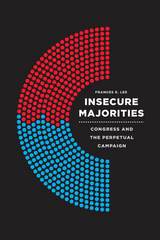 Insecure Majorities: Congress and the Perpetual Campaign
Frances E. Lee
University of Chicago Press, 2016 As Democrats and Republicans continue to vie for political advantage, Congress remains paralyzed by partisan conflict. That the last two decades have seen some of the least productive Congresses in recent history is usually explained by the growing ideological gulf between the parties, but this explanation misses another fundamental factor influencing the dynamic. In contrast to politics through most of the twentieth century, the contemporary Democratic and Republican parties compete for control of Congress at relative parity, and this has dramatically changed the parties’ incentives and strategies in ways that have driven the contentious partisanship characteristic of contemporary American politics.
With Insecure Majorities, Frances E. Lee offers a controversial new perspective on the rise of congressional party conflict, showing how the shift in competitive circumstances has had a profound impact on how Democrats and Republicans interact. For nearly half a century, Democrats were the majority party, usually maintaining control of the presidency, the House, and the Senate. Republicans did not stand much chance of winning majority status, and Democrats could not conceive of losing it. Under such uncompetitive conditions, scant collective action was exerted by either party toward building or preserving a majority. Beginning in the 1980s, that changed, and most elections since have offered the prospect of a change of party control. Lee shows, through an impressive range of interviews and analysis, how competition for control of the government drives members of both parties to participate in actions that promote their own party’s image and undercut that of the opposition, including the perpetual hunt for issues that can score political points by putting the opposing party on the wrong side of public opinion. More often than not, this strategy stands in the way of productive bipartisan cooperation—and it is also unlikely to change as long as control of the government remains within reach for both parties.
 Insecurities of Expulsion: Afro-Asian Entanglements in Transcontinental Uganda
Anneeth Kaur Hundle
Duke University Press, 2025 In 1972, Ugandan president Idi Amin expelled close to 80,000 South Asians of Ugandan heritage from the country by dictatorial decree. In Insecurities of Expulsion, Anneeth Kaur Hundle revisits this weighty historical event, arguing that it is neither an exceptional nor a parochial event, neither a result of primordial Afro-South Asian racial conflict nor an opening into a redemptive search for Afro-South Asian interracial solidarities. Hundle explores the aftermaths and continuous nature of the expulsion event, examining its effects and affects; the images, representations, and differentiated experiences and memories of the event; and the tense and ambivalent practices of citizenship, sovereignty, and governance that have emerged in the decades following the expulsion. She examines Afro-Asian entanglements in what she describes as transcontinental Uganda through the lenses of race, ethnicity, class, caste, religion, gender, and sexuality. Throughout, Hundle argues for stronger attention to knowledge production on global Afro-South Asian connections and the continued dynamics of community, citizenship, and identity on the African Continent as central to envisioning Black African self-determinism, racial reconciliation, and interracial pluralisms during shifting imperial, postcolonial, nationalist, and geopolitical times.
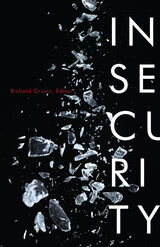 Insecurity
Richard Grusin
University of Minnesota Press, 2022 Investigating insecurity as the predominant logic of life in the present moment
Challenging several key concepts of the twenty-first century, including precarity, securitization, and resilience, this collection explores the concept of insecurity as a predominant logic governing recent cultural, economic, political, and social life in the West. The essays illuminate how attempts to make human and nonhuman systems secure and resilient end up having the opposite effect, making insecurity the default state of life today. Unique in its wide disciplinary breadth and variety of topics and methodological approaches—from intellectual history and cultural critique to case studies, qualitative ethnography, and personal narrative—Insecurity is written predominantly from the viewpoint of the United States. The contributors’ analyses include the securitization of nongovernmental aid to Palestine, Bangladeshi climate refugees, and the privatization of U.S. military forces; the history of the concept of insecurity and the securitization of finance; racialized urban development in Augusta, Georgia; Amazon’s Mechanical Turk and the consequences of the Marie Kondo method; and the intricate politics of sexual harassment in the U.S. academy. Contributors: Neel Ahuja, U of California, Santa Cruz; Aneesh Aneesh, U of Wisconsin, Milwaukee; Lisa Bhungalia, Kent State U; Jennifer Doyle, U of California, Riverside; Annie McClanahan, U of California, Irvine; Andrea Miller, Florida Atlantic U; Mark Neocleous, Brunel U London; A. Naomi Paik, U of Illinois, Chicago; Maureen Ryan, U of South Carolina; Saskia Sassen, Columbia U.
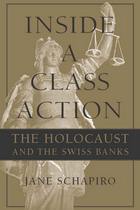 Inside a Class Action: The Holocaust and the Swiss Banks
Jane Schapiro
University of Wisconsin Press, 2003 On October 21, 1996, attorney Michael Hausfeld, with a team of lawyers, filed a class-action complaint against Union Bank of Switzerland, Swiss Bank Corporation, and Credit Suisse on behalf of Holocaust victims. The suit accused the banks of, among other things, acting as the chief financiers for Nazi Germany. Hausfeld wanted to use the suit to prove that the banks not only concealed and refused to return millions of dollars in dormant accounts, but that they acted as a conduit for looted assets and slave labor profits. Such behavior, he charged, violated the code of ethics known as customary international law. On August 12, 1998, the plaintiffs and banks reached a $1.25 billion settlement.
Through interviews with a wide range of people involved in the case and detailed research of documents and court transcripts, Jane Schapiro shows the ways that egos, personalities, and values clash in such a complex and emotionally charged case. Inside a Class Action provides an insider’s view of a major lawsuit from its inception to its conclusion, which will appeal to anyone interested in human rights, reparations, and international law.
Inside a Service Trade: Studies in Contemporary Chinese Prose
Rudolph Wagner
Harvard University Press, 1992 Within a tightly controlled environment, literature has become the major screen onto which the political class of the People’s Republic of China projects some of its battles. This work explores the potential of literary analysis for illuminating the PRC’s social, intellectual, and political history, illustrating swings in the Party line with stories, articles, and cartoons from the popular press. This book presents materials hitherto scarcely topped and should offer new insights to those interested in Chinese literature, Russian and East European literature, and modern social and political history.
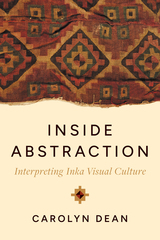 Inside Abstraction: Interpreting Inka Visual Culture
Carolyn Dean
University of Texas Press, 2025 Illuminating the abstract art of the Inka, what it conveys about Inka values, and its relationship to those who view it. Inka visual culture is unusual in its tendency toward abstraction. Public stonework, vessels used at state feasts, garments worn by the imperial elite—these objects announcing status and power are adorned with geometric designs that refuse figuration. After searching in vain for hidden referents, many scholars have largely given up the search for meaning. Inside Abstraction develops a novel interpretation. Eminent art historian Carolyn Dean proposes that Inka geometries are neither ornamental nor coded depictions of other objects. Rather, Dean shows that in the Andean world, the designs were functionally self-aware, possessing perspectives of their own, quite literally looking back at and addressing viewers directly. Further, Dean contends that these agent-abstractions were teachers, conveying particular messages concerning social hierarchy: the relations among geometries and colors instructed viewers as to their own proper social relations. Inka designs thereby served imperial aims by wordlessly communicating the state’s values and demands for submission. Extensively illustrated and rigorously argued, Inside Abstraction is a dramatic step forward in our understanding of Inka art and political order.
Inside Academia: Professors, Politics, and Policies
Cahn, Steven M
Rutgers University Press, 2019 Drawing on decades of experience as a renowned teacher, advisor, administrator, and philosopher, Steven M. Cahn diagnoses problems plaguing America’s universities and offers his prescriptions for improvement. He explores numerous aspects of academic life, including the education of graduate students, the quality of teaching, the design of liberal arts curricula, and the procedures for appointing faculty and considering them for tenure.
Inside Academia uses real cases to illustrate how faculty members, deans, and provosts often do not serve the best interests of schools or students. Yet the book also highlights efforts of those who have committed themselves and their institutions to the pursuit of academic excellence.
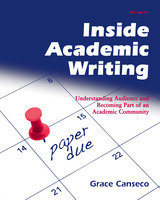 Inside Academic Writing: Understanding Audience and Becoming Part of an Academic Community
Grace Canseco
University of Michigan Press, 2010 Inside Academic Writing is designed to prepare students in any academic discipline for graduate-level writing. The text situates students within their writing communities by prioritizing the steps of learning; students are directed to use common threads of academic writing across disciplines. The goal of Inside Academic Writing is to give students the opportunity to write for a variety of audiences and to develop the knowledge necessary to recognize how to write for different audiences and purposes. Inside Academic Writing allows students to examine basic assumptions about writing before they learn specific strategies for targeting the audience or mapping the flow of information. Through the material in this textbook, students will create a portfolio of writings that includes a biographical statement and a research interest essay—important pieces of writing that are rarely taught in courses. Other types of writing featured are a summary, a problem-solution text, a comparative structure paper, and a commentary. Other textbooks prepare students for graduate writing, but Inside Academic Writing was designed to bridge the gap between non-academic writing and the writing required within an academic community, with one’s peers, colleagues, and field experts. In addition, Inside Academic Writing offers guidance on writing materials for grants, fellowships, conferences, and publication.
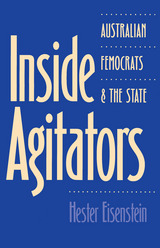 Inside Agitators: Australian Femocrats and the State
Hester Eisenstein
Temple University Press, 1996 Is a "woman-friendly" state possible? Can women achieve full social citizenship? At a time when backlash against people of color, women, and the poor is accelerating, this account of the experiences of Australian feminists is illuminating: Australian feminists succeeded in making women's issues like child care and domestic violence part of the main stream political agenda. Inside Agitators is the first full-length study of the Australian femocrats published in the United States.
Hester Eisenstein (herself a former femocrat) chronicles the efforts of a cohort of women, feminist bureaucrats, who changed the gender landscape--from the initial invitation to enter government by Labor in 1973 to the rise of neo-liberalism and the contemporary attack on the public sector. Connecting the femocrats to specifically Australian features of political culture and political economy, this book analyzes the implicit political theory of the femocrats. Eisenstein addresses the issues of strategies for social change, class, race and racism, sexuality and sexual politics, "gendered" experience, and accountability to the women's movement.
This important study explores the possibilities and limits of the contemporary attempt by the women's movement to constitute women as a "gender interest," and to use state power as an instrument for social change.
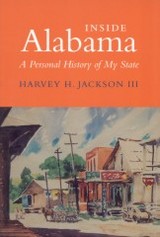 Inside Alabama: A Personal History of My State
Harvey H. Jackson, III
University of Alabama Press, 2003 An affectionate, irreverent, candid look at the "Heart of Dixie"
This book tells Alabama’s history in a conversational style with an unapologetically subjective approach. Accessible to general readers and students alike, it recounts the history and politics of a state known for its colorful past, told by one of the state’s most noted historians and educators, whose family came to the territory before statehood. A native and resident Alabamian, Harvey Jackson has spent a lifetime discovering and trying to understand his state. Expressing deep love for its people and culture, he is no less critical of its shortcomings.
Inside Alabama, as the title implies, gives Jackson’s insider perspective on the events and conditions that shaped modern-day Alabama. With humor and candor, he explores the state’s cultural, political, and economic development from prehistoric times to the dawning of the new millennium. Mound-builders, Hernando de Soto, William Bartram, Red Sticks, Andy Jackson, Bourbon Democrats, suffragettes, New Dealers, Hugo Black, Martin Luther King Jr., George Wallace, Rosa Parks all play colorful parts in this popular history. By focusing on state politics as the most accessible and tangible expression of these shaping forces, Jackson organizes the fourteen chapters chronologically, artfully explaining why the past is so important today.
 Inside Al-Qaeda and the Taliban: Beyond Bin Laden and 9/11
Syed Saleem Shahzad
Pluto Press, 2011 President Obama may have delivered on his campaign promise to kill Osama bin Laden, but as an Al-Qaeda strategist, bin Laden has been dead for years. This book introduces and examines the new generation of Al-Qaeda leaders who have been behind the most recent attacks. _ Investigative journalist Syed Saleem Shahzad dedicated his life to revealing the strategies and inner workings of Al-Qaeda and the Taliban. He had access to top-level commanders in both movements, as well as within the ISI, Pakistan’s intelligence service. Shahzad’s work was praised by US Secretary of State Hillary Clinton for "bringing to light the troubles extremism poses to Pakistan's stability." Inside Al-Qaeda and the Taliban explains the wider aims of both organizations and provides an essential analysis of major terrorist incidents, including the 2008 Mumbai attacks. _ In May 2011, Shahzad was abducted and killed in Pakistan, days after writing an article suggesting that insiders in the Pakistani navy had colluded with Al-Qaeda in an attack on a naval air station. This book is a testament to his fearless reporting and analytical rigor. It will provide readers worldwide with invaluable insights into the new phase of the ongoing struggle against terrorism which threatens to tear apart the fragile fabric of so many countries.
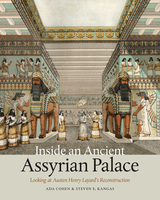 Inside an Ancient Assyrian Palace: Looking at Austen Henry Layard's Reconstruction
Ada Cohen and Steven E. Kangas
University Press of New England, 2016 One of the best-known images of the ancient Near East is an intriguing nineteenth-century color lithograph reconstructing the throne room of an Assyrian palace. Executed shortly after the archaeological rediscovery of Assyria, a land theretofore known only from the Bible, it was published by the most famous among early excavators of Assyrian ruins, Austen Henry Layard. Over time and despite criticisms, the picture has shaped the understanding and reception of ancient Mesopotamian architecture and architectural decoration. Inside an Ancient Assyrian Palace studies this influential image in depth, both at the time of its creation in London in the eventful year 1848 and in terms of its afterlife. A hidden inscription reveals unsuspected contributions by the renowned architect-designer Owen Jones and his colleague the architect-Egyptologist Joseph Bonomi. Also unexpected is the involvement of an enigmatic German artist who later emigrated to America and whose previous career in Europe had been lost to scholarship. This book will be of interest to scholars and students of art history and the ancient Near East. It will also be of relevance to museum visitors and others interested in the ancient world in general, in the art of the nineteenth century, and in design and historical reconstruction.
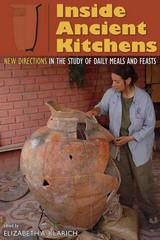 Inside Ancient Kitchens: New Directions in the Study of Daily Meals and Feasts
Elizabeth A. Klarich
University Press of Colorado, 2010 The anthropology of food is an area of research in which economic, social, and political dynamics interact in incredibly complex ways. Using archaeological case studies from around the globe, Inside Ancient Kitchens presents new perspectives on the comparative study of prehistoric meals from Peru to the Philippines. Inside Ancient Kitchens builds upon the last decade of feasting studies and presents two unique goals for broadening the understanding of prehistoric meals. First, the volume focuses on the study of meal preparation through the analysis of temporary and permanent kitchen areas. This move to focus "behind the scenes" is aimed at determining how, where, and by whom meals were financed and prepared. Secondly, data from these preparation contexts are used to differentiate between household-level and suprahousehold-level meals in each case study, resulting in more nuanced typologies of daily meals, feasts, and other food-related events. Inside Ancient Kitchens presents an important step in the development of new methodological and theoretical approaches within the anthropology of food and will be of great interest to scholars studying the social dynamics, labor organization, and political relationships underlying prehistoric meals.
 Inside Appellate Courts: The Impact of Court Organization on Judicial Decision Making in the United States Courts of Appeals
Jonathan Matthew Cohen
University of Michigan Press, 2002 Inside Appellate Courts is a comprehensive study of how the organization of a court affects the decisions of appellate judges. Drawing on interviews with more than seventy federal appellate judges and law clerks, Jonathan M. Cohen challenges the assumption that increasing caseloads and bureaucratization have impinged on judges' abilities to bestow justice. By viewing the courts of appeals as large-scale organizations, Inside Appellate Courts shows how courts have walked the tightrope between justice and efficiency to increase the number of cases they decide without sacrificing their ability to dispense a high level of justice.
Cohen theorizes that, like large corporations, the courts must overcome the critical tension between the autonomy of the judges and their interdependence and coordination. However, unlike corporations, courts lack a central office to coordinate the balance between independence and interdependence. Cohen investigates how courts have dealt with this tension by examining topics such as the role of law clerks, methods of communication between judges, the effect of a court's size and geographic location, the role of argumentation, the use of visiting judges, the significance of the increasing use of unpublished decisions, and the nature and role of court culture.
Inside Appellate Courts offers the first comprehensive organizational study of the appellate judicial process. It will be of interest to the social scientist studying organizations, the sociology of law, and comparative dispute resolution and have a wide appeal to the legal audience, especially practicing lawyers, legal scholars, and judges.
Jonathan M. Cohen is Attorney at Gilbert, Heintz, and Randolph LLP.
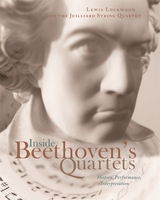 Inside Beethoven’s Quartets: History, Performance, Interpretation
Lewis Lockwood and the Juilliard String Quartet
Harvard University Press, 2008 The string quartets of Ludwig van Beethoven, the signal achievement of “that noble genre,” have rewarded the engagement of scholars, performers, and audiences for almost two hundred years. This book and its accompanying recording invite you to experience three of these profound and beautiful works of music from the inside, with a leading Beethoven scholar and a premier performing ensemble as your guides. Lewis Lockwood provides historical and biographical background along with musical analysis, drawing on the most important insights of recent scholarship on Beethoven’s life and works. The members of the Juilliard String Quartet share the fruits of decades of performing and teaching these compositions through annotated scores and recordings of the first movements of three representative quartets, including the rarely heard original version of Opus 18 no. 1. And all parties join in lively and illuminating conversations that range from details of bowing and articulation to Beethoven’s development as a composer to the social history of the nineteenth century. Inside Beethoven’s Quartets illustrates how scholarly knowledge can inform a performance, as well as how performers’ interpretive choices can illuminate this sublime music.
 Inside Charter Schools: The Paradox of Radical Decentralization
Edited by Bruce Fuller.Contributors: Jennifer Jellison Holme, Luis Huerta, Eric Rofes, Amy Stuart Wells, Ash Vasudeva, Edward Wexler, Patty Yancey, and Kate Zernike
Harvard University Press, 2000 Deepening disaffection with conventional public schools has inspired flight to private schools, home schooling, and new alternatives, such as charter schools. Barely a decade old, the charter school movement has attracted a colorful band of supporters, from presidential candidates, to ethnic activists, to the religious Right. At present there are about 1,700 charter schools, with total enrollment estimated to reach one million early in the century. Yet, until now, little has been known about the inner workings of these small, inventive schools that rely on public money but are largely independent of local school boards.
Inside Charter Schools takes readers into six strikingly different schools, from an evangelical home-schooling charter in California to a back-to-basics charter in a black neighborhood in Lansing, Michigan. With a keen eye for human aspirations and dilemmas, the authors provide incisive analysis of the challenges and problems facing this young movement.
Do charter schools really spur innovation, or do they simply exacerbate tribal forms of American pluralism? Inside Charter Schools provides shrewd and illuminating studies of the struggles and achievements of these new schools, and offers practical lessons for educators, scholars, policymakers, and parents.
 Inside Chinese Theater: Community and Artistry in Nineteenth-Century California and Beyond
Nancy Yunhwa Rao
University of Illinois Press, 2025 In the mid-nineteenth century, Chinese opera theater arrived as one of the significant performing art forms in California. Nancy Yunhwa Rao excavates and contextualizes the important history of Chinese Opera Theater, bringing to light the ways it became woven into the financial, political, social, and family life in California and beyond. Chinese opera theater found brick-and-mortar homes with San Francisco theaters like the Hing Chuen Yuen and the Donn Qui Yuen. But troupes had already followed Chinese immigrants to mining and railroad towns, and across the American West. As Chinese theater became part of California and San Francisco culture, popular Chinese actors advocated for their art alongside appeals for civil rights. Rao draws on personal diaries, newspapers and artifacts to place Chinese theater within the everyday lives of San Francisco. She also examines the costumes, singing, staging, and storytelling that impacted mainstream reception and influenced how Chinese communities saw themselves. Illustrated with seventy photographs, Inside Chinese Theater is an expert and eloquent journey into the early decades of Chinese opera in America.
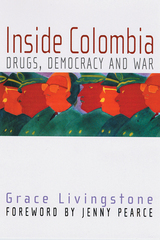 Inside Colombia: Drugs, Democracy, and War
Livingstone, Grace
Rutgers University Press, 2004 The South American nation of Colombia has seen more than forty years of unrest, conflict, and civil war. It is a country in which social violence and warfare are intricately intertwined. Colombia is also notorious for its drug trade, being one of the leading producers of cocaine in the world, and for its central role as a staging ground for the U.S. “war on drugs.” Since 9/11 the Bush administration has sought to draw political links between the Colombian drug trade, guerrilla organizations, and terrorism.
Inside Colombia offers a valuable introduction and quick reference guide to this complex nation. With chapters devoted to history, human rights issues, the economy, drugs, the controversial antidrug intervention known as Plan Colombia, and relations with the United States, the book offers an easily accessible and comprehensive overview. Readers will learn about the major players in the conflicts, significant political figures, how Colombia’s economy has fared in the twentieth century, how the country’s geography influences its politics and economy, and how U.S. intervention shapes Colombia’s political scene.
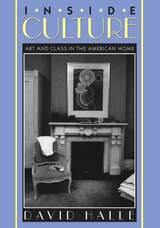 Inside Culture: Art and Class in the American Home
David Halle
University of Chicago Press, 1993 Dubbed as "You Are What You Hang (or Don't)" by the New York Times,Inside Culture takes us on a tour of 160 homes in and around New York City, from affluent townhouses on Manhattan's Upper East Side and rowhouses in blue-collar Brooklyn to middle and upper-class suburbs of Long Island. The result is an unprecedented portrait of the use of cultural artifacts—fine art, photographs, religious art—in private lives.
"This is a first-class addition to what we know about culture in the specific rather than the abstract."—Howard S. Becker, Contemporary Sociology
"This book is well worth reading, especially in your own home."—Eugene Halton, American Journal of Sociology
"David Halle's researches earned him a license amateur voyeurs would kill for. . . . Refreshing for readers outside his discipline."—Peter Campbell, London Review of Books
"[This book] tells us interesting things about ourselves. . . . It affords us a birds-eye view of American culture from which we can see . . . unsuspected patterns of tastes and acquisitions."—James Gardner, Washington Times
"[A] voyeuristic thrill. . . . Lucid and entertaining. . . . A fascinating book that will open the eyes of anyone who's ever glibly said about art, 'I know what I like.' After reading Inside Culture, they'll also know a little bit more about why."—Maureen Corrigan, New York Observer
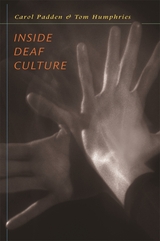 Inside Deaf Culture
Carol A. Padden and Tom Humphries
Harvard University Press, 2005 In this absorbing story of the changing life of a community, the authors of Deaf in America reveal historical events and forces that have shaped the ways that Deaf people define themselves today. Inside Deaf Culture relates Deaf people's search for a voice of their own, and their proud self-discovery and self-description as a flourishing culture.
Padden and Humphries show how the nineteenth-century schools for the deaf, with their denigration of sign language and their insistence on oralist teaching, shaped the lives of Deaf people for generations to come. They describe how Deaf culture and art thrived in mid-twentieth century Deaf clubs and Deaf theatre, and profile controversial contemporary technologies.
Most triumphant is the story of the survival of the rich and complex language American Sign Language, long misunderstood but finally recently recognized by a hearing world that could not conceive of language in a form other than speech. In a moving conclusion, the authors describe their own very different pathways into the Deaf community, and reveal the confidence and anxiety of the people of this tenuous community as it faces the future.
Inside Deaf Culture celebrates the experience of a minority culture--its common past, present debates, and promise for the future. From these pages emerge clear and bold voices, speaking out from inside this once silenced community.
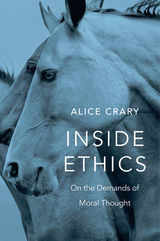 Inside Ethics: On the Demands of Moral Thought
Alice Crary
Harvard University Press, 2016 Alice Crary’s Inside Ethics is a transformative account of moral thought about human beings and animals.
We have come to think of human beings and animals as elements of a morally indifferent reality that reveals itself only to neutral or science-based methods. This little-commented-on trend, which shapes the work of moral philosophers and popular ethical writers alike, has pernicious effects, distorting our understanding of the difficulty of moral thinking. Inside Ethics traces the roots of existing views to tendencies in ethics, metaphysics, and philosophy of mind. Crary underlines the moral urgency of revisiting our approach in ethics so that, instead of assuming we confront a world that itself places no demands on moral imagination, we treat the exercise of moral imagination as necessary for arriving at an adequate world-guided understanding of human beings and animals.
The book’s argument is both rich and practically oriented, integrating ideas from literary authors such as Raymond Carver, J. M. Coetzee, Daniel Keyes, W. G. Sebald, and Leo Tolstoy and bringing them to bear on issues in disability studies and animal studies as well as elsewhere in ethics. The result is a commanding case for a reorientation in ethics that illuminates central challenges of moral thought about human and animal lives, directing attention to important aspects of these lives that are otherwise hidden from view.
 Inside Graduate Admissions: Merit, Diversity, and Faculty Gatekeeping
Julie R. Posselt
Harvard University Press, 2016 How does graduate admissions work? Who does the system work for, and who falls through its cracks? More people than ever seek graduate degrees, but little has been written about who gets in and why. Drawing on firsthand observations of admission committees and interviews with faculty in 10 top-ranked doctoral programs in the humanities, social sciences, and natural sciences, education professor Julie Posselt pulls back the curtain on a process usually conducted in secret.
“Politicians, judges, journalists, parents and prospective students subject the admissions policies of undergraduate colleges and professional schools to considerable scrutiny, with much public debate over appropriate criteria. But the question of who gets into Ph.D. programs has by comparison escaped much discussion. That may change with the publication of Inside Graduate Admissions…While the departments reviewed in the book remain secret, the general process used by elite departments would now appear to be more open as a result of Posselt’s book.”
—Scott Jaschik, Inside Higher Ed
“Revealing…Provide[s] clear, consistent insights into what admissions committees look for.”
—Beryl Lieff Benderly, Science
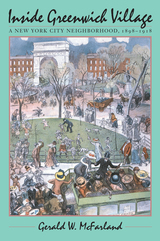 Inside Greenwich Village: A New York City Neighborhood, 1898-1918
Gerald W. McFarland
University of Massachusetts Press, 2001 In the popular imagination, New York City's Greenwich Village has long been known as a center of bohemianism, home to avant-garde artists, political radicals, and other nonconformists who challenged the reigning orthodoxies of their time. Yet a century ago the Village was a much different kind of place: a mixed-class, multiethnic neighborhood teeming with the energy and social tensions of a rapidly changing America. Gerald W. McFarland reconstructs this world with vivid descriptions of the major groups that resided within its boundaries—the Italian immigrants and African Americans to the south, the Irish Americans to the west, the well-to-do Protestants to the north, and the New York University students, middle-class professionals, and artists and writers who lived in apartment buildings and boarding houses on or near Washington Square.
McFarland examines how these Villagers, so divided along class and ethnic lines, interacted with one another. He shows how clashing expectations about what constituted proper behavior in the neighborhood's public spaces—especially streets, parks, and saloons—often led to intergroup conflict, political rivalries, and campaigns by the more privileged Villagers to impose middle-class mores on their working-class neighbors. Occasionally, however, a crisis or common problem led residents to overlook their differences and cooperate across class and ethnic lines. Throughout the book, McFarland connects the evolution of Village life to the profound transformations taking place in American society at large during the same years.
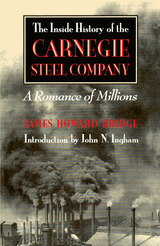 The Inside History of the Carnegie Steel Company: A Romance of Millions
James Howard Bridge
University of Pittsburgh Press, 1992 “For years I have been convinced that there is not an honest bone in your body. Now I know that you are a god-damned thief,” Henry Clay Frick reportedly told Andrew Carnegie at their last meeting in 1900, just before J. P. Morgan bought the Carnegie Steel Company and founded United States Steel.
Three years later, James Bridge, who had served as Carnegie's personal secretary, published this book. In it he recounted the events that led up to the final confrontation between two of America's most powerful capitalists. The book created a sensation when it appeared in 1903. Not only did it describe the raw emotions of Carnegie and Frick, those most brilliant and uneasy of business partners, it also told of the history and inner workings of the industrial giant, Carnegie Steel.
Bridge was an open partisan of Frick, and the portrait of Carnegie that emerges from this book is not flattering. But he was an experienced journalist, and he uses sources carefully. His book remains a striking insider's narrative of the American steel industry in the last decades of the nineteenth century-as well as the most revealing account of the emotions of some of its major owners.
The introduction by John Ingram places the book in perspective for both the historian and general reader.
Inside Jewish Day Schools: Leadership, Learning, and Community
Alex Pomson and Jack Wertheimer
Brandeis University Press, 2021 A perfect guide to those wishing to understand the contemporary Jewish day school.
This book takes readers inside Jewish day schools to observe what happens day to day, as well as what the schools mean to their students, families, and communities. Many different types of Jewish day schools exist, and the variations are not well understood, nor is much information available about how day schools function. Inside Jewish Day Schools proves a vital guide to understanding both these distinctions and the everyday operations of these contemporary schools.
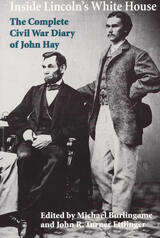 Inside Lincoln's White House: The Complete Civil War Diary of John Hay
Edited by Michael Burlingame and John R. Turner Ettlinger
Southern Illinois University Press, 1999 On 18 April 1861, assistant presidential secretary John Hay recorded in his diary the report of several women that "some young Virginian long haired swaggering chivalrous of course. . . and half a dozen others including a daredevil guerrilla from Richmond named Ficklin would do a thing within forty eight hours that would ring through the world." The women feared that the Virginian planned either to assassinate or to capture the president. Calling this a "harrowing communication," Hay continued his entry: "They went away and I went to the bedside of the Chief couché. I told him the yarn; he quietly grinned." This is but one of the dramatic entries in Hay’s Civil War diary, presented here in a definitive edition by Michael Burlingame and John R. Turner Ettlinger. Justly deemed the most intimate record we will ever have of Abraham Lincoln in the White House, the Hay diary is, according to Burlingame and Ettlinger, "one of the richest deposits of high-grade ore for the smelters of Lincoln biographers and Civil War historians." While the Cabinet diaries of Salmon P. Chase, Edward Bates, and Gideon Welles also shed much light on Lincoln’s presidency, as does the diary of Senator Orville Hickman Browning, none of these diaries has the literary flair of Hay’s, which is, as Lincoln’s friend Horace White noted, as "breezy and sparkling as champagne." An aspiring poet, Hay recorded events in a scintillating style that the lawyer-politician diarists conspicuously lacked. Burlingame and Ettlinger’s edition of the diary is the first to publish the complete text of all of Hay’s entries from 1861 through 1864. In 1939 Tyler Dennett published Lincoln and the Civil War in the Diaries and Letters of John Hay, which, as Civil War historian Allan Nevins observed, was "rather casually edited." This new edition is essential in part because Dennett omitted approximately 10 percent of Hay’s 1861–64 entries. Not only did the Dennett edition omit important parts of the diaries, it also introduced some glaring errors. More than three decades ago, John R. Turner Ettlinger, then in charge of Special Collections at the Brown University Library, made a careful and literal transcript of the text of the diary, which involved deciphering Hay’s difficult and occasionally obscure writing. In particular, passages were restored that had been canceled, sometimes heavily, by the first editors for reasons of confidentiality and propriety. Ettlinger’s text forms the basis for the present edition, which also incorporates, with many additions and much updating by Burlingame, a body of notes providing a critical apparatus to the diary, identifying historical events and persons.
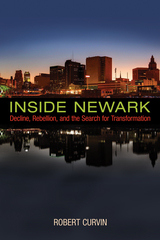 Inside Newark: Decline, Rebellion, and the Search for Transformation
Curvin, Robert
Rutgers University Press, 2014 For decades, leaders in Newark, New Jersey, have claimed their city is about to return to its vibrant past. How accurate is this prediction? Is Newark on the verge of revitalization? Robert Curvin, who was one of New Jersey’s outstanding civil rights leaders, examines the city, chronicling its history, politics, and culture. Throughout the pages of Inside Newark, Curvin approaches his story both as an insider who is rooting for Newark and as an objective social scientist illuminating the causes and effects of sweeping changes in the city.
Based on historical records and revealing interviews with over one hundred residents and officials, Inside Newark traces Newark’s history from the 1950s, when the city was a thriving industrial center, to the era of Mayor Cory Booker. Along the way, Curvin covers the disturbances of July 1967, called a riot by the media and a rebellion by residents; the administration of Kenneth Gibson, the first black mayor of a large northeastern city; and the era of Sharpe James, who was found guilty of corruption. Curvin examines damaging housing and mortgage policies, the state takeover of the failing school system, the persistence of corruption and patronage, Newark’s shifting ethnic and racial composition, positive developments in housing and business complexes, and the reign of ambitious mayor Cory Booker.
Inside Newark reveals a central weakness that continues to plague Newark—that throughout this history, elected officials have not risen to the challenges they have faced. Curvin calls on those in positions of influence to work for the social and economic improvement of all groups and concludes with suggestions for change, focusing on education reform, civic participation, financial management, partnerships with agencies and business, improving Newark’s City Council, and limiting the term of the mayor. If Newark’s leadership can encompass these changes, Newark will have a chance at a true turnaround. Watch a video with Robert Curvin: Watch video now. (http://www.youtube.com/watch?v=v-d6zV2OQ8A).
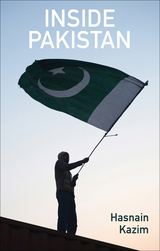 Inside Pakistan
Hasnain Kazim
Haus Publishing Pakistan, a land with a long and storied history, is experiencing a tumultuous present. As its population expands to surpass two hundred million, its infrastructure is faltering and rampant unemployment and power outages have become the norm. The military controls much of the nation, and at the same time as the public educational system has found itself lacking needed resources, a brand of conservative and radical Islam has developed that is now a prominent political force. And yet the hope and resilience of the Pakistanis remain as strong as ever, promising the possibility of a calmer tomorrow. Hasnain Kazim, a correspondent for the current-affairs magazine Der Spiegel and the son of Indo-Pakistani immigrants to Germany, explores all of this and more in a riveting account of his four years living in and reporting from the region.
As Kazim and his wife arrived in Islamabad in 2009, they found the country of his parents’ birth riven with contradictions: a nuclear power with a tremendous gulf between the rich and poor, Pakistan has experienced a series of natural and manmade disasters in recent years alongside turbulent periods of economic growth and stagnation. What keeps the people of this Islamic society going? What hopes do they hold for the future? As Kazim spoke with Pakistanis at every level of society and of all political persuasions in search of answers to these questions, he discovered a much more complex country than the headlines of violence and extremism would suggest. Told from a sensitive and sympathetic insider’s perspective, Inside Pakistan pulls back the curtain on a section of the world that promises to play an ever more important role in years to come.
 Inside Passage: A Journey Beyond Borders
Richard Manning
Island Press, 2000 “This book is about an idea that rests at the junction of what we call wilderness and civilization. Simply, it is a call for rethinking, and more importantly, reconstructing, our relationship with nature.” --from Inside PassageProtecting land in parks, safe from human encroachment, has been a primary strategy of conservationists for the past century and a half. Yet drawing lines around an area and calling it wilderness does little to solve larger environmental problems. As author Richard Manning puts it in a knowingly provocative way: “Wilderness designation is not a victory, but acknowledgement of defeat.”In Inside Passage, Manning takes us on a thought-provoking tour of the lands along the Pacific Northwest's Inside Passage -- from southeast Alaska down through Puget Sound, and then on to the northern Oregon coast and the Columbia River system -- as he explores the dichotomy between “wilderness” and “civilization” and the often disastrous effects of industrialization.Through vivid description and conversations with people in the region, Manning brings new insights to the area's most pressing environmental concerns -- the salmon crisis, deforestation, hydroelectric dams, urban sprawl -- and examines various innovative ways they are being addressed. He details efforts to restore degraded ecosystems and to integrate economic development with environmental protection, and looks at powerful new tools such as Geographic Information Systems (GIS) that are increasingly being used to further conservation efforts.Throughout, Manning focuses on the hopeful possibility that we can redesign the human enterprise to a scale more appropriate to the nature that holds it, that rather than drawing borders around nature, we might instead start placing borders on human behavior. Perhaps, he suggests, we can begin to behave in all places as if all places matter to us as much as wilderness, and, in the process, claim all of nature as our own.Inside Passage is a wide-ranging and thoughtful exploration by a gifted writer, and an important work for anyone interested in the Pacific Northwest, or concerned about the future of our relationship to the natural world.
 INSIDE PITCH AND MORE: BASEBALL'S BUSINESS AND THE PUBLIC TRUST
GENE A. BUDIG
West Virginia University Press, 2004 The Inside Pitch and More: Baseball’s Business and the Public Trust, written by former American League President Gene Budig, investigates the human and corporate sides of our nation’s pastime. Throughout the course of this book, the author systematically engages the myriad concerns of Major League Baseball, past, present, and future. In The Inside Pitch and More, baseball’s economic prosperity is examined, as well as issues that hinder and threaten that perpetuity. Lately, baseball has been increasingly menaced by the popularity of other athletic venues - basketball, football, etc. Budig goes through the proposed methods of revitalizing the game of baseball. He emphasizes the need for a reevaluation of the relationship between the sport and its fan base so that the baseball will resume its role as America’s favorite pastime. Based on his six years as president of the American League, Budig has composed a fascinating book, which is written to be enjoyed by the casual baseball fan as well as the serious student of this sport or sports management in general. The book is unique in that it is the first work to really dissect the sport of baseball by a retired high-ranking official with a wealth of information on the subject.
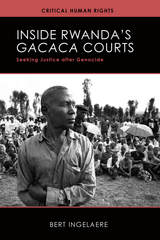 Inside Rwanda's /Gacaca/ Courts: Seeking Justice after Genocide
Bert Ingelaere
University of Wisconsin Press, 2018 After the 1994 genocide in Rwanda, victims, perpetrators, and the country as a whole struggled to deal with the legacy of the mass violence. The government responded by creating a new version of a traditional grassroots justice system called gacaca. Bert Ingelaere, based on his observation of two thousand gacaca trials, offers a comprehensive assessment of what these courts set out to do, how they worked, what they achieved, what they did not achieve, and how they affected Rwandan society.
Weaving together vivid firsthand recollections, interviews, and trial testimony with systematic analysis, Ingelaere documents how the gacaca shifted over time from confession to accusation, from restoration to retribution. He precisely articulates the importance of popular conceptions of what is true and just. Marked by methodological sophistication, extraordinary evidence, and deep knowledge of Rwanda, this is an authoritative, nuanced, and bittersweet account of one of the most important experiments in transitional justice after mass violence.
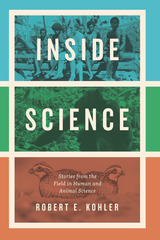 Inside Science: Stories from the Field in Human and Animal Science
Robert E. Kohler
University of Chicago Press, 2019 Context and situation always matter in both human and animal lives. Unique insights can be gleaned from conducting scientific studies from within human communities and animal habitats. Inside Science is a novel treatment of this distinctive mode of fieldwork. Robert E. Kohler illuminates these resident practices through close analyses of classic studies: of Trobriand Islanders, Chicago hobos, corner boys in Boston’s North End, Jane Goodall’s chimpanzees of the Gombe Stream Reserve, and more. Intensive firsthand observation; a preference for generalizing from observed particulars, rather than from universal principles; and an ultimate framing of their results in narrative form characterize these inside stories from the field.
Resident observing takes place across a range of sciences, from anthropology and sociology to primatology, wildlife ecology, and beyond. What makes it special, Kohler argues, is the direct access it affords scientists to the contexts in which their subjects live and act. These scientists understand their subjects not by keeping their distance but by living among them and engaging with them in ways large and small. This approach also demonstrates how science and everyday life—often assumed to be different and separate ways of knowing—are in fact overlapping aspects of the human experience. This story-driven exploration is perfect for historians, sociologists, and philosophers who want to know how scientists go about making robust knowledge of nature and society.
Inside Teaching: How Classroom Life Undermines Reform
Mary Kennedy
Harvard University Press, 2006 Reform the schools, improve teaching: these battle cries of American education have been echoing for twenty years. So why does teaching change so little?
Arguing that too many would-be reformers know nothing about the conflicting demands of teaching, Mary Kennedy takes us into the controlled commotion of the classroom, revealing how painstakingly teachers plan their lessons, and how many different ways things go awry. Teachers try simultaneously to keep track of materials, time, students, and ideas. In their effort to hold all of these things together, they can inadvertently quash students' enthusiasm and miss valuable teachable moments.
Kennedy argues that pedagogical reform proposals that do not acknowledge all of the things teachers need to do are bound to fail. If reformers want students to learn, they must address all of the problems teachers face, not just those that interest them.
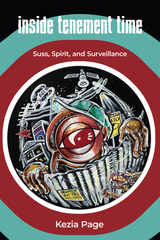 Inside Tenement Time: Suss, Spirit, and Surveillance
Kezia Page
Rutgers University Press, 2025 Inside Tenement Time is the first comprehensive treatment of literary and cultural texts on surveillance in the Caribbean. Covering the long historical arc of the twentieth to the twenty-first centuries, Inside Tenement Time uses Jamaica as a case study to examine moments of crisis and particular spaces, especially urban yard enclaves and their environs, in the Caribbean encounter with surveillance. Making the argument that the Caribbean situation reveals flexible hegemonies rather than provinces of exclusive control, the book demonstrates the countervailing force of sussveillance and spiritveillance, Afro-Indigenous variations on surveillance. Sussveillance and spiritveillance are exemplars of vernacular arts and sciences that operate at and within the frangible borders of state power, exposing the unique dynamics of surveillance in the region and marshalling the acts of imagination with which it contends. For example, the Smile Jamaica concert of 1976, headlined by reggae Superstar Bob Marley, and the reputedly US government-backed 2010 Tivoli Gardens incursion in West Kingston, both moments that have dramatic, even mythic residue in Caribbean and global memory, are among the real-life events brought into conversation with literary representations of this history.
 Inside the Antisemitic Mind: The Language of Jew-Hatred in Contemporary Germany
Monika Schwarz-Friesel and Jehuda Reinharz
Brandeis University Press, 2017 Antisemitism never disappeared in Europe. In fact, there is substantial evidence that it is again on the rise, manifest in violent acts against Jews in some quarters, but more commonly noticeable in everyday discourse in mainstream European society. This innovative empirical study examines written examples of antisemitism in contemporary Germany. It demonstrates that hostility against Jews is not just a right-wing phenomenon or a phenomenon among the uneducated, but is manifest among all social classes, including intellectuals. Drawing on 14,000 letters and e-mails sent between 2002 and 2012 to the Central Council of Jews in Germany and to the Israeli embassy in Berlin, as well as communications sent between 2010 and 2011 to Israeli embassies in Austria, Switzerland, Belgium, England, Ireland, the Netherlands, Sweden, and Spain, this volume shows how language plays a crucial role in activating and re-activating antisemitism. In addition, the authors investigate the role of emotions in antisemitic argumentation patterns and analyze “anti-Israelism” as the dominant form of contemporary hatred of Jews.
 Inside the Arab World
Michael Field
Harvard University Press, 1995 Precious oil and export markets, wars in Lebanon and the Persian Gulf, peace talks at the White House, terrorist eruptions: more now than ever, Arab affairs are the West's affair. And yet as we find ourselves increasingly enmeshed in its politics and economics, the Middle East remains a mystery to most of us, a world of dimly understood connections and impenetrable complexities. The Arab world at last becomes accessible in this book. The only study to include developments since the Gulf War and the historic pact between Israel and the PLO, Inside the Arab World gives us a complete and detailed picture of the region as it is today, as well as a clear sense of how Arab affairs have evolved and where they may lead.
Despite its abundance of oil, the Arab world has failed to produce a single successful economy. Michael Field, a recognized expert and longtime reporter on the Arab states, ably explores the cultural, political, and geographic reasons for this failure. Ranging from Algeria to the Gulf states to Egypt and Syria, he considers the fragmentation of society, the people's tolerance of bad government, corruption, and the deadening economic effect of Arab socialism. But he also shows how the region--influenced partly by exposure to Western media, partly by reforms imposed by creditors--is changing now, taking its first cautious steps toward democracy, whose opportunities so far have been most firmly grasped by Islamic fundamentalists.
Timely, thorough, and highly readable, this book offers much-needed insight into the Arab world as its politics and policies increasingly engage our own.
Inside the Business Enterprise: Historical Perspectives on the Use of Information
Edited by Peter Temin
University of Chicago Press, 1991 How do business enterprises control their subunits? In what ways do existing paths of communication within a firm affect its ability to absorb new technology and techniques? How do American banks affect how companies operate? Do theoretical constructs correspond to actual behavior?
Because business enterprises are complex institutions, these questions can prove difficult to address. All too often, firms are treated as the atoms of economics, the irreducible unit of analysis. This accessible volume, suitable for course use, looks more closely at the American firm—into its internal workings and its genesis in the Gilded Age. Focusing on the crucial role of imperfect and asymmetric information in the operation of enterprises, Inside the Business Enterprise forges an innovative link between modern economic theory and recent business history.
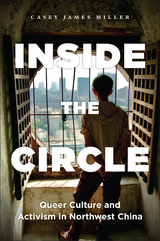 Inside the Circle: Queer Culture and Activism in Northwest China
Casey James Miller
Rutgers University Press, 2023 Drawing on over a decade of ethnographic fieldwork in northwest China, Casey James Miller offers a novel, compelling, and intimately personal perspective on Chinese queer culture and activism. In Inside the Circle: Queer Culture and Activism in Northwest China, Miller tells the stories of two courageous and dedicated groups of queer activists in the city of Xi’an: a grassroots gay men’s HIV/AIDS organization called Tong’ai and a lesbian women’s group named UNITE. Taking inspiration from “the circle,” a term used to imagine local, national, and global queer communities, Miller shows how everyday people in northwest China are taking part in queer culture and activism while also striving to lead traditionally moral lives in a rapidly changing society. The queer stories in this book broaden our understandings of gender and sexuality in contemporary China and show how taking global queer diversity seriously requires us to de-center Western cultural values, historical experiences, and theoretical perspectives.
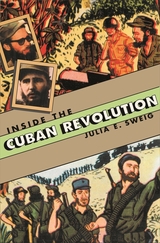 Inside the Cuban Revolution: Fidel Castro and the Urban Underground
Julia E. Sweig
Harvard University Press, 2004 Julia Sweig shatters the mythology surrounding the Cuban Revolution in a compelling revisionist history that reconsiders the revolutionary roles of Fidel Castro and Che Guevara and restores to a central position the leadership of the Cuban urban underground, the Llano. Granted unprecedented access to the classified records of Castro's 26th of July Movement's underground operatives--the only scholar inside or outside of Cuba allowed access to the complete collection in the Cuban Council of State's Office of Historic Affairs--she details the ideological, political, and strategic debates between Castro's mountain-based guerrilla movement and the urban revolutionaries in Havana, Santiago, and other cities.
In a close study of the fifteen months from November 1956 to July 1958, when the urban underground leadership was dominant, Sweig examines the debate between the two groups over whether to wage guerrilla warfare in the countryside or armed insurrection in the cities, and is the first to document the extent of Castro's cooperation with the Llano. She unveils the essential role of the urban underground, led by such figures as Frank País, Armando Hart, Haydée Santamaria, Enrique Oltuski, and Faustino Pérez, in controlling critical decisions on tactics, strategy, allocation of resources, and relations with opposition forces, political parties, Cuban exiles, even the United States--contradicting the standard view of Castro as the primary decision maker during the revolution.
In revealing the true relationship between Castro and the urban underground, Sweig redefines the history of the Cuban Revolution, offering guideposts for understanding Cuban politics in the 1960s and raising intriguing questions for the future transition of power in Cuba.
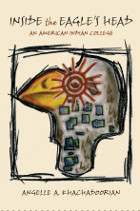 Inside the Eagle's Head: An American Indian College
Angelle A. Khachadoorian
University of Alabama Press, 2010 Where tradition meets bureaucracy—Native students redefine education on their own terms. Inside the Eagle’s Head offers a compelling and deeply human portrait of the Southwestern Indian Polytechnic Institute (SIPI), a federally operated college serving Native American students from across the United States. In it, anthropologist Angelle Khachadoorian draws on years of teaching experience and extensive student interviews to illuminate the challenges and successes of life at SIPI. Far more than an institutional history, this book captures the voices of students navigating a complex educational landscape shaped by federal oversight, tribal identity, and personal ambition. Through vivid metaphors—SIPI as a family, a prison, a reservation—students articulate their struggles and resilience within a system that is at once empowering and restrictive. Khachadoorian’s analysis reveals how SIPI’s hybrid nature—part community college, part BIA legacy—creates both opportunities and obstacles for its students. With empathy and insight, she explores how young Native Americans forge identity, community, and purpose in a setting few outsiders understand. Inside the Eagle’s Head is essential reading for educators, policymakers, and anyone interested in the intersection of Indigenous education, federal institutions, and student agency. It is a powerful testament to the transformative potential of listening to students’ stories.
Inside the Jury
Reid Hastie, Steven D. Penrod, and Nancy Pennington
Harvard University Press, 1983
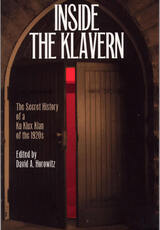 Inside the Klavern: The Secret History of a Ku Klux Klan of the 1920s
Edited by David A. Horowitz
Southern Illinois University Press, 1999 Inside the Klavern is an annotated collection of the minutes of a thriving Ku Klux Klan in La Grande, Oregon, between 1922 and 1924. The most complete set of Klan minutes ever uncovered, these documents illustrate the inner workings of a Klan chapter of more than three hundred members at a time when the national membership reached into the millions and the Invisible Empire was at the peak of its power. Through an extensive introduction and conclusion as well as brief notes previewing each installment of the minutes, David A. Horowitz places these unique documents in historical perspective. The La Grande minutes demonstrate Klan hostility to Roman Catholics, Jews, blacks, and "hyphenated" Americans. But they also explain how the chapter exercised requirements for admission, how officers were selected, and how Klansmen encountered difficulties enforcing the moral standards of their order. Because the Klan kligrapp (recording secretary) Harold R. Fosner recorded not only the official proceedings but also volunteered extemporaneous comments and gossip, readers get a genuine feeling for what it was like to attend the meetings. Through his own obvious excitement and commitment to the cause, Fosner re-creates the flavor, tone, and atmosphere of these meetings: "Tis beyond my power of expression to relate the harmony and fellowship which reigned supreme. . . . Suffice to say that these were the golden moments of our lives." His evaluation of Klan propaganda, too, is telling: "The weekly newsletter from Atlanta, Georgia, contained a little book, the official message of our emperor, one Col. William Joseph Simmons, read before the most noble band of men ever assembled and for the noblest cause in the world. To my firm belief this book is the leading masterpiece of our day and age." Horowitz concludes that "although it is tempting to judge Jazz Age Klansmen by the standards of later generations, the story provided by the minutes is a complex one—a chronicle of both compassion and complicity in cruelty, of positive social accomplishment and arbitrary and dysfunctional divisiveness."
 Inside the Kremlin’s Cold War: From Stalin to Khrushchev
Vladislav Zubok and Constantine Pleshakov
Harvard University Press, 1996 Covering the volatile period from 1945 to 1962, Vladislav Zubok and Constantine Pleshakov explore the personalities and motivations of the key people who directed Soviet political life and shaped Soviet foreign policy. They begin with the fearsome figure of Joseph Stalin, who was driven by the dual dream of a Communist revolution and a global empire. They reveal the scope and limits of Stalin’s ambitions by taking us into the world of his closest subordinates, the ruthless and unimaginative foreign minister Molotov and the Party’s chief propagandist, Zhdanov, a man brimming with hubris and missionary zeal. The authors expose the machinations of the much-feared secret police chief Beria and the party cadre manager Malenkov, who tried but failed to set Soviet policies on a different course after Stalin’s death. Finally, they document the motives and actions of the self-made and self-confident Nikita Khrushchev, full of Russian pride and party dogma, who overturned many of Stalin’s policies with bold strategizing on a global scale. The authors show how, despite such attempts to change Soviet diplomacy, Stalin’s legacy continued to divide Germany and Europe, and led the Soviets to the split with Maoist China and to the Cuban missile crisis.
Zubok and Pleshakov’s groundbreaking work reveals how Soviet statesmen conceived and conducted their rivalry with the West within the context of their own domestic and global concerns and aspirations. The authors persuasively demonstrate that the Soviet leaders did not seek a conflict with the United States, yet failed to prevent it or bring it to conclusion. They also document why and how Kremlin policy-makers, cautious and scheming as they were, triggered the gravest crises of the Cold War in Korea, Berlin, and Cuba. Taking us into the corridors of the Kremlin and the minds of its leaders, Zubok and Pleshakov present intimate portraits of the men who made the West fear, to reveal why and how they acted as they did.
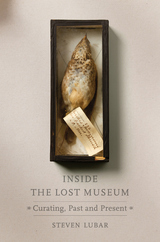 Inside the Lost Museum: Curating, Past and Present
Steven Lubar
Harvard University Press, 2017 Curators make many decisions when they build collections or design exhibitions, plotting a passage of discovery that also tells an essential story. Collecting captures the past in a way useful to the present and the future. Exhibits play to our senses and orchestrate our impressions, balancing presentation and preservation, information and emotion. Curators consider visitors’ interactions with objects and with one another, how our bodies move through displays, how our eyes grasp objects, how we learn and how we feel. Inside the Lost Museum documents the work museums do and suggests ways these institutions can enrich the educational and aesthetic experience of their visitors.
Woven throughout Inside the Lost Museum is the story of the Jenks Museum at Brown University, a nineteenth-century display of natural history, anthropology, and curiosities that disappeared a century ago. The Jenks Museum’s past, and a recent effort by artist Mark Dion, Steven Lubar, and their students to reimagine it as art and history, serve as a framework for exploring the long record of museums’ usefulness and service.
Museum lovers know that energy and mystery run through every collection and exhibition. Lubar explains work behind the scenes—collecting, preserving, displaying, and using art and artifacts in teaching, research, and community-building—through historical and contemporary examples. Inside the Lost Museum speaks to the hunt, the find, and the reveal that make curating and visiting exhibitions and using collections such a rewarding and vital pursuit.
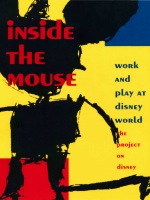 Inside the Mouse: Work and Play at Disney World
Project on Disney
Duke University Press, 1995 This entertaining and playful book views Disney World as much more than the site of an ideal family vacation. Blending personal meditations, interviews, photographs, and cultural analysis, Inside the Mouse looks at Disney World’s architecture and design, its consumer practices, and its use of Disney characters and themes. This book takes the reader on an alternative ride through "the happiest place on earth" while asking "What makes this forty-three-square-mile theme park the quintessential embodiment of American leisure?"
Turning away from the programmed entertainment that Disney presents, the authors take a peek behind the scenes of everyday experience at Disney World. In their consideration of the park as both private corporate enterprise and public urban environment, the authors focus on questions concerning the production and consumption of leisure. Featuring over fifty photographs and interviews with workers that strip "cast members" of their cartoon costumes, this captivating work illustrates the high-pressure dynamics of the typical family vacation as well as a tour of Disney World that looks beyond the controlled facade of themed attractions.
As projects like EuroDisney and the proposed Disney America test the strength of the Disney cultural monolith, Inside the Mouse provides a timely assessment of the serious business of supplying pleasure in contemporary U.S. culture. Written for the general reader interested in the many worlds of Disney, this engrossing volume will also find fans among students and scholars of cultural studies.
Inside the Politics of Technology: Agency and Normativity in the Co-Production of Technology and Society
Edited by Hans Harbers
Amsterdam University Press, 2005 Though the old saying claims that man is the measure of all things, the authors of Inside the Politics of Technology argue that the distinction implied between autonomous humans and neutral instruments of technology is an illusion. On the contrary, the technologies humans create simultaneously shape humans themselves.
By means of case studies of technologies as diverse as video cameras, electric cars, pregnancy tests, and genetic screenings, this volume considers the implications of this "co-production" of technology and society for our philosophical and political ideas. Are only humans endowed with social, political, and moral agency, or does our technology share those qualities? And if so, how should we understand—or practice—a politics of technology?
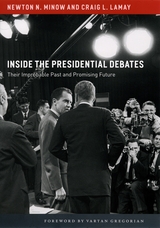 Inside the Presidential Debates: Their Improbable Past and Promising Future
Newton N. Minow and Craig L. LaMay
University of Chicago Press, 2008 Newton Minow’s long engagement with the world of television began nearly fifty years ago when President Kennedy appointed him chairman of the Federal Communications Commission. As its head, Minow would famously dub TV a “vast wasteland,” thus inaugurating a career dedicated to reforming television to better serve the public interest. Since then, he has been chairman of PBS and on the board of CBS and elsewhere, but his most lasting contribution remains his leadership on televised presidential debates. He was assistant counsel to Illinois governor Adlai Stevenson when Stevenson first proposed the idea of the debates in 1960; he served as cochair of the presidential debates in 1976 and 1980; and he helped create and is currently vice chairman of the Commission on Presidential Debates, which has organized the debates for the last two decades. Written with longtime collaborator Craig LaMay, this fascinating history offers readers for the first time a genuinely inside look into the origins of the presidential debates and the many battles—both legal and personal—that have determined who has been allowed to debate and under what circumstances. The authors do not dismiss the criticism of the presidential debates in recent years but do come down solidly in favor of them, arguing that they are one of the great accomplishments of modern American electoral politics. As they remind us, the debates were once unique in the democratic world, are now emulated across the globe, and they offer the public the only real chance to see the candidates speak in direct response to one another in a discussion of major social, economic, and foreign policy issues. Looking to the challenges posed by third-party candidates and the emergence of new media such as YouTube, Minow and LaMay ultimately make recommendations for the future, calling for the debates to become less formal, with candidates allowed to question each other and citizens allowed to question candidates directly. They also explore the many ways in which the Internet might serve to broaden the debates’ appeal and informative power. Whether it’s Clinton or Obama vs. McCain, Inside the Presidential Debates will be welcomed in 2008 by anyone interested in where this crucial part of our democracy is headed—and how it got there.
 Inside the Ropes with Jesse Ventura
Tom Hauser
University of Minnesota Press, 2002 A firsthand account of the remarkable rise of Minnesota’s unconventional governor.
Jesse Ventura burst into national consciousness-and late-night punch lines-when the former professional wrestler was unexpectedly elected governor of Minnesota in 1998. An overnight political sensation whose only previous relevant experience was a brief period as mayor of a Minneapolis suburb, Ventura became a lightning rod for the media, combining the bravado of a Navy SEAL, the showmanship of a movie actor, and the blunt speech and bluff humor of a talk-radio host with a surprising passion for public policy and legislative reform.
In this revealing chronicle of Jesse Ventura’s campaign, election, and time in office, political reporter Tom Hauser tells us what he saw as one of the "media jackals" covering the governor for local television station KSTP. In a saga full of drama, hi-jinks, and controversy, Hauser offers the inside story of the hubbub surrounding Ventura-from his triumphal tour of the late-night talk shows upon his election, to his outspoken and outrageous revelations in Playboy, to his stints as referee for the World Wrestling Federation and commentator for the failed XFL, to his ongoing battles with the state legislature. Hauser also provides insight into Ventura’s popularity, character, and motivations-his impatience with conventional wisdom, his distrust of traditional politics, and his combative relationship with the media. Though to many Ventura seemed to come out of nowhere, Hauser has been following him since the day he filed to run for governor, when he was the underdog in a race against two well-established career politicians, backed by major parties. Hauser offers the only detailed account available of Ventura’s amazing rise and reign, providing an evenhanded look at a political story that will leave readers feeling that truth really is stranger than fiction.
 Inside the Spiral: The Passions of Robert Smithson
Suzaan Boettger
University of Minnesota Press, 2022 An expansive and revelatory study of Robert Smithson’s life and the hidden influences on his iconic creations
This first biography of the major American artist Robert Smithson, famous as the creator of the Spiral Jetty, deepens understanding of his art by addressing the potent forces in his life that were shrouded by his success, including his suppressed early history as a painter; his affiliation with Christianity, astrology, and alchemy; and his sexual fluidity. Integrating extensive investigation and acuity, Suzaan Boettger uncovers Smithson’s story and, with it, symbolic meanings across the span of his painted and drawn images, sculptures, essays, and earthworks up to the Spiral Jetty and beyond, to the circumstances leading to what became his final work, Amarillo Ramp. While Smithson is widely known for his monumental earthwork at the edge of the Great Salt Lake, Inside the Spiral delves into the arc of his artistic production, recognizing it as a response to his family’s history of loss, which prompted his birth and shaped his strange intelligence. Smithson configured his personal conflicts within painterly depictions of Christ’s passion, the rhetoric of science fiction, imagery from occult systems, and the impersonal posture of conceptual sculpture. Aiming to achieve renown, he veiled his personal passions and transmuted his professional persona, becoming an acclaimed innovator and fierce voice in the New York art scene. Featuring copious illustrations never before published of early work that eluded Smithson’s destruction, as well as photographs of Smithson and his wife, the noted sculptor Nancy Holt, and recollections from nearly all those who knew him throughout his life, Inside the Spiral offers unprecedented insight into the hidden impulses of one of modern art’s most enigmatic figures. With great sensitivity to the experiences of loss and existential strife that defined his distinct artistic language, this biographical analysis provides an expanded view of Smithson’s iconic art pilgrimage site and the experiences and works that brought him to its peculiar blood red water.
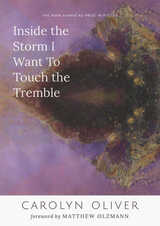 Inside the Storm I Want to Touch the Tremble
Carolyn Oliver
University of Utah Press, 2022 Inside this debut collection, girlhood’s dangers echo, transmuted, in the poet’s fears for her son. A body just discovering the vastness of “want’s new acreage” is humbled by chronic illness. Epithalamion turns elegy. But this world that so often seems capricious in its cruelty also shelters apple orchards, glass museums, schoolchildren, century-old sharks; “there’s no accounting for / all we want to save, no names.”
Oliver’s polyphonic gathering of speakers includes lovers and saints, painters and dead poets, a hawk and a mother. In varied forms (ghazals and prose poems, dialogues and erasures, bref double and Golden Shovel, among others) these poems bear witness to and seek reprieve from disasters at once commonplace and terrifying. “I can’t surface for every scalpel slice, / I need a dreamy estuary present,” she writes.
Stumbling toward joy across time and space, these poems hum with fear and desire, bewildering loss, and love’s lush possibilities.
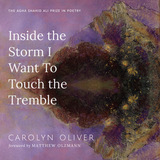 Inside the Storm I Want to Touch the Tremble
Carolyn Oliver
University of Utah Press, 2022 Inside this debut collection, girlhood’s dangers echo, transmuted, in the poet’s fears for her son. A body just discovering the vastness of “want’s new acreage” is humbled by chronic illness. Epithalamion turns elegy. But this world that so often seems capricious in its cruelty also shelters apple orchards, glass museums, schoolchildren, century-old sharks; “there’s no accounting for / all we want to save, no names.”
Oliver’s polyphonic gathering of speakers includes lovers and saints, painters and dead poets, a hawk and a mother. In varied forms (ghazals and prose poems, dialogues and erasures, bref double and Golden Shovel, among others) these poems bear witness to and seek reprieve from disasters at once commonplace and terrifying. “I can’t surface for every scalpel slice, / I need a dreamy estuary present,” she writes.
Stumbling toward joy across time and space, these poems hum with fear and desire, bewildering loss, and love’s lush possibilities.
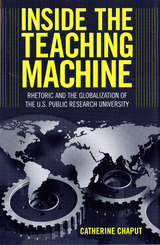 Inside the Teaching Machine: Rhetoric and the Globalization of the U.S. Public Research University
Catherine Chaput
University of Alabama Press, 2008 Advocates of higher education have long contended that universities should operate above the crude material negotiations of economics and politics. Such arguments, ignore the historical reality that the American university system emerged through, and in service to, a capitalist political economy that unevenly combines corporate, state, and civil interests. As the corporatization of U.S. universities becomes nearly impossible to deny, the common response from many academics has been a superior stand against the contamination of the professional ideal by tainted corporate interests. Inside the Teaching Machine proposes a correction to this view through the lens of historical materialism. Chaput argues that the U.S. public research university has always been a vital component of the capitalist political economy. While conventional narratives of public higher education emphasize civic preparation and upward mobility, Chaput demonstrates that supposedly egalitarian policies like the Morrill Land-Grant Act and the G.I. Bill served the changing interests of capitalism much as education, creating a professional class that supports the capitalist political economy. Chaput also focuses on the relationship between American universities and globalization, showing how the trend toward professionalization contributes to the production of surplus value, and the ways that the American university model circulates outside the United States. Chaput concludes by advocating rhetorical strategies for the professional who opposes the capitalist logic of the global university system, proposing concrete options for engaging and redirecting globalization within the university system.
Inside the TV Newsroom: Profession Under Pressure
Line Hassall Thomsen
Intellect Books, 2018 In an era where the way people get news is ever-changing, how do broadcast journalists work? How do changes to the field affect journalists at traditional public broadcasters? And what similarities are there between license-funded news programs—like those on the BBC—and commercial news?
This book, built on years of unique access to the newsrooms of BBC News and ITV News in the United Kingdom and DR TV Avisen and TV2 Nyhedeme in Denmark, answers those questions and more. Exploring the shared professional ideals of journalists, the study analyzes how they conceive of stories as important, and how their ideals relating to their work are expressed and aspired to in everyday practice.
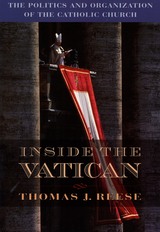 Inside the Vatican: The Politics and Organization of the Catholic Church
Thomas S.J.Reese
Harvard University Press, 1996 There are one billion Catholics in the world today, spread over every continent, speaking almost every conceivable language, and all answering to a single authority. The Vatican is a unique international organization, both in terms of its extraordinary power and influence, and in terms of its endurance. Popes come and go, but the elaborate and complex bureaucracy called the Vatican lives on. For centuries, it has served and sometimes undermined popes; it has been praised and blamed for the actions of the pope and for the state of the church. Yet an objective examination of the workings of the Vatican has been unavailable until now.
Drawing on more than a hundred interviews with Vatican officials, this book affords a firsthand look at the people, the politics, and the organization behind the institution. Reese brings remarkable clarity to the almost Byzantine bureaucracy of congregations, agencies, secretariats, tribunals, nunciature, and offices, showing how they serve the pope and, through him, the universal church. He gives a lively account of how popes are elected and bishops appointed, how dissident theologians are disciplined and civil authorities dealt with. Throughout, revealing and colorful anecdotes from church history and the present day bring the unique culture of the Vatican to life.
The Vatican is a fascinating institution, a model of continuity and adaptation, which remains constant while functioning powerfully in a changing world. As never before, this book provides a clear, objective perspective on how the enormously complex institution surrounding the papacy operates on a day-to-day level, how it has adapted and endured for close to two thousand years, and how it is likely to face the challenges of the next millennium.
 Inside/Outside: A Physician's Journey with Breast Cancer
Janet R. Gilsdorf, M.D.
University of Michigan Press, 2006 To doctors, cancer means cells growing out of control; to patients, cancer means a life spinning out of control. Janet R. Gilsdorf, who writes with quiet but devastating honesty about her experience with breast cancer, offers an eye-opening glimpse, through her unique dual perspective as physician and patient, of both sides of the medical divide.
The medical system delivers cures, answers, and relief from pain to those who seek its help, but it can also offer misinformation, shattered expectations, horrible options, and inhumane consideration of the people it is supposed to serve. As Gilsdorf takes us on a journey across the terrifying landscape of cancer, she discovers that there are oases of unfathomable beauty to be found.
Inside/Outside is compelling, sometimes scary, reading as it puts us inside Gilsdorf’s skin. It ponders a vast array of profound choices most of us will be confronted with in our lives: thinking versus feeling, knowing versus not knowing, hanging on versus letting go, loving versus hating, and the immeasurable territories of life between the poles. Even as it touches on these universal human themes, ultimately Inside/Outside is a story of one person’s courage, hope, and survival in the face of terrifying odds.
Janet R. Gilsdorf, M.D., is Professor of Pediatrics and Communicable Diseases, Division of Infectious Diseases, Medical School, and Professor of Epidemiology, School of Public Health, at the University of Michigan. She is also Director of Pediatric Infectious Diseases, Mott Children's Hospital; Director of the Cell and Molecular Biology in Pediatrics Training Program; and Director of the Haemophilus influenzae Research Laboratory.
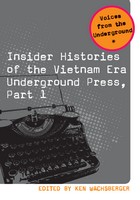 Insider Histories of the Vietnam Era Underground Press, Part 1
Ken Wachsberger
Michigan State University Press, 2011 This enlightening book offers a collection of histories of underground papers from the Vietnam Era as written and told by key staff members of the time. Their stories (as well as those to be included in Part 2, forthcoming) represent a wide range of publications: counterculture, gay, lesbian, feminist, Puerto Rican, Native American, Black, socialist, Southern consciousness, prisoner's rights, New Age, rank-and-file, military, and more. The edition includes forewords by former Chicago Seed editor Abe Peck, radical attorney William M. Kunstler, and Markos Moulitsas, founder of the Daily Kos, along with an introductory essay by Ken Wachsberger.
Wachsberger notes that the underground press not only produce a few well-known papers but also was truly national and diverse in scope. His goal is to capture the essence of "the countercultural community."
A fundamental resource for anyone seeking a deeper understanding of a dramatic era in U.S. history.
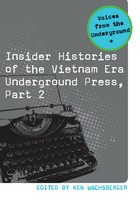 Insider Histories of the Vietnam Era Underground Press, Part 2
Ken Wachsberger
Michigan State University Press, 2011 This enlightening book offers a collection of histories of underground papers from the Vietnam Era as written and told by key staff members of the time. Their stories, building on those presented in Part 1, represent a wide range of publications: countercultural, gay, lesbian, feminist, Puerto Rican, Native American, Black, socialist, Southern consciousness, prisoners’ rights, New Age, rank-and-file, military, and more. Wachsberger notes that the underground press not only produced a few well-known papers but also was truly national and diverse in scope. His goal is to capture the essence of “the countercultural community.” This book will be a fundamental resource for anyone seeking a deeper understanding of a dramatic era in U.S. history, as well as offering a younger readership a glimpse into a generation of idealists who rose up to challenge and improve government and society.
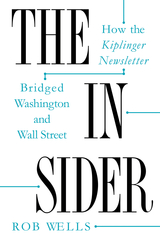 The Insider: How the Kiplinger Newsletter Bridged Washington and Wall Street
Rob Wells
University of Massachusetts Press, 2022 When Willard M. Kiplinger launched the groundbreaking Kiplinger Washington Letter in 1923, he left the sidelines of traditional journalism to strike out on his own. With a specialized knowledge of finance and close connections to top Washington officials, Kiplinger was uniquely positioned to tell deeper truths about the intersections between government and business. With careful reporting and insider access, he delivered perceptive analysis and forecasts of business, economic, and political news to busy business executives, and the newsletter’s readership grew exponentially over the coming decades. More than just a pioneering business journalist, Kiplinger emerged as a quiet but powerful link between the worlds of Presidents Hoover and Roosevelt, and used his Letter to play a little-known but influential role in the New Deal. Part journalism history, part biography, and part democratic chronicle, The Insider offers a well-written and deeply researched portrayal of how Kiplinger not only developed a widely read newsletter that launched a business publishing empire but also how he forged a new role for the journalist as political actor.
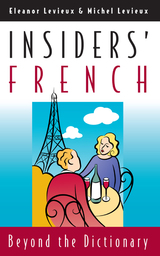 Insiders' French: Beyond the Dictionary
Eleanor Levieux and Michel Levieux
University of Chicago Press, 1999 If you had been living in France in the 1990s, the language you would have heard on the radio and television or seen in the newspapers would be far removed from the French language of ten or twenty years ago. The country and its language have changed tremendously in a relatively short period of time, and, as a result, English speakers with a grounding in French can still find themselves struggling to understand terms commonly encountered in contemporary French society. Luckily, Eleanor and Michel Levieux now bring us up to date with their Insiders' French, an utterly entertaining and informative guide to the language of the "new France."
This "new France" is a country poised to experience the European single currency but uncertain about being part of Europe. It is hooked on fast food but ambivalent about the country where it originated. France today has record unemployment and an increasingly controversial immigrant population. Clearly, given the rapidly changing conditions and lifestyles, conventional French dictionaries alone cannot completely inform readers and visitors. Insiders' French offers a solution to the incomprehension, a unique handbook in which you'll find the language of European union, the space program, abortion and women's rights, high-tech industries, and health care, among other topics. Entries proceed by association of ideas and related terms, with extensive cross-referencing, while still being alphabetized for easy reference like a standard dictionary. Cartoons from major French journals add to your understanding and enjoyment.
Insiders' French opens up the secret territory of French politics and culture that is often not understood by visitors or students, and it does so with wit and verve—qualities that remain in the French language despite its recent changes.
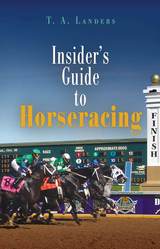 Insider's Guide to Horseracing
T. A. Landers
Westholme Publishing, 2005 Learn What the Experts Know About the “Sport of Kings” With its fast pace, beautiful animals, high stakes, and colorful pageantry, horseracing easily captures the attention of even first-time viewers. While recognizing horseracing as a fascinating sport, most fans know little about this billion-dollar business. Every racehorse and jockey goes through years of training, horses have natural cycles of conditioning, and each track offers its own challenges. Understanding what goes on behind the scenes will make every race more enjoyable profitable for those who wager. Insider’s Guide to Horseracing is a quick and informative tour of the sport from the moment a foal is tapped for training and the kinds of equipment a horse wears to how wagering works and the different types of races. Written by an experienced horse industry professional and fully illustrated, this guide explains what to look for, understanding what you see, making sense of racing columns, and ways to make a trip to the track more memorable, such as visiting the saddling paddock. Here a reader will not find complex or magic formulas for picking winners or dry statistics; instead the Insider’s Guide to Horseracing gives readers exact information from an expert that will add to the excitement of racing and will allow readers to make better informed decisions all. “An excellent book.”—Horse-Races.net “Landers drew upon his longtime experience in various phases of the horse industry to produce this fan-oriented book, which he says is intended to ‘educate people on the workings of a racetrack and what goes on behind the scenes.’ It was inspired by the many questions he has been asked over the years.”—N.Y. Thoroughbred Horseman’s Association Newsletter Contents:
1. A brief history of the sport
2. What to look for in a horse
3. How to read track conditions
4. Understanding distance
5. Types of wagering, races, and handicapping
6. The jockey and trainer
7. Ownership
8. Information on major races and racetracks in North America
 Insiders, Outliers: Centering Adult Student Writers at an HBCU
Collie Fulford
Rutgers University Press, 2025 Insiders, Outliers invites readers into the lives of adult HBCU students for whom college is one meaningful activity among many. Although adults over the age of twenty-four comprise a quarter of all undergraduates, they are institutionally segregated and only partially served by a US higher education system that remains organized around traditional-aged learners. Even as such students are regarded as a market for postsecondary institutions, they are routinely marginalized by institutional barriers. Students’ stories of their personal, professional, community, and academic writing experiences illuminate a critical need for more age-inclusive practices across academia. Their cases also offer new conceptual models of writing as an ethical and emotional practice that fuels changes for individuals and the people and institutions that they care about—including higher education. What adult students reveal about writing across their life domains has powerful implications for conceptualizing writing as a complex form of agency and for teaching writing across the curriculum.
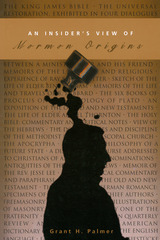 An Insider's View of Mormon Origins
Grant Palmer
Signature Books, 2002 Over the past thirty years, an enormous amount of research has been conducted into Mormon origins—Joseph Smith’s early life, the Book of Mormon, the prophet’s visions, and the restoration of priesthood authority. Longtime LDS educator Grant H. Palmer suggests that most Latter-day Saints remain unaware of the significance of these discoveries, and he gives a brief survey for anyone who has ever wanted to know more about these issues. He finds that much of what we take for granted as literal history has been tailored over the years—slightly modified, added to, one aspect emphasized over another—to the point that the original narratives have been nearly lost. What was experienced as a spiritual or metaphysical event, something from a different dimension, often has been refashioned as if it were a physical, objective occurrence. This is not how the first Saints interpreted these events. Historians who have looked closer at the foundational stories and source documents have restored elements, including a nineteenth-century world view, that have been misunderstood, if not forgotten.
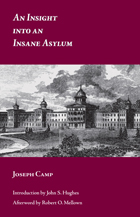 An Insight into an Insane Asylum
Joseph Camp
University of Alabama Press, 2011 In 1881, Joseph Camp, an elderly and self-trained Methodist minister from TalladegaCounty in eastern Alabama, was brought by his family to BryceHospital, an insane asylum in Tuscaloosa, where he remained for over five months. Camp, misled by relatives concerning the purpose of the trip, was shocked and angered at his loss of freedom and his treatment in the hospital. After his release, he composed an account of his stay and published it at his own expense, providing a rare glimpse of 19th century mental health care from a patient’s viewpoint. Camp’s account reveals his naive trust in others, but also a sharp and retentive memory. Camp is remarkably accurate in his account of the details of his treatment and the operation and staff of the hospital, although his emotional assessments reflect his unhappiness with his situation. Adding to the importance of Camp’s account is the fact that in the 19th century Bryce was considered a remarkably humane institution focused on recovery. Camp provides a glimpse into how treatment for the insane felt to the recipient.
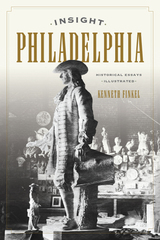 Insight Philadelphia: Historical Essays Illustrated
Finkel, Kenneth
Rutgers University Press, 2018 Each of the nearly 100 essays in Insight Philadelphia tells a succinct, compelling, and little-known tale of the city’s past. Some stories are quirky, like how early gas stations were designed to resemble classical temples, or the saga of how a museum acquired a 2000-year-old Greek statue, then had it demolished with a sledgehammer. Other stories turn serious, exploring the tragic deaths of child laborers in the city’s textile mills and a century-old case of racial profiling that led to a stationhouse murder. Historian Kenneth Finkel introduces readers to the many brave souls and colorful characters who left their mark on the city, from the Irish immigrant “coal heavers”—who initiated the nation’s first general strike—to the teenage Josephine Baker making a flashy debut on the Philadelphia stage.
Illustrated with scores of rare archival images, Insight Philadelphia will give readers a new appreciation for the people and places that make the City of Brotherly Love so unique.
 Insights in Applied Theatre: The Early Days and Onwards
Edited by John O'Toole, Penny Bundy, and Peter O'Connor
Intellect Books, 2023 Revelations about the theatrical practice and its evolution.
Insights in Applied Theatre offers an inside look into the advent of applied theater and its development as an area of practice and research. Much more than an archive, the texts in this collection present vivid, pertinent voices and messages from the pioneers of applied theater. The nineteen articles chosen by the editors of Applied Theatre Research represent key themes and elements from the start of the practice. The articles—many of which were influential in their own time—have much to say to the contemporary scene. They have been arranged in sections according to key themes and issues discovered, investigated, and stumbled across by the trailblazing writers in the collection. A vital new contribution to the field, the book raises questions about the contested issues of power, partnerships, and voice in applied theater.
 Insights in Decision Making: A Tribute to Hillel J. Einhorn
Edited by Robin M. Hogarth
University of Chicago Press, 1990 How do people make decisions? How can we help people make better decisions? How can we best study the processes of decision making? The growing field of behavioral decision research, which seeks to link observed decision behavior to underlying psychological mechanisms, may provide the answers to these questions.
The volume is based on a recent conference held to honor the work and memory of the late Hillel J. Einhorn, a pioneering scholar in behavioral decision research. Composed of contributions by leading researchers, Insights in Decision Making provides a state-of-the-art image of work in this field.
The range of topics covered includes conceptual and technical issues the bridge the gap between theory and the practical concern of improving decision making, difficulties in statistical thinking, experimental studies of processes of judgment and choice, and the emergence of new paradigms for studying decision behavior.
Providing many avenues for future research, Insights in Decision Making will be essential reading for students of the psychology of decision making and will prove valuable to readers in psychology, economics, statistics, and management.
 Insights in the Economics of Aging
Edited by David A. Wise
University of Chicago Press, 2017 The fraction of the population over age sixty-five in many developed countries is projected to rise, in some cases sharply, in coming decades. This has drawn growing interest to research on the health and economic circumstances of individuals as they age. Many individuals are retiring from paid work, yet they are living longer than ever. Their well-being is shaped by their past decisions such as their saving behavior, as well as by current and future economic conditions, health status, medical innovations, and a rapidly evolving landscape of policy incentives and supports.
The contributions to Insights in the Economics of Aging uncover how financial, physical, and emotional well-being are integrally related. The authors consider the interactions between financial circumstances in later life, such as household savings and home ownership, physical circumstances such as health and disability, and emotional well-being, including happiness and mental health.
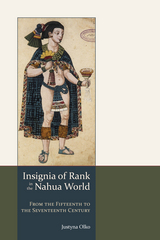 Insignia of Rank in the Nahua World: From the Fifteenth to the Seventeenth Century
Justyna Olko
University Press of Colorado, 2014 This significant work reconstructs the repertory of insignia of rank and the contexts and symbolic meanings of their use, along with their original terminology, among the Nahuatl-speaking communities of Mesoamerica from the fifteenth through the seventeenth centuries. Attributes of rank carried profound symbolic meaning, encoding subtle messages about political and social status, ethnic and gender identity, regional origin, individual and community history, and claims to privilege.
Olko engages with and builds upon extensive worldwide scholarship and skillfully illuminates this complex topic, creating a vital contribution to the fields of pre-Columbian and colonial Mexican studies. It is the first book to integrate pre- and post-contact perspectives, uniting concepts and epochs usually studied separately. A wealth of illustrations accompanies the contextual analysis and provides essential depth to this critical work. Insignia of Rank in the Nahua World substantially expands and elaborates on the themes of Olko's Turquoise Diadems and Staffs of Office, originally published in Poland and never released in North America.
An Insignificant Family
Da Ngan
Northwestern University Press, 2009 Beginning in Vietnam shortly after the end of the American war and ending sometime in the 21st century, this 8th volume of Curbstone's Voices from Vietnam Series follows the life of Nguyen Thi My Tiep, a woman writer and a revolutionary, whose girlhood is spent as a guerrilla fighter, and whose post-war life becomes a search for personal liberation and individual love. Tiep's struggles are seamlessly connected to the changes her country is going through, as Da Ngan's daring and controversial novel draws us into the life of a woman who insists on leading a meaningful and honest life—as a citizen, as a daughter, as a mother, as a writer, and as a lover who pursues her own sexuality.
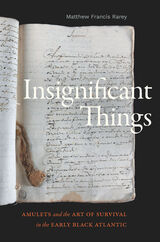 Insignificant Things: Amulets and the Art of Survival in the Early Black Atlantic
Matthew Francis Rarey
Duke University Press, 2023 In Insignificant Things Matthew Francis Rarey traces the history of the African-associated amulets that enslaved and other marginalized people carried as tools of survival in the Black Atlantic world from the seventeenth to the nineteenth centuries. Often considered visually benign by white Europeans, these amulet pouches, commonly known as “mandingas,” were used across Africa, Brazil, and Portugal and contained myriad objects, from herbs and Islamic prayers to shells and coins. Drawing on Arabic-language narratives from the West African Sahel, the archives of the Portuguese Inquisition, sixteenth- and seventeenth-century European travel and merchant accounts of the West African Coast, and early nineteenth-century Brazilian police records, Rarey shows how mandingas functioned as portable archives of their makers’ experiences of enslavement, displacement, and diaspora. He presents them as examples of the visual culture of enslavement and critical to conceptualizing Black Atlantic art history. Ultimately, Rarey looks to the archives of transatlantic slavery, which were meant to erase Black life, for objects like the mandingas that were created to protect it.
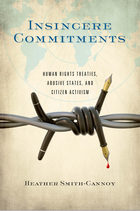 Insincere Commitments: Human Rights Treaties, Abusive States, and Citizen Activism
Heather Smith-Cannoy
Georgetown University Press, 2012 Paradoxically, many governments that persistently violate human rights have also ratified international human rights treaties that empower their citizens to file grievances against them at the United Nations. Therefore, citizens in rights-repressing regimes find themselves with the potentially invaluable opportunity to challenge their government’s abuses. Why would rights-violating governments ratify these treaties and thus afford their citizens this right? Can the mechanisms provided in these treaties actually help promote positive changes in human rights? Insincere Commitments uses both quantitative and qualitative analysis to examine the factors contributing to commitment and compliance among post-Soviet states such as Slovakia, Hungary, Kyrgyzstan, and Tajikistan. Heather Smith-Cannoy argues that governments ratify these treaties insincerely in response to domestic economic pressures. Signing the treaties is a way to at least temporarily keep critics of their human rights record at bay while they secure international economic assistance or more favorable trade terms. However, she finds that through the specific protocols in the treaties that grant individuals the right to petition the UN, even the most insincere state commitments to human rights can give previously powerless individuals—and the nongovernmental and intergovernmental organizations that partner with them—an important opportunity that they would otherwise not have to challenge patterns of government repression on the global stage. This insightful book will be of interest to human rights scholars, students, and practitioners, as well as anyone interested in the UN, international relations, treaties, and governance.
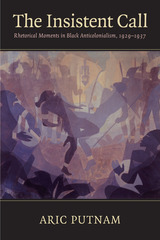 The Insistent Call: Rhetorical Moments in Black Anticolonialism, 1929-1937
Aric Putnam
University of Massachusetts Press, 2012 Throughout the nineteenth century, African heritage played an important role in black America, as personal memories and cultural practices continued to shape the everyday experience of people of African descent living under the shadow of slavery. Resisting efforts to de-Africanize their values, customs, and beliefs, black Americans invoked their African roots in public arguments about their identity and place in the "new" world. At the outset of the twentieth century many still saw Africa primarily as the source of a common cultural and spiritual past. But after the 1920s, the meaning of African heritage changed as people of African descent expressed new relationships between themselves, the United States, and the African Diaspora.
In The Insistent Call, Aric Putnam studies the rhetoric of newspapers, literature, and political pamphlets that expressed this shift. He demonstrates that as people of African descent debated the United States' occupation of Haiti, the Liberian labor crisis, and the Italian invasion of Ethiopia, they formed a new collective identity, one that understood the African Diaspora in primarily political rather than cultural terms. In addition to uncovering a neglected period in the history of black rhetoric, Putnam shows how rhetoric that articulates the interests of a population not defined by the boundaries of a state can still motivate collective action and influence policies.
Insomnia Diary
Bob Hicok
University of Pittsburgh Press, 2004
“The most potent ingredient in virtually every one of Bob Hicok’s compact, well-turned poems is a laughter as old as humanity itself, a sweet waggery that suggests there’s almost no problem that can’t be solved by this poet’s gentle humor.”
—New York Times Book Review
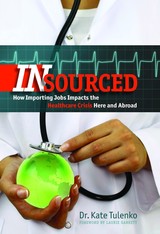 Insourced: How Importing Jobs Impacts the Healthcare Crisis Here and Abroad
Dr. Kate Tulenko
Dartmouth College Press, 2012 For years, opponents of outsourcing have argued that offshoring American jobs destroys our local industries, lays waste to American job creation, and gives foreigners the good jobs and income that would otherwise remain on our shores. Yet few Americans realize that a parallel dynamic is occurring in the healthcare sector—previously one of the most consistent sources of stable, dependable living-wage jobs in the entire nation. Instead of outsourcing high-paying jobs overseas—as the manufacturing and service sectors do—hospitals and other healthcare companies insource healthcare labor from developing countries, giving the jobs to people who are willing to accept lower pay and worse working conditions than U.S. healthcare workers. As Dr. Tulenko shows, insourcing has caused tens of thousands of high-paying local jobs in the healthcare sector to effectively vanish from the reach of U.S. citizens, weakened the healthcare systems of developing nations, and constricted the U.S. health professional education system. She warns Americans about what she’s seeing—a stunning story they’re scarcely aware of, which impacts all of us directly and measurably—and describes how to create better American health professional education, more high-paying healthcare jobs, and improved health for the poor in the developing world.
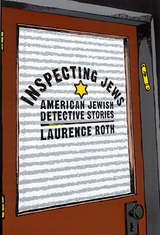 Inspecting Jews: American Jewish Detective Stories
Roth, Laurence
Rutgers University Press, 2003 Inthis book, Laurence Roth argues that the popular genre of Jewish detective stories offers new insights into the construction of ethnic and religious identity. Roth frames his study with the concept of “kosher hybridity” to look at the complex process of mediation between Jewish and American culture in which Jewish writers voice the desire to be both different from and yet the same as other Americans. He argues that the detective story, located at the intersection of narrative and popular culture in modern America, examines the need for order in a disorderly society, and thus offers a window into the negotiation of Jewish identity differing from that of literary fiction. The writers of these popular cultural texts, which are informed by contradiction and which thrive on intended and unintended ironies, formulate idioms for American Jewish identities that intentionally and unintentionally create social, ethnic, and religious syntheses in American Jewish life. Roth examines stories about American Jewish detectives—including Harry Kemelman’s Rabbi Small, Faye Kellerman’s Peter Decker and Rina Lazarus, Stuart Kaminsky’s Abe Lieberman, and Rochelle Krich’s Jessica Drake—not only as a genre of literature but also as a reflection of contemporary acculturation in the American Jewish popular arts.
The Inspector Barlach Mysteries: The Judge and His Hangman and Suspicion
Friedrich Dürrenmatt
University of Chicago Press, 2006 This volume offers bracing new translations of two precursors to the modern detective novel by Friedrich Dürrenmatt, whose genre-bending mysteries recall the work of Alain Robbe-Grillet and anticipate the postmodern fictions of Paul Auster and other contemporary neo-noir novelists. Both mysteries follow Inspector Barlach as he moves through worlds in which the distinction between crime and justice seems to have vanished. In The Judge and His Hangman, Barlach forgoes the arrest of a murderer in order to manipulate him into killing another, more elusive criminal. And in Suspicion, Barlach pursues a former Nazi doctor by checking into his clinic with the hope of forcing him to reveal himself. The result is two thrillers that bring existential philosophy and the detective genre into dazzling convergence.
Inspectors-General: Junkyard Dogs or Man's Best Friend?
Mark Moore
Russell Sage Foundation, 1986 In 1978, determined to combat fraud, waste, and abuse in government programs, Congress overwhelmingly approved the creation of special Offices of Inspectors-General (OIGs) in many federal departments. Moore and Gates here provide the first evaluation of this important institutional innovation. Clearly and objectively, they examine the powerful but often imprecisely defined concepts—wastefulness, accountability, performance—that underlie the OIG mandate. Their study conveys a realistic sense of how these offices operate and how their impact is affected by the changing dynamics of politics and personality. A Volume in the Russell Sage Foundation's Social Science Perspectives Series
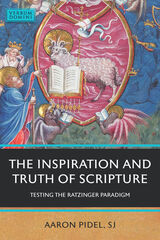 The Inspiration and Truth of Scripture: Testing the Ratzinger Paradigm
Aaron Pidel, SJ
Catholic University of America Press, 2023 What does it mean to say that Scripture is God’s Word? And just how true is the Bible? Though sometimes dismissed as “fundamentalist” concerns, these questions also sent twentieth-century Catholic theology searching for a new paradigm of biblical inspiration. Theologians repeatedly attempted to reconcile the traditional conviction that the Bible shares in the omniscience of its divine author with scholarly findings that suggested otherwise. Joseph Ratzinger contributed both negatively and positively to this project, deconstructing the regnant manualist models of inspiration and constructing an alternative inspired by St. Bonaventure. The result is an ecclesial model of surprising comprehensiveness and balance. Indeed, The Inspiration and Truth of Scripture concludes that Ratzinger’s alternative provides the least inadequate paradigm currently on offer today.
The Inspiration and Truth of Scripture breaks new ground in several ways. First, it situates Ratzinger within a broader Catholic quest for a theology of inspiration, showing his model offers advantages even relative to those proposed by modern theology’s most eminent minds: John Henry Newman, Pierre Benoit, Karl Rahner, and David Tracy. Secondly, this book shows how Ratzinger’s paradigm generates “tests” for identifying the perennially valid affirmations of Scripture, and thus an approach to resolving disputed biblical questions. Must one who accepts the authority of Scripture believe in the Devil? Are the Marian dogmas really “in” Scripture? To what extent does Jesus’s prohibition of divorce still apply in today’s changed social circumstances? Just how historical are Gospel narratives, like the Last Supper, intended to be? The result is a book that bridges the gap between normative theology and historical exegesis.
Overall, The Inspiration and Truth of Scripture presents Ratzinger not as an unimaginative enforcer of doctrinal conclusions but as a creatively faithful theologian, whose reconfiguration of inspiration should serve as the point of departure for all future reflection on the subject.
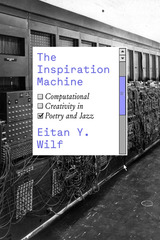 The Inspiration Machine: Computational Creativity in Poetry and Jazz
Eitan Y. Wilf
University of Chicago Press, 2023 Explores how creative digital technologies and artificial intelligence are embedded in culture and society.
In The Inspiration Machine, Eitan Y. Wilf explores the transformative potentials that digital technology opens up for creative practice through three ethnographic cases, two with jazz musicians and one with a group of poets. At times dissatisfied with the limitations of human creativity, these artists do not turn to computerized algorithms merely to execute their preconceived ideas. Rather, they approach them as creative partners, delegating to them different degrees of agentive control and artistic decision-making in the hopes of finding inspiration in their output and thereby expanding their own creative horizons.
The algorithms these artists develop and use, however, remain rooted in and haunted by the specific social predicaments and human shortfalls that they were intended to overcome. Experiments in the digital thus hold an important lesson: although Wilf’s interlocutors returned from their adventures with computational creativity with modified, novel, and enriched capacities and predilections, they also gained a renewed appreciation for, and at times a desire to re-inhabit, non-digital creativity. In examining the potentials and pitfalls of seemingly autonomous digital technologies in the realm of art, Wilf shows that computational solutions to the real or imagined insufficiencies of human practice are best developed in relation to, rather than away from, the social and cultural contexts that gave rise to those insufficiencies, in the first place.
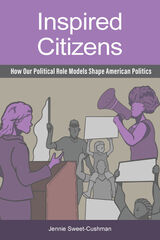 Inspired Citizens: How Our Political Role Models Shape American Politics
Jennie Sweet-Cushman
Temple University Press, 2024 Political role models are people that voters form a connection with, and who provoke them to think differently about and engage with politics. Inspired Citizens examines the impact role models have in American politics through the lens of political psychology. Jennie Sweet-Cushman investigates how citizens, especially marginalized ones, can be influenced by the presence of political role models. She asks critical questions: Do role models increase political participation and strengthen American democracy? Do role models encourage candidate emergence?
Sweet-Cushman develops Inspired Citizenship Theory to show that political role models can have motivating effects on one’s political citizenship and may, in some case, insulate those who have been traditionally marginalized in American politics. Moreover, she asserts that citizens who have political role models possess very different political behaviors and attitudes than those who do not.
Inspired Citizens also considers the often-conflicting pressures and messages political role models project to citizens. Sweet-Cushman posits that role models inspire political action most effectively when they fulfill highly individualized expectations for role model identity, spurring deeper connection and a desire to emulate.
Inspired Citizens strengthens our understanding of what we should (and should not) look to political figures for in guiding democratic behaviors and inspiring productive citizenship.
|
|



